Paul van Yperen's Blog, page 110
October 2, 2022
Brigitte Helm
We're in Pordenone, Italy, for Le Giornate del Cinema Muto. One of the sections is 'The Canon Revisited' and the highlight for us is Manolescu - Der König der Hochstapler/Manolescu, the Prince of Adventures (Viktor Tourjansky, 1929) with Ivan Mozzhukhin. Female star is the sophisticated German actress Brigitte Helm (1906-1996). She is a legend because of her dual role as the noble Maria and as her evil double, the hypersexed robot Maria in Metropolis (Fritz Lang, 1927). After her debut in this silent science-fiction classic, she starred in over 30 films in which she often portrayed a cool, unobtainable vamp. Helm easily made the transition to sound film, but in 1935 she suddenly retired.
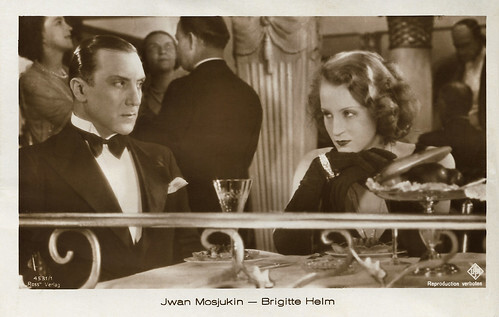
German postcard by Ross Verlag, no. 4531/1. Photo: Ufa. Ivan Mozzhukhin and Brigitte Helm in Manolescu - Der König der Hochstapler/Manolescu, the Prince of Adventures (Viktor Tourjansky, 1929).
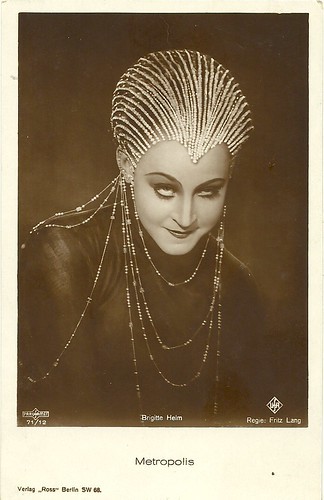
German postcard by Ross Verlag, Berlin, no. 71/12. Photo: Ufa / Parufamet. Brigitte Helm in Metropolis (Fritz Lang, 1927). Collection: Didier Hanson.
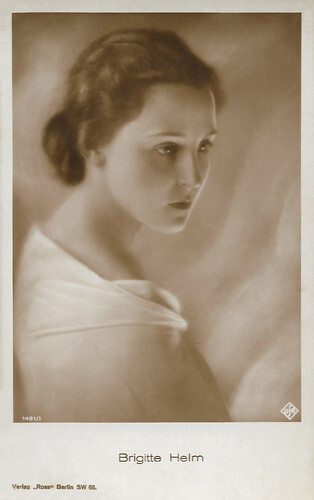
German postcard by Ross Verlag, no. 1481/1, 1927-1928. Photo: Ufa.
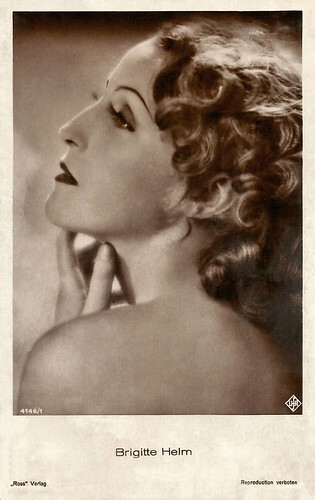
German postcard by Ross Verlag, no. 4146/1, 1929-1930. Photo: Ufa.
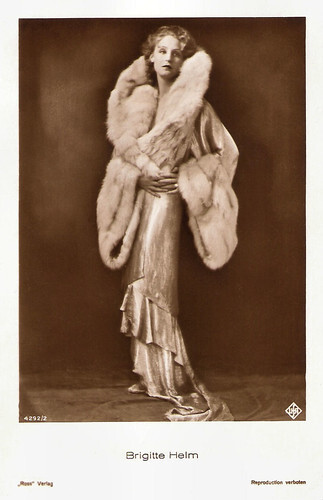
German postcard by Ross Verlag, no. 4292/2, 1929-1930. Photo: Ufa.
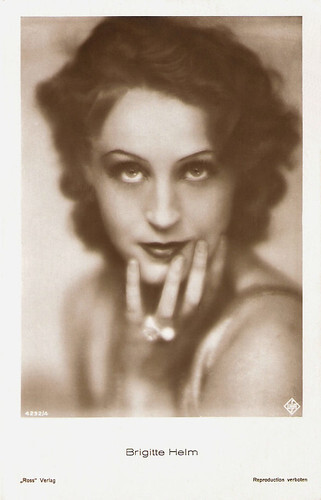
German postcard by Ross Verlag, no. 4292/4, 1929-1930. Photo: Ufa.
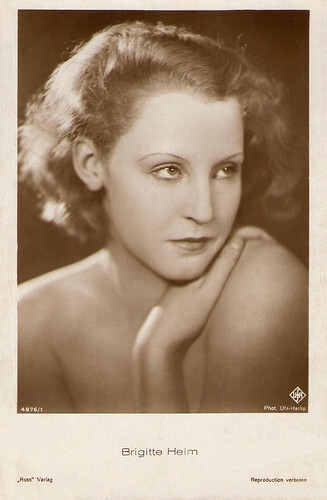
German postcard by Ross Verlag, no. 4876/1, 1929-1930. Photo: Ufa-Harlip.
Metropolis
Brigitte Helm was born as Brigitte Eva Gisela Schittenhelm in Berlin, Germany, in 1906 (some sources say 1908). Her father was a Prussian army officer, who left his wife a widow not long after.
Brigitte gained her acting experience in school productions but never thought of acting classes. After her school exams, she wanted to be an astronomer. But then she was discovered by the famous director Fritz Lang for the lead in Metropolis (Fritz Lang, 1927), then the most expensive German film ever made.
Her mother had sent a photograph of her beautiful 16-years-old daughter to Lang's wife, scriptwriter Thea von Harbou. Helm was invited to the set of Die Nibelungen and was given a screen test. She got the double role of the noble and virginal Maria and her evil and sensual twin, the Maschinenmensch, a robot created to urge the workers in revolting and destroying their own city.
In their 1996 obituary in The New York Times, Robert McThomas and Peter Herzog note: "The film depicts the world of 2006, a time, Lang envisioned, when a ruling class lives in decadent luxury in the loft heights of skyscrapers linked by aerial railways, while beneath the streets slave-like workers toll in unbearable conditions to sustain their masters.
But for all the steam and special effects, for many who have seen the movie in it various incarnations, including a tinted version and one accompanied by music, the most compelling lingering image is neither the towers above nor the hellish factories below. It is the staring transformation of Ms. Helm from an idealistic young woman into a barely clad creature performing a lascivious dance in a brothel." Metropolis made Brigitte Helm a star overnight.

German postcard by Ross Verlag, no. 71/6. Photo: Parufamet / Ufa. Rudolf Klein-Rogge and Brigitte Helm in Metropolis (Fritz Lang, 1926). Collection: Marlene Pilaete.
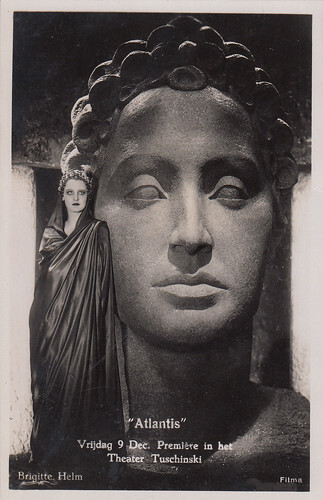
Dutch postcard by Filma. Brigitte Helm in Die Herrin von Atlantis/Lost Atlantis (Georg Wilhelm Pabst, 1932). Caption: Friday 6 December Premiere at the Tuschinski Theatre. Collection: Marlene Pilaete.
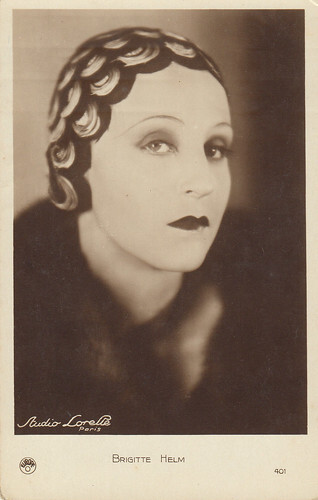
French postcard by Europe, no. 401. Photo: Studio Lorelle, Paris. Brigitte Helm in L'Argent/The Money (Marcel L’ Herbier, 1928). Collection: Marlene Pilaete.
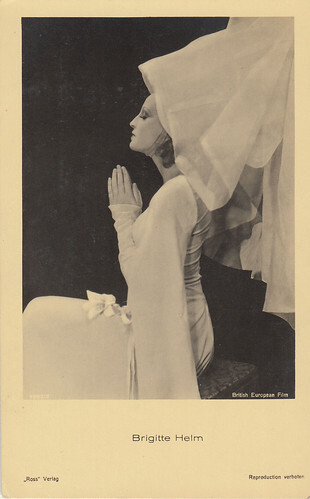
German postcard by Ross Verlag, no. 7882/1, 1932-1933. Photo: British European Film. Brigitte Helm in The Blue Danube (Herbert Wilcox, 1931). Collection: Marlene Pilaete.
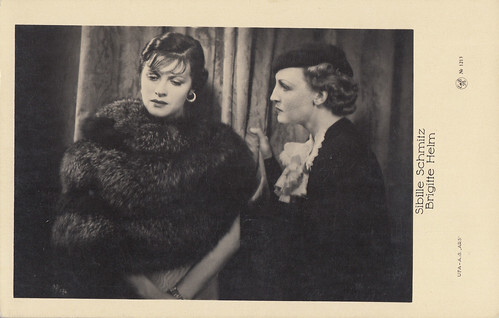
Latvian postcard by EMBR, no. 1213. Photo: Ufa. Brigitte Helm and Sybille Schmitz in Ein idealer Gatte/An Ideal Husband (Herbert Selpin, 1935). Collection: Marlene Pilaete.
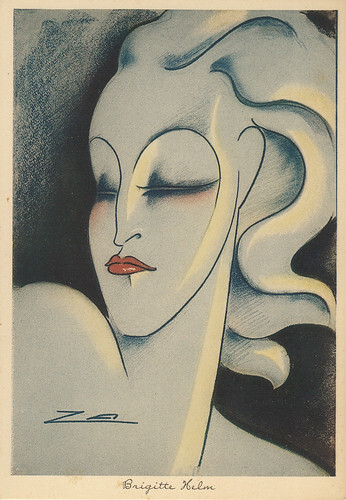
Italian postcard by Eliocromia Zacchetti e C. Milano, no. A57. Brigitte Helm by Nino Za. Collection: Marlene Pilaete.
Ice Queen
UFA gave Brigitte Helm a contract, and over the next 10 years, she acted in 29 German, French, and English films.
She was cast as the evil but oh so seductive protagonist in the Sci-Fi-horror film Alraune. First in the silent version of 1928, directed by Henrik Galeen.
Hal Erickson at AllMovie: "Hanns Heinz Ewers' grim science-fiction novel 'Alraune' has already been filmed twice when this version was assembled in 1928. In another of his 'mad doctor' roles, Paul Wegener plays Professor Brinken, the sociopathic scientist who combines the genes of an executed murderer with those of a prostitute.
The result is a beautiful young woman named Alraune (Brigitte Helm), who is incapable of feeling any real emotions - least of all guilt or regret. Upon attaining adulthood, Alraune sets about to seduce and destroy every male who crosses her path. Ultimately, Professor Brinken is hoist on his own petard when he falls hopelessly in love with Alraune himself."
Two years later Helm also starred in the sound version, Alraune/A Daughter of Destiny (Richard Oswald, 1930), for which the Dutch postcard lower in this post was made.
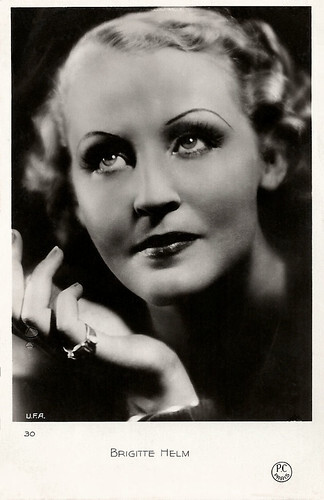
French postcard by P.C. Paris, no. 30. Photo: Ufa.
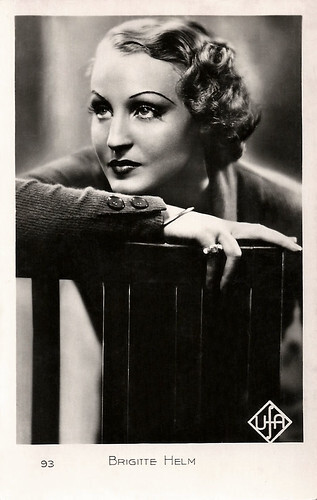
French postcard, no. 93. Photo: Ufa.
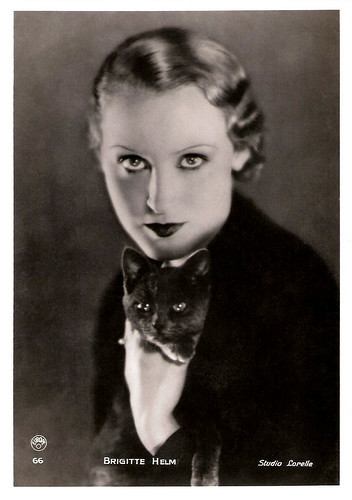
French postcard by Cine-Europe, no. 66. Photo: Studio Lorelle.
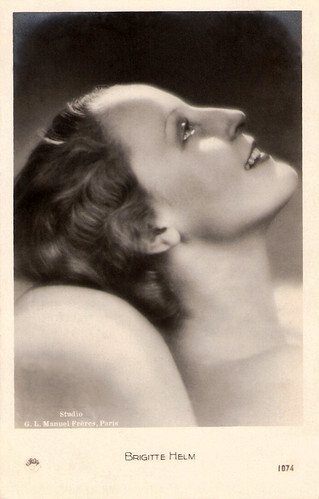
French postcard by Cine-Europe, no. 1074. Photo: Studio G.L. Manuel Frères, Paris.
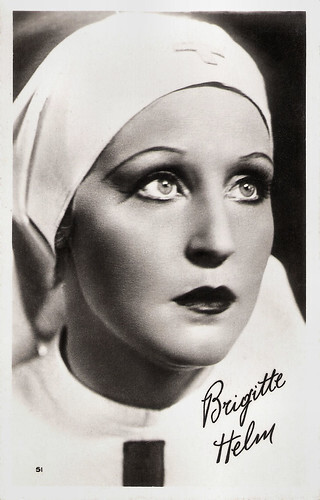
French postcard, no. 51. Brigitte Helm in Spione am Werk/Spies at Work (Gerhard Lamprecht, 1933).
Mysterious Adaptability
Brigitte Helm played a helpless blind woman who is seduced by a rogue in the wartime melodrama Die Liebe der Jeanne Ney/The Love of Jeanne Ney (G.W. Pabst, 1927).
It was Brigitte Helm's first project with Georg Wilhelm Pabst, the director who could - better than any other director - bring out her mysterious adaptability. In his films Abwege/The Devious Path (1928) and L’Atlantide/Die Herrin von Atlantis/Queen of Atlantis (1932) she proved that she could perform more restrained and emotionally expressive characters.
In Abwege, she portrays a spoilt woman of the world who from sheer boredom almost destroys her own life. In L'Atlantide (1932), Helm plays a goddess, the mere sight of whom makes men crazy.
Werner Sudendorff wrote in his obituary of Helm in The Independent: "Her power is not of this world, but incomprehensible, magical. This was Helm's last really great role, a legendary mysterious sphinx of the German cinema."
These films and Marcel L'Herbier's late silent film L'Argent/The Money (Marcel L’ Herbier, 1928) allowed Helm to act outside the tired cliches she was later often subjected to by scriptwriters and producers.
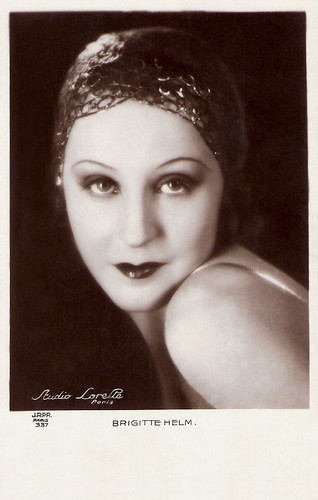
French postcard by JRPR, Paris, no. 337. Photo: Studio Lorelle (Lucien Lorelle), Paris. Brigitte Helm in L'Argent/The Money (Marcel L'Herbier, 1928).

French postcard by JRPR, Paris, no. 338. Photo: Studio Lorelle, Paris. Publicity still for L'Argent/The Money (1928).

French postcard by Cine-Europe, no. 339. Photo: Studio Lorelle. Publicity still for L'Argent/The Money (1928).
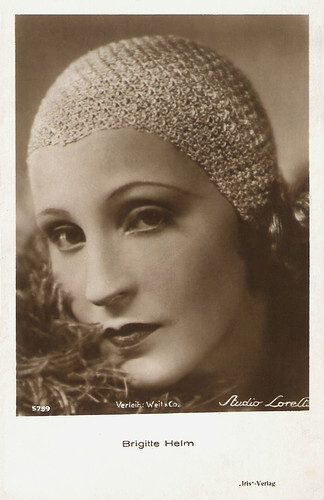
Austrian postcard by Iris-Verlag, no. 5789. Photo: Studio Lorelle, Paris / Verleih Weil & Co. Publicity still for L'Argent/The Money (1928).
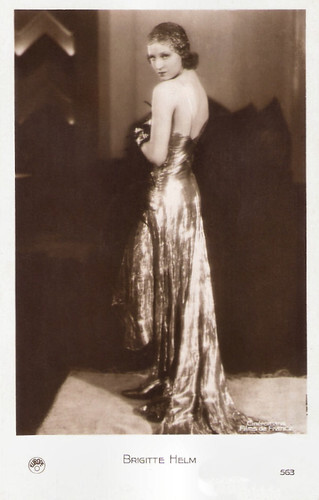
French postcard by Europe, no. 563. Photo: Cinéromans Films de France. Brigitte Helm in L'argent/The Money (Marcel L'Herbier, 1928), freely adapted from the novel by Emile Zola.
Restricting Clauses
Brigitte Helm's first sound film was the musical Die singende Stadt/City of Song (Carmine Gallone, 1930) with Jan Kiepura . She also appeared in the French and English versions of her German films.
Werner Sudendorff: "In her films of the early 1930s Brigitte Helm became the embodiment of the down-to-earth, affluent modern woman. With her slim figure and austere pre-Raphaelite profile, she seems unapproachable, a model fashion-conscious woman, under whose ice-cold outer appearance criminal energies flicker."
However, her sound films, like Gloria (Hans Behrendt, 1931), The Blue Danube (Herbert Wilcox, 1932), and Gold/L’Or (Karl Hartl, 1934), do not have the artistic cachet of her best silent films.
Her relationship with the Ufa happened to be very rocky. While the studio had made her a star and kept increasing her pay, the actress was unhappy with the material the Ufa offered her and she was annoyed about the restrictive clauses dictating her weight.
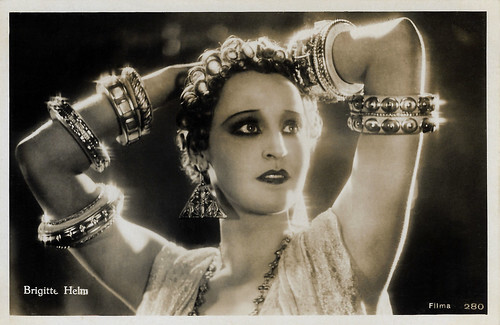
Dutch postcard by Filma, no. 280. Brigitte Helm in L'Atlantide/Die Herrin von Atlantis/Lost Atlantis (Georg Wilhelm Pabst, 1932).
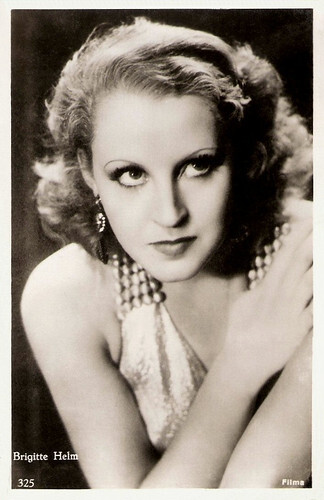
Dutch postcard by Filma, no. 325.
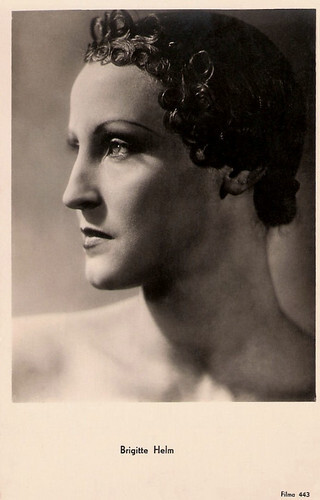
Dutch postcard by Filma, no. 443. Photo: publicity still for L’Atlantide/Queen of Atlantis (1932).
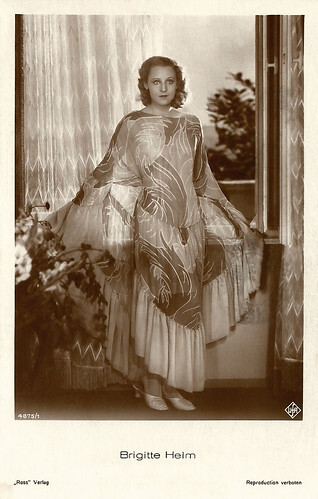
German postcard by Ross Verlag, no. 4875/1, 1929-1930. Photo: Ufa.
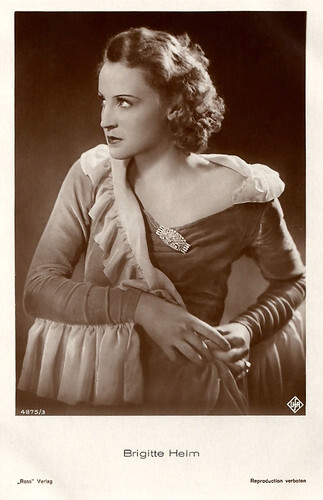
German postcard by Ross Verlag, no. 4875/3, 1929-1930. Photo: Ufa.
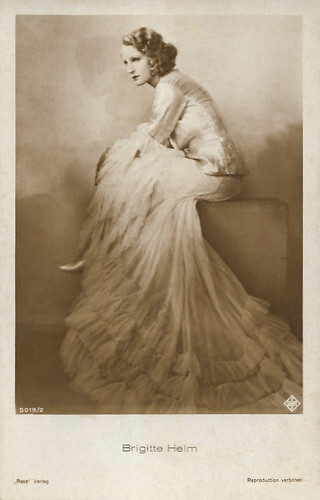
German postcard by Ross Verlag, no. 5019/2, 1930-1931. Photo: Ufa.
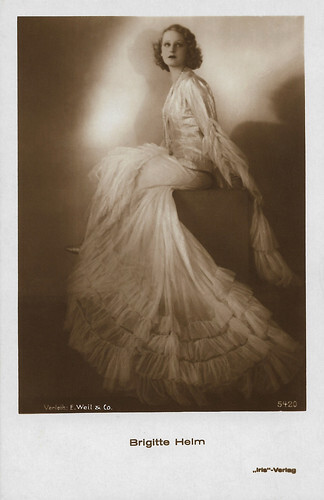
Austrian postcard by Iris Verlag, no. 5420. Photo: Verleih E. Weil & Co.
Blue Angel
Reportedly Brigitte Helm was Josef Von Sternberg's original choice for the starring role of Der Blaue Engel/The Blue Angel (1930), but the part went to Marlene Dietrich .
Helm was also James Whale's first choice for his Bride of Frankenstein (1935), but reportedly she refused to go to America.
In 1935, angered by the Nazi control of the German film industry, she didn’t extend her contract with the Ufa. Perhaps another reason for her decision were the negative press reports about her many traffic accidents and the short prison sentence as a result of it.
Her last film was Ein Idealer Gatte/An Ideal Husband (Herbert Selpin, 1935), an adaptation of the play by Oscar Wilde.
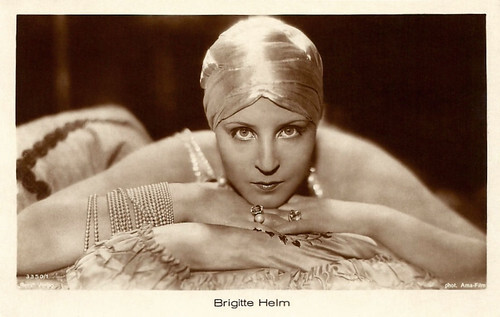
German postcard by Ross Verlag, no. 3350/1, 1928-1929. Photo: Ams-Film.
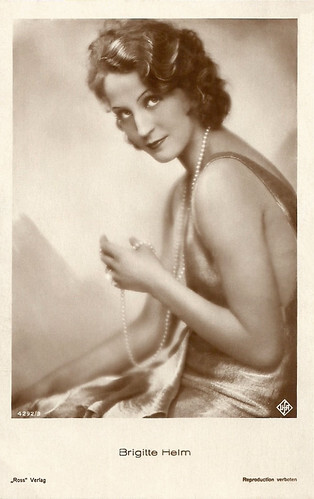
German postcard by Ross Verlag, no. 4292/3, 1929-1930. Photo: Ufa.
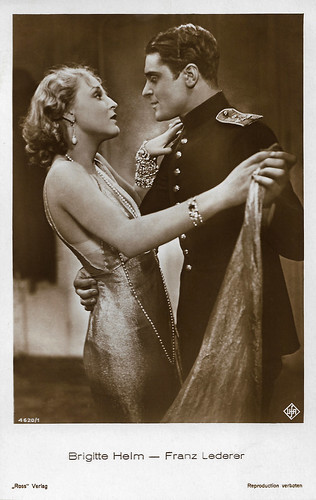
German postcard by Ross Verlag, no. 4620/1, 1929-1930. Photo: Ufa. Brigitte Helm and Franz Lederer in Die wunderbare Lüge der Nina Petrowna/The Wonderful Lies of Nina Petrovna (Hanns Schwarz, 1929).
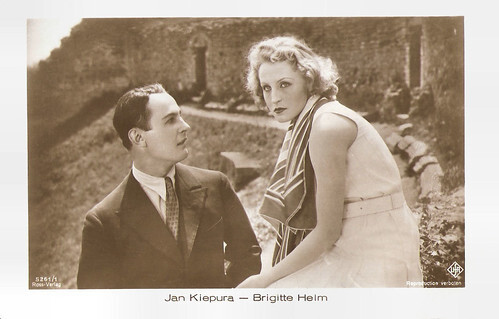
German postcard by Ross Verlag, no. 5261/1, 1930-1931. Photo: Ufa. Jan Kiepura and Brigitte Helm in Die singende Stadt/The Singing City (Carmine Gallone, 1930).
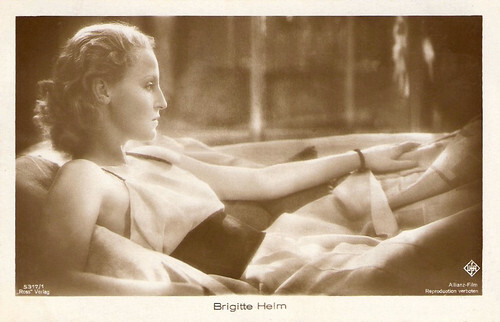
German postcard by Ross Verlag, no. 5317/1, 1930-1931. Photo: Allianz Film / Ufa.
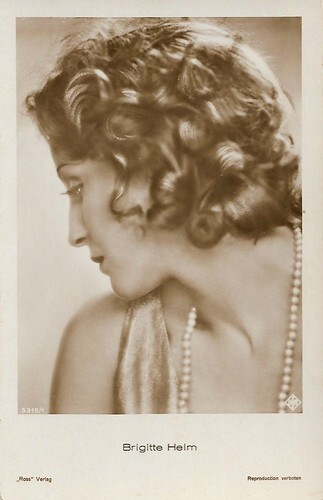
German postcard by Ross Verlag, no. 5318/1, 1930-1931. Photo: Ufa.
Timid, Modest and Not Very Ambitious
In private, Brigitte Helm was a timid, modest, and not very ambitious personality. In 1935, after a short but prolific career of 32 films, she married Dr. Hugo Von Kunheim, a German industrialist of Jewish descent, and retired.
Bruce Eder at AllMovie: "in addition to no longer needing to pursue her acting, with which she was never 100-percent comfortable, she was repelled by the takeover of the German movie industry by the Hitler government.
Her marital status, coupled with her anti-Nazi political views, made it impossible for Helm to continue working in movies or living in Germany. From 1935 onward, the couple lived in Switzerland. After the war, they divided their time between Germany and Switzerland, but Helm chose to live quietly and remain anonymous."
The pair would raise four children. In 1968 Helm received the Filmband in Gold for “continued outstanding individual contributions to German film over the years". She steadfastly refused to appear in a film again, nor even grant an interview about her film career, but she always answered requests from her old fans for her signature.
Brigitte Helm died in 1996 in Ascona, Switzerland. In particular, her Evil Maria won't be forgotten. Apt for her is the Mae West line: "When I am good, I am very good; but when I am bad, I am better."
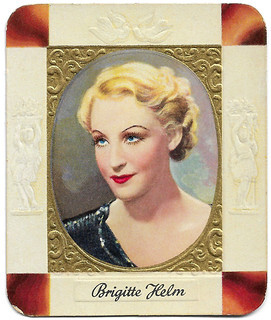
German collectors card in the Moderne Schönheitsgalerie Series by Ross Verlag, no 6 (of 300). Photo: Ufa. The card was a supplement to 'Edelzigarette' (precious cigarette) Kurmark.
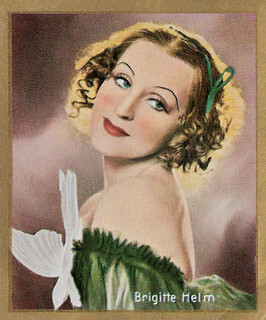
German collectors card in the Unsere Bunten Filmbilder series by Ross Verlag, no. 5 (of 275). Photo: Ufa. The card was a supplement to 'Salem Zigaretten', Dresden.
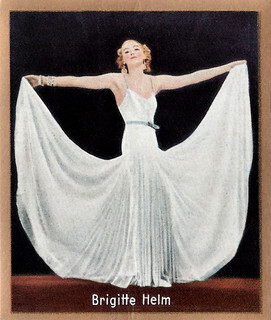
German collectors card in the Unsere Bunten Filmbilder series by Ross Verlag for Cigarettenfabrik Josetti, Berlin, no. 7 (of 275). Photo: Ufa.
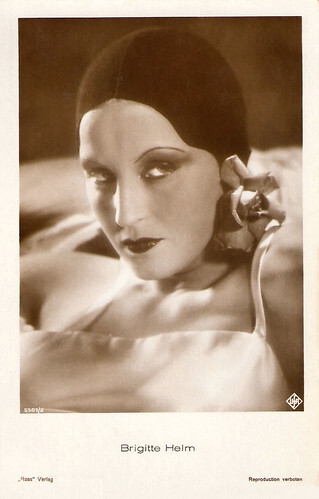
Italian postcard by Ross Verlag, no. 5501/2, 1930-1931. Distributed in Italy by Ballerini & Frattini, Florence. Photo: Ufa. Brigitte Helm in Alraune/A Daughter of Destiny (Richard Oswald, 1930).
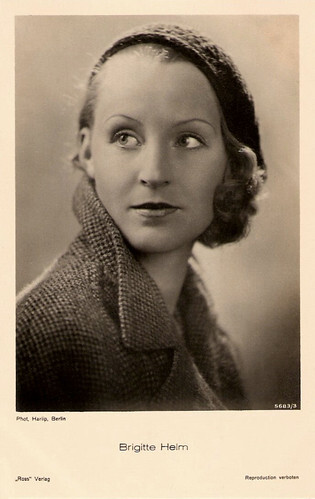
German postcard by Ross Verlag, no. 5683/3, 1930-1931. Photo: Harlip, Berlin.
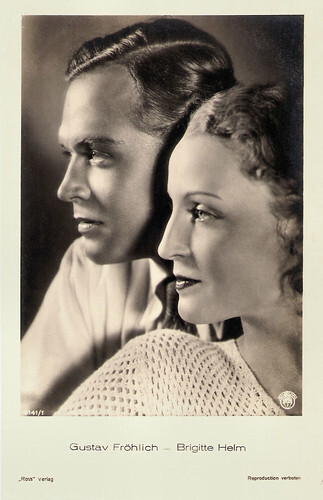
German postcard by Ross Verlag, no. 6141/1, 1931-1932. Photo: Emelka. Gustav Fröhlich and Brigitte Helm in Gloria (Hans Behrendt, 1931).
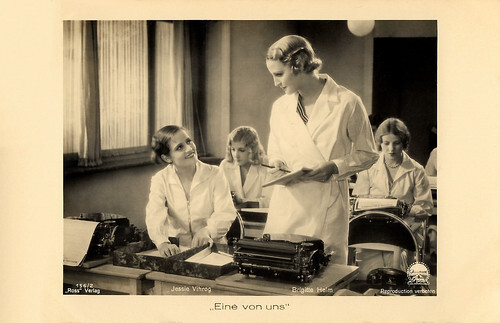
German postcard by Ross Verlag, no. 156/2. Photo: Paramount. Jessie Vihrog and Brigitte Helm in Eine von uns/One of Us (Johannes Meyer, 1932).
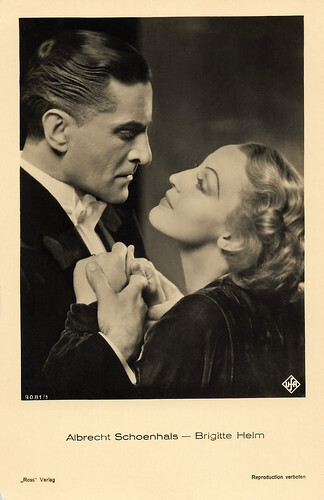
German postcard by Ross Verlag, no. 9081/1, 1935-1936. Photo: Ufa. Albrecht Schoenhals and Brigitte Helm in Fürst Woronzeff/Prince Woronzeff (Arthur Robison, 1934).
Dance scene from Metropolis (1927). Source: TheGuyThatSucks (YouTube).
Scene from Abwege/The Devious Path (1928). Brigitte Helm (as Mrs. Irene Beck) is woken up by her friends from the party, where she was the day before. Source: XY (YouTube).
Scene from L’Atlantide/Queen of Atlantis (1932). Source: XY (YouTube).
Sources: Vittorio Martinelli (Le dive del silenzio), Robert McThomas and Peter Herzog (The New York Times), Werner Sudendorff (The Independent), Bruce Eder (AllMovie), Hal Erickson (AllMovie), Thomas Staedeli (Cyranos), Film Reference, Lenin Imports, Wikipedia, and .

German postcard by Ross Verlag, no. 4531/1. Photo: Ufa. Ivan Mozzhukhin and Brigitte Helm in Manolescu - Der König der Hochstapler/Manolescu, the Prince of Adventures (Viktor Tourjansky, 1929).

German postcard by Ross Verlag, Berlin, no. 71/12. Photo: Ufa / Parufamet. Brigitte Helm in Metropolis (Fritz Lang, 1927). Collection: Didier Hanson.

German postcard by Ross Verlag, no. 1481/1, 1927-1928. Photo: Ufa.

German postcard by Ross Verlag, no. 4146/1, 1929-1930. Photo: Ufa.

German postcard by Ross Verlag, no. 4292/2, 1929-1930. Photo: Ufa.

German postcard by Ross Verlag, no. 4292/4, 1929-1930. Photo: Ufa.

German postcard by Ross Verlag, no. 4876/1, 1929-1930. Photo: Ufa-Harlip.
Metropolis
Brigitte Helm was born as Brigitte Eva Gisela Schittenhelm in Berlin, Germany, in 1906 (some sources say 1908). Her father was a Prussian army officer, who left his wife a widow not long after.
Brigitte gained her acting experience in school productions but never thought of acting classes. After her school exams, she wanted to be an astronomer. But then she was discovered by the famous director Fritz Lang for the lead in Metropolis (Fritz Lang, 1927), then the most expensive German film ever made.
Her mother had sent a photograph of her beautiful 16-years-old daughter to Lang's wife, scriptwriter Thea von Harbou. Helm was invited to the set of Die Nibelungen and was given a screen test. She got the double role of the noble and virginal Maria and her evil and sensual twin, the Maschinenmensch, a robot created to urge the workers in revolting and destroying their own city.
In their 1996 obituary in The New York Times, Robert McThomas and Peter Herzog note: "The film depicts the world of 2006, a time, Lang envisioned, when a ruling class lives in decadent luxury in the loft heights of skyscrapers linked by aerial railways, while beneath the streets slave-like workers toll in unbearable conditions to sustain their masters.
But for all the steam and special effects, for many who have seen the movie in it various incarnations, including a tinted version and one accompanied by music, the most compelling lingering image is neither the towers above nor the hellish factories below. It is the staring transformation of Ms. Helm from an idealistic young woman into a barely clad creature performing a lascivious dance in a brothel." Metropolis made Brigitte Helm a star overnight.

German postcard by Ross Verlag, no. 71/6. Photo: Parufamet / Ufa. Rudolf Klein-Rogge and Brigitte Helm in Metropolis (Fritz Lang, 1926). Collection: Marlene Pilaete.

Dutch postcard by Filma. Brigitte Helm in Die Herrin von Atlantis/Lost Atlantis (Georg Wilhelm Pabst, 1932). Caption: Friday 6 December Premiere at the Tuschinski Theatre. Collection: Marlene Pilaete.

French postcard by Europe, no. 401. Photo: Studio Lorelle, Paris. Brigitte Helm in L'Argent/The Money (Marcel L’ Herbier, 1928). Collection: Marlene Pilaete.

German postcard by Ross Verlag, no. 7882/1, 1932-1933. Photo: British European Film. Brigitte Helm in The Blue Danube (Herbert Wilcox, 1931). Collection: Marlene Pilaete.

Latvian postcard by EMBR, no. 1213. Photo: Ufa. Brigitte Helm and Sybille Schmitz in Ein idealer Gatte/An Ideal Husband (Herbert Selpin, 1935). Collection: Marlene Pilaete.

Italian postcard by Eliocromia Zacchetti e C. Milano, no. A57. Brigitte Helm by Nino Za. Collection: Marlene Pilaete.
Ice Queen
UFA gave Brigitte Helm a contract, and over the next 10 years, she acted in 29 German, French, and English films.
She was cast as the evil but oh so seductive protagonist in the Sci-Fi-horror film Alraune. First in the silent version of 1928, directed by Henrik Galeen.
Hal Erickson at AllMovie: "Hanns Heinz Ewers' grim science-fiction novel 'Alraune' has already been filmed twice when this version was assembled in 1928. In another of his 'mad doctor' roles, Paul Wegener plays Professor Brinken, the sociopathic scientist who combines the genes of an executed murderer with those of a prostitute.
The result is a beautiful young woman named Alraune (Brigitte Helm), who is incapable of feeling any real emotions - least of all guilt or regret. Upon attaining adulthood, Alraune sets about to seduce and destroy every male who crosses her path. Ultimately, Professor Brinken is hoist on his own petard when he falls hopelessly in love with Alraune himself."
Two years later Helm also starred in the sound version, Alraune/A Daughter of Destiny (Richard Oswald, 1930), for which the Dutch postcard lower in this post was made.

French postcard by P.C. Paris, no. 30. Photo: Ufa.

French postcard, no. 93. Photo: Ufa.

French postcard by Cine-Europe, no. 66. Photo: Studio Lorelle.

French postcard by Cine-Europe, no. 1074. Photo: Studio G.L. Manuel Frères, Paris.

French postcard, no. 51. Brigitte Helm in Spione am Werk/Spies at Work (Gerhard Lamprecht, 1933).
Mysterious Adaptability
Brigitte Helm played a helpless blind woman who is seduced by a rogue in the wartime melodrama Die Liebe der Jeanne Ney/The Love of Jeanne Ney (G.W. Pabst, 1927).
It was Brigitte Helm's first project with Georg Wilhelm Pabst, the director who could - better than any other director - bring out her mysterious adaptability. In his films Abwege/The Devious Path (1928) and L’Atlantide/Die Herrin von Atlantis/Queen of Atlantis (1932) she proved that she could perform more restrained and emotionally expressive characters.
In Abwege, she portrays a spoilt woman of the world who from sheer boredom almost destroys her own life. In L'Atlantide (1932), Helm plays a goddess, the mere sight of whom makes men crazy.
Werner Sudendorff wrote in his obituary of Helm in The Independent: "Her power is not of this world, but incomprehensible, magical. This was Helm's last really great role, a legendary mysterious sphinx of the German cinema."
These films and Marcel L'Herbier's late silent film L'Argent/The Money (Marcel L’ Herbier, 1928) allowed Helm to act outside the tired cliches she was later often subjected to by scriptwriters and producers.

French postcard by JRPR, Paris, no. 337. Photo: Studio Lorelle (Lucien Lorelle), Paris. Brigitte Helm in L'Argent/The Money (Marcel L'Herbier, 1928).

French postcard by JRPR, Paris, no. 338. Photo: Studio Lorelle, Paris. Publicity still for L'Argent/The Money (1928).

French postcard by Cine-Europe, no. 339. Photo: Studio Lorelle. Publicity still for L'Argent/The Money (1928).

Austrian postcard by Iris-Verlag, no. 5789. Photo: Studio Lorelle, Paris / Verleih Weil & Co. Publicity still for L'Argent/The Money (1928).

French postcard by Europe, no. 563. Photo: Cinéromans Films de France. Brigitte Helm in L'argent/The Money (Marcel L'Herbier, 1928), freely adapted from the novel by Emile Zola.
Restricting Clauses
Brigitte Helm's first sound film was the musical Die singende Stadt/City of Song (Carmine Gallone, 1930) with Jan Kiepura . She also appeared in the French and English versions of her German films.
Werner Sudendorff: "In her films of the early 1930s Brigitte Helm became the embodiment of the down-to-earth, affluent modern woman. With her slim figure and austere pre-Raphaelite profile, she seems unapproachable, a model fashion-conscious woman, under whose ice-cold outer appearance criminal energies flicker."
However, her sound films, like Gloria (Hans Behrendt, 1931), The Blue Danube (Herbert Wilcox, 1932), and Gold/L’Or (Karl Hartl, 1934), do not have the artistic cachet of her best silent films.
Her relationship with the Ufa happened to be very rocky. While the studio had made her a star and kept increasing her pay, the actress was unhappy with the material the Ufa offered her and she was annoyed about the restrictive clauses dictating her weight.

Dutch postcard by Filma, no. 280. Brigitte Helm in L'Atlantide/Die Herrin von Atlantis/Lost Atlantis (Georg Wilhelm Pabst, 1932).

Dutch postcard by Filma, no. 325.

Dutch postcard by Filma, no. 443. Photo: publicity still for L’Atlantide/Queen of Atlantis (1932).

German postcard by Ross Verlag, no. 4875/1, 1929-1930. Photo: Ufa.

German postcard by Ross Verlag, no. 4875/3, 1929-1930. Photo: Ufa.

German postcard by Ross Verlag, no. 5019/2, 1930-1931. Photo: Ufa.

Austrian postcard by Iris Verlag, no. 5420. Photo: Verleih E. Weil & Co.
Blue Angel
Reportedly Brigitte Helm was Josef Von Sternberg's original choice for the starring role of Der Blaue Engel/The Blue Angel (1930), but the part went to Marlene Dietrich .
Helm was also James Whale's first choice for his Bride of Frankenstein (1935), but reportedly she refused to go to America.
In 1935, angered by the Nazi control of the German film industry, she didn’t extend her contract with the Ufa. Perhaps another reason for her decision were the negative press reports about her many traffic accidents and the short prison sentence as a result of it.
Her last film was Ein Idealer Gatte/An Ideal Husband (Herbert Selpin, 1935), an adaptation of the play by Oscar Wilde.

German postcard by Ross Verlag, no. 3350/1, 1928-1929. Photo: Ams-Film.

German postcard by Ross Verlag, no. 4292/3, 1929-1930. Photo: Ufa.

German postcard by Ross Verlag, no. 4620/1, 1929-1930. Photo: Ufa. Brigitte Helm and Franz Lederer in Die wunderbare Lüge der Nina Petrowna/The Wonderful Lies of Nina Petrovna (Hanns Schwarz, 1929).

German postcard by Ross Verlag, no. 5261/1, 1930-1931. Photo: Ufa. Jan Kiepura and Brigitte Helm in Die singende Stadt/The Singing City (Carmine Gallone, 1930).

German postcard by Ross Verlag, no. 5317/1, 1930-1931. Photo: Allianz Film / Ufa.

German postcard by Ross Verlag, no. 5318/1, 1930-1931. Photo: Ufa.
Timid, Modest and Not Very Ambitious
In private, Brigitte Helm was a timid, modest, and not very ambitious personality. In 1935, after a short but prolific career of 32 films, she married Dr. Hugo Von Kunheim, a German industrialist of Jewish descent, and retired.
Bruce Eder at AllMovie: "in addition to no longer needing to pursue her acting, with which she was never 100-percent comfortable, she was repelled by the takeover of the German movie industry by the Hitler government.
Her marital status, coupled with her anti-Nazi political views, made it impossible for Helm to continue working in movies or living in Germany. From 1935 onward, the couple lived in Switzerland. After the war, they divided their time between Germany and Switzerland, but Helm chose to live quietly and remain anonymous."
The pair would raise four children. In 1968 Helm received the Filmband in Gold for “continued outstanding individual contributions to German film over the years". She steadfastly refused to appear in a film again, nor even grant an interview about her film career, but she always answered requests from her old fans for her signature.
Brigitte Helm died in 1996 in Ascona, Switzerland. In particular, her Evil Maria won't be forgotten. Apt for her is the Mae West line: "When I am good, I am very good; but when I am bad, I am better."

German collectors card in the Moderne Schönheitsgalerie Series by Ross Verlag, no 6 (of 300). Photo: Ufa. The card was a supplement to 'Edelzigarette' (precious cigarette) Kurmark.

German collectors card in the Unsere Bunten Filmbilder series by Ross Verlag, no. 5 (of 275). Photo: Ufa. The card was a supplement to 'Salem Zigaretten', Dresden.

German collectors card in the Unsere Bunten Filmbilder series by Ross Verlag for Cigarettenfabrik Josetti, Berlin, no. 7 (of 275). Photo: Ufa.

Italian postcard by Ross Verlag, no. 5501/2, 1930-1931. Distributed in Italy by Ballerini & Frattini, Florence. Photo: Ufa. Brigitte Helm in Alraune/A Daughter of Destiny (Richard Oswald, 1930).

German postcard by Ross Verlag, no. 5683/3, 1930-1931. Photo: Harlip, Berlin.

German postcard by Ross Verlag, no. 6141/1, 1931-1932. Photo: Emelka. Gustav Fröhlich and Brigitte Helm in Gloria (Hans Behrendt, 1931).

German postcard by Ross Verlag, no. 156/2. Photo: Paramount. Jessie Vihrog and Brigitte Helm in Eine von uns/One of Us (Johannes Meyer, 1932).

German postcard by Ross Verlag, no. 9081/1, 1935-1936. Photo: Ufa. Albrecht Schoenhals and Brigitte Helm in Fürst Woronzeff/Prince Woronzeff (Arthur Robison, 1934).
Dance scene from Metropolis (1927). Source: TheGuyThatSucks (YouTube).
Scene from Abwege/The Devious Path (1928). Brigitte Helm (as Mrs. Irene Beck) is woken up by her friends from the party, where she was the day before. Source: XY (YouTube).
Scene from L’Atlantide/Queen of Atlantis (1932). Source: XY (YouTube).
Sources: Vittorio Martinelli (Le dive del silenzio), Robert McThomas and Peter Herzog (The New York Times), Werner Sudendorff (The Independent), Bruce Eder (AllMovie), Hal Erickson (AllMovie), Thomas Staedeli (Cyranos), Film Reference, Lenin Imports, Wikipedia, and .
Published on October 02, 2022 22:00
October 1, 2022
Nanook of the North (1922) and more Inuit in the cinema
The big Sunday event of Il Giornale del cinema Muto in Pordenone is the screening in Teatro Verdi of the classic documentary Nanook of the North (1922). The American silent documentary was directed, produced and written by Robert J. Flaherty and is considered the first documentary film ever made. Nanook of the North: A Story Of Life and Love In the Actual Arctic follows the life of Inuit Nanook (Allakariallak), his wife Nyla, and their child. Flaherty documents their daily life and the hard conditions of existence around the Arctic Circle. Many traditional aspects of Inuit life, such as hunting and building igloos, are shown. In this post, we focus on five films about the Inuit.
Nanook of the North (1922)
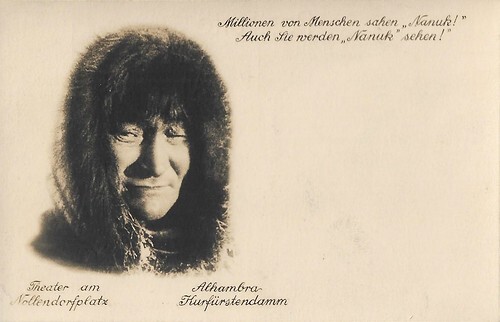
German postcard by Dafu Konzern. Publicity for the Berlin screening of the documentary feature Nanook of the North (Robert Flaherty, 1922) with Allakariallak as Nanook. The film was shown at the Berlin cinemas Theater am Nollendorfplatz and the Alhambra at the Kurfürstendamm.
Nanook of the North (Robert J. Flaherty, 1922) was a great success, mainly because it was different from what people were used to. It was the first long film shot on location that really showed the lifestyle of the Inuit instead of a story played by actors. Afterwards, however, it turned out that the film was not entirely realistic. Flaherty had staged some events. For example, at the time of the filming, the Inuit were already using guns for hunting, but Flaherty urged them to go back to hunting as their recent ancestors did. The dangers that the Inuit would face were also exaggerated here and there. For this, Robert J. Flaherty was criticised by some film critics, but in general, they were not too worried about it, as it was common in documentaries at the time for things to be staged. Flaherty further defended his actions by stating that even a documentary maker cannot avoid staging an event once in a while in order to film it properly.
Das Eskimobaby (1918)
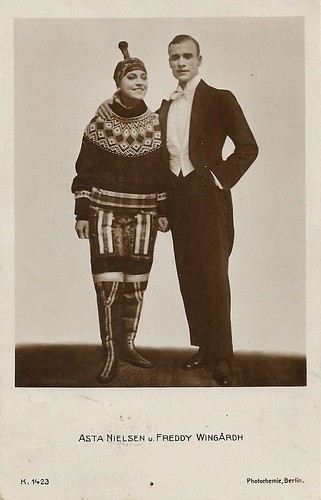
German postcard by Photochemie, no. K. 1423. Photo: Neutral-Film. Asta Nielsen and Freddy Wingardh in their outfits from Das Eskimobaby (Walter Schmidthässler, 1918).
In 1915, during a trip to South America, famous Danish film star Asta Nielsen met Freddy Wingårdh , A Swedish fleet lieutenant and son of a shipbuilder. They soon fell in love. Wingårdh made several photos of Nielsen, which were used for postcards issued by the German Photochemie company in Berlin. Wingårdh would also act in Nielsen's film Das Eskimobaby/The Eskimobaby (Walter Schmidthässler or Heinz Schaller, 1918). In this comedy, Asta played the Inuk Ivigtut Sigurdsen and Wingardh appeared as Knud Prätorius. Knud informs his parents by a letter from Greenland that he will be returning home shortly. He will bring a surprise with him from Greenland. The surprise is called Ivigtut Sigurdsen. The female Inuk appears completely uncivilised in the trousers of her people and carelessly pulls the emergency brake on the train because she is not aware of the consequences. In the end, Knud and Ivigtut travel back to Greenland with their child, and Knud's parents have in the meantime become comfortable with the idea of an Inuit daughter-in-law. Contemporary critics praised Das Eskimobaby and Nielsen's performance.
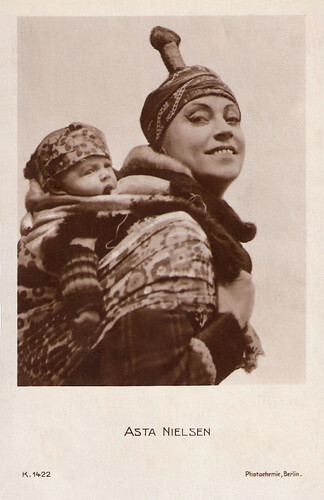
German postcard by Photochemie, Berlin, no. K. 1422. Photo: Neutral-Film. Asta Nielsen in Das Eskimobaby (Walter Schmidthaessler, 1916).
Man of Two Worlds (1934)
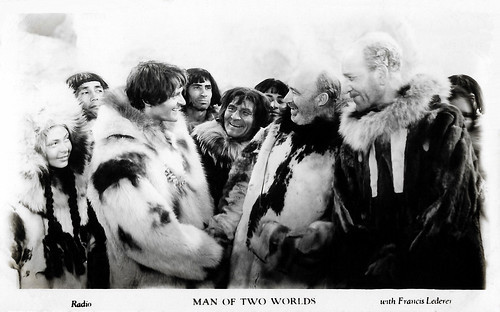
British postcard in the Film Shots series by Film Weekly. Photo: Radio (RKO). Francis Lederer in Man of Two Worlds (J. Walter Ruben, 1934).
With the success of Flaherty's Nanook of the North (1922), Hollywood tried to replicate the box office by using Inuit themes. In Man of Two Worlds (J. Walter Ruben, 1934), British explorer Sir Basil (Henry Stephenson) in the Arctic hires a local Inuk as an assistant. The earnest but unsophisticated young man called Aigo ( Francis Lederer ) happens to see a photograph of the explorer's beautiful daughter and falls in love with her. Soon afterwards a medical emergency results in his being flown to London for treatment, where he finally meets the girl he has longed for. Once in Britain, Aigo is treated as a curiosity - like some sort of simple-minded thing instead of a person. He likes what he sees - particularly Sir Basil's daughter. In his mind, he's envisioned that she is destined to be his - and, of course, he's setting himself up for disappointment. No one seems to believe, including the girl, that Aigo has normal human desires and urges. The film was a box office disappointment for RKO.
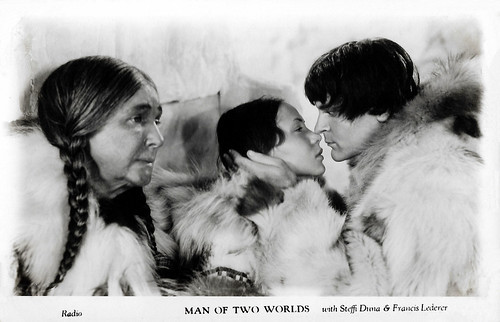
British postcard in the Film Shots series by Film Weekly. Photo: Radio (RKO). Steffi Duna and Francis Lederer in Man of Two Worlds (J. Walter Ruben, 1934).
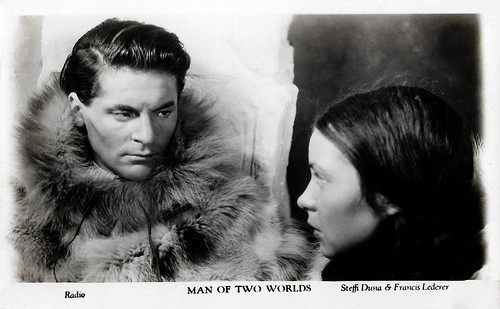
British postcard in the Film Shots series by Film Weekly. Photo: Radio (RKO). Steffi Duna and Francis Lederer in Man of Two Worlds (J. Walter Ruben, 1934).
The Savage Innocents (1959)
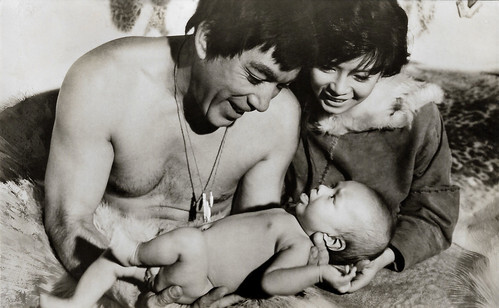
West-German card. Photo: Rank Film. Anthony Quinn and Yoko Tani in The Savage Innocents (Nicholas Ray, 1959).
Mexican-American actor Anthony Quinn and French-born Japanese actress Yoko Tani starred as an Inuit couple in the adventure film The Savage Innocents (1960), directed and co-written by Nicholas Ray. The film's themes include Inuit survival in the extreme arctic wilderness, as well as their raw existence and struggle to maintain their lifestyle against encroaching civilization. The Savage Innocents was adapted from the novel 'Top of the World' by Swiss writer Hans Rüesch. Quinn plays an Inuk hunter Inuk who kills a Christian missionary who rejects his traditional offer of food and his wife's company. Pursued by white policemen, the Inuk saves the life of one of them, resulting in a final confrontation in which the surviving cop must decide between his commitment to law enforcement and his gratitude to the Inuk. The film was an international co-production, with British, Italian and French interests involved. The Savage Innocents was shot on-location in the Canadian Arctic, with interiors shot in Britain's Pinewood Studios and in Rome's Cinecittà studios. It was entered at the 1960 Cannes Film Festival.
Brother Bear (2003)
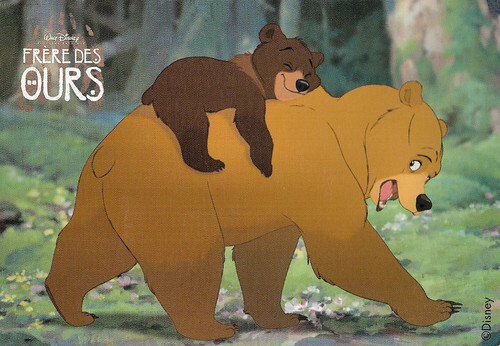
French postcard by Jump, Paris, for McDonald's. Image: Walt Disney Pictures. Publicity still for Brother Bear (Aaron Blaise, Robert Walker, 2003).
Brother Bear (Aaron Blaise, Robert Walker, 2003) is an American animated musical fantasy comedy-drama produced by Walt Disney Studios. In a post-ice age Alaska, the local tribes believe all creatures are created through the Great Spirits, who are said to appear in the form of an aurora. Native boy Kenai pursues a bear and kills it, but the Spirits, incensed by this unnecessary death, change Kenai into a bear himself as punishment. In order to be human again, Kenai must travel to a mountain where the Northern lights touch the earth. In the Chicago Sun-Times, Roger Ebert wrote the film "doesn't have the zowie factor of The Lion King or Finding Nemo, but is sweet rather than exciting. Children and their parents are likely to relate on completely different levels, the adults connecting with the transfer of souls from man to beast, while the kids are excited by the adventure stuff." The film received a nomination for Best Animated Feature at the 76th Academy Awards, losing to Pixar's Finding Nemo. The film grossed $250 million against a $46 million budget.

French postcard by Cartoon Collection, réf. 28963. Image: Walt Disney Pictures. Publicity still for Brother Bear (Aaron Blaise, Robert Walker, 2003). The French title is Frère des ours.

French postcard by Cartoon Collection, réf. 28964. Image: Walt Disney Pictures. Publicity still for Brother Bear (Aaron Blaise, Robert Walker, 2003). The French title is Frère des ours.
Sources: Wikipedia (German and English), and IMDb.
This post only shows a small selection of films on the Inuit, films of which we had postcards in our collection. Wikipedia offers a bigger selection.
Nanook of the North (1922)

German postcard by Dafu Konzern. Publicity for the Berlin screening of the documentary feature Nanook of the North (Robert Flaherty, 1922) with Allakariallak as Nanook. The film was shown at the Berlin cinemas Theater am Nollendorfplatz and the Alhambra at the Kurfürstendamm.
Nanook of the North (Robert J. Flaherty, 1922) was a great success, mainly because it was different from what people were used to. It was the first long film shot on location that really showed the lifestyle of the Inuit instead of a story played by actors. Afterwards, however, it turned out that the film was not entirely realistic. Flaherty had staged some events. For example, at the time of the filming, the Inuit were already using guns for hunting, but Flaherty urged them to go back to hunting as their recent ancestors did. The dangers that the Inuit would face were also exaggerated here and there. For this, Robert J. Flaherty was criticised by some film critics, but in general, they were not too worried about it, as it was common in documentaries at the time for things to be staged. Flaherty further defended his actions by stating that even a documentary maker cannot avoid staging an event once in a while in order to film it properly.
Das Eskimobaby (1918)

German postcard by Photochemie, no. K. 1423. Photo: Neutral-Film. Asta Nielsen and Freddy Wingardh in their outfits from Das Eskimobaby (Walter Schmidthässler, 1918).
In 1915, during a trip to South America, famous Danish film star Asta Nielsen met Freddy Wingårdh , A Swedish fleet lieutenant and son of a shipbuilder. They soon fell in love. Wingårdh made several photos of Nielsen, which were used for postcards issued by the German Photochemie company in Berlin. Wingårdh would also act in Nielsen's film Das Eskimobaby/The Eskimobaby (Walter Schmidthässler or Heinz Schaller, 1918). In this comedy, Asta played the Inuk Ivigtut Sigurdsen and Wingardh appeared as Knud Prätorius. Knud informs his parents by a letter from Greenland that he will be returning home shortly. He will bring a surprise with him from Greenland. The surprise is called Ivigtut Sigurdsen. The female Inuk appears completely uncivilised in the trousers of her people and carelessly pulls the emergency brake on the train because she is not aware of the consequences. In the end, Knud and Ivigtut travel back to Greenland with their child, and Knud's parents have in the meantime become comfortable with the idea of an Inuit daughter-in-law. Contemporary critics praised Das Eskimobaby and Nielsen's performance.

German postcard by Photochemie, Berlin, no. K. 1422. Photo: Neutral-Film. Asta Nielsen in Das Eskimobaby (Walter Schmidthaessler, 1916).
Man of Two Worlds (1934)

British postcard in the Film Shots series by Film Weekly. Photo: Radio (RKO). Francis Lederer in Man of Two Worlds (J. Walter Ruben, 1934).
With the success of Flaherty's Nanook of the North (1922), Hollywood tried to replicate the box office by using Inuit themes. In Man of Two Worlds (J. Walter Ruben, 1934), British explorer Sir Basil (Henry Stephenson) in the Arctic hires a local Inuk as an assistant. The earnest but unsophisticated young man called Aigo ( Francis Lederer ) happens to see a photograph of the explorer's beautiful daughter and falls in love with her. Soon afterwards a medical emergency results in his being flown to London for treatment, where he finally meets the girl he has longed for. Once in Britain, Aigo is treated as a curiosity - like some sort of simple-minded thing instead of a person. He likes what he sees - particularly Sir Basil's daughter. In his mind, he's envisioned that she is destined to be his - and, of course, he's setting himself up for disappointment. No one seems to believe, including the girl, that Aigo has normal human desires and urges. The film was a box office disappointment for RKO.

British postcard in the Film Shots series by Film Weekly. Photo: Radio (RKO). Steffi Duna and Francis Lederer in Man of Two Worlds (J. Walter Ruben, 1934).

British postcard in the Film Shots series by Film Weekly. Photo: Radio (RKO). Steffi Duna and Francis Lederer in Man of Two Worlds (J. Walter Ruben, 1934).
The Savage Innocents (1959)

West-German card. Photo: Rank Film. Anthony Quinn and Yoko Tani in The Savage Innocents (Nicholas Ray, 1959).
Mexican-American actor Anthony Quinn and French-born Japanese actress Yoko Tani starred as an Inuit couple in the adventure film The Savage Innocents (1960), directed and co-written by Nicholas Ray. The film's themes include Inuit survival in the extreme arctic wilderness, as well as their raw existence and struggle to maintain their lifestyle against encroaching civilization. The Savage Innocents was adapted from the novel 'Top of the World' by Swiss writer Hans Rüesch. Quinn plays an Inuk hunter Inuk who kills a Christian missionary who rejects his traditional offer of food and his wife's company. Pursued by white policemen, the Inuk saves the life of one of them, resulting in a final confrontation in which the surviving cop must decide between his commitment to law enforcement and his gratitude to the Inuk. The film was an international co-production, with British, Italian and French interests involved. The Savage Innocents was shot on-location in the Canadian Arctic, with interiors shot in Britain's Pinewood Studios and in Rome's Cinecittà studios. It was entered at the 1960 Cannes Film Festival.
Brother Bear (2003)

French postcard by Jump, Paris, for McDonald's. Image: Walt Disney Pictures. Publicity still for Brother Bear (Aaron Blaise, Robert Walker, 2003).
Brother Bear (Aaron Blaise, Robert Walker, 2003) is an American animated musical fantasy comedy-drama produced by Walt Disney Studios. In a post-ice age Alaska, the local tribes believe all creatures are created through the Great Spirits, who are said to appear in the form of an aurora. Native boy Kenai pursues a bear and kills it, but the Spirits, incensed by this unnecessary death, change Kenai into a bear himself as punishment. In order to be human again, Kenai must travel to a mountain where the Northern lights touch the earth. In the Chicago Sun-Times, Roger Ebert wrote the film "doesn't have the zowie factor of The Lion King or Finding Nemo, but is sweet rather than exciting. Children and their parents are likely to relate on completely different levels, the adults connecting with the transfer of souls from man to beast, while the kids are excited by the adventure stuff." The film received a nomination for Best Animated Feature at the 76th Academy Awards, losing to Pixar's Finding Nemo. The film grossed $250 million against a $46 million budget.

French postcard by Cartoon Collection, réf. 28963. Image: Walt Disney Pictures. Publicity still for Brother Bear (Aaron Blaise, Robert Walker, 2003). The French title is Frère des ours.

French postcard by Cartoon Collection, réf. 28964. Image: Walt Disney Pictures. Publicity still for Brother Bear (Aaron Blaise, Robert Walker, 2003). The French title is Frère des ours.
Sources: Wikipedia (German and English), and IMDb.
This post only shows a small selection of films on the Inuit, films of which we had postcards in our collection. Wikipedia offers a bigger selection.
Published on October 01, 2022 22:00
September 30, 2022
Lon Chaney
We're back in Italy for Le Giornate del Cinema Muto in Pordenone. The opening film is Tod Browning's The Unknown (1927) starring Lon Chaney (1883-1930), one of the most versatile and powerful actors of early cinema. Between 1912 and 1930 he played more the 150 widely diverse roles. He is renowned for his characterizations of tortured, often grotesque and afflicted characters, and his groundbreaking artistry with makeup in such silent horror films as The Hunchback of Notre Dame (1923) and He Who Gets Slapped (1924).

German postcard by Ross Verlag, no. 1894/1, 1927-1928. Photo: MGM / FaNuMet.
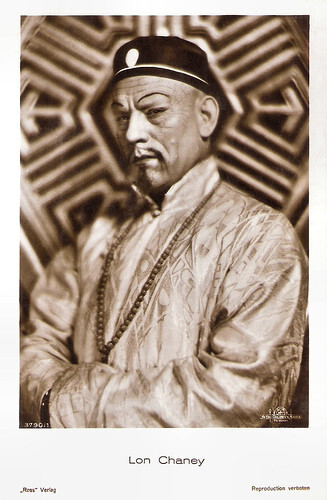
German postcard by Ross Verlag, no. 3790/1, 1928-1929. Photo: MGM. Lon Chaney in Mr. Wu (William Nigh, 1927).
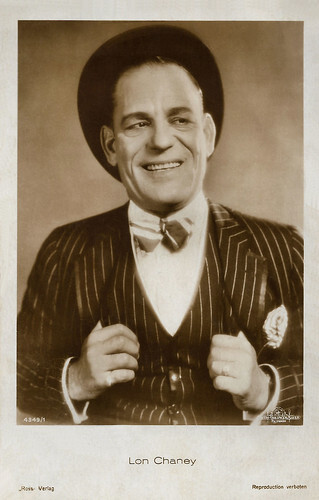
German postcard by Ross Verlag, no. 4349/1, 1929-1930. Photo: MGM. Lon Chaney in The Big City (Tod Browning, 1928).
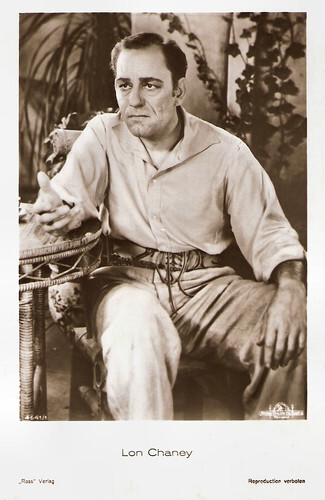
German postcard by Ross Verlag, no. 4641/1, 1929-1930. Photo: Metro-Goldwyn-Mayer. Lon Chaney in Where East Is East (Tod Browning, 1929).
Communicating through pantomime, sign language and facial expression
Leonidas Frank ‘Lon’ Chaney was born in Colorado Springs, Colorado, in 1883. He was the son of deaf-mute parents, Frank and Emma Chaney, and he learned from childhood to communicate through pantomime, sign language and facial expression. The stagestruck Chaney worked in a variety of backstage positions at the opera house in his hometown of Colorado Springs. Only 17, he was eventually allowed to appear on stage.
In 1901, he went on the road as an actor in a play that he co-wrote with his brother, The Little Tycoon. After limited success, the company was sold. He began travelling with popular Vaudeville and theatre acts. On tour in Oklahoma City, he met Francis Cleveland ‘Cleva’ Creighton, (Cleva) who was auditioning for a part in the show as a singer.
In 1905, Chaney, then 22, married 16-year-old Cleva and in 1906, their only child, a son, Creighton Tull Chaney (later known as film actor Lon Chaney, Jr.) was born. The Chaneys continued touring, settling in California in 1910. Their marriage became strained due to working conditions, money and jealousy. In 1913, Cleva went to the Majestic Theater in downtown Los Angeles, where Lon was managing the Kolb and Dill show and attempted suicide by swallowing mercuric chloride. The suicide attempt failed but it ruined her voice.
The ensuing scandal and divorce forced Chaney out of the theatre and into the booming industry of silent films. Between 1912 and 1917, Chaney worked under contract for Universal Studios doing a hundred bit or character parts. His skill with makeup gained him many parts in the highly competitive casting atmosphere. During this time, Chaney befriended the husband-wife director team of Joe De Grasse and Ida May Park, who gave him substantial roles in their pictures, and further encouraged him to play macabre characters.
Chaney married one of his former colleagues in the Kolb and Dill company tour, chorus girl Hazel Hastings. Little is known of Hazel, except that her marriage to Chaney was solid. The couple gained custody of Chaney's 10-year-old son Creighton, who had resided in various homes and boarding schools since Chaney's divorce from Cleva.
In 1917 Universal presented Chaney, Dorothy Phillips, and William Stowell as a team in the drama The Piper's Price (Joe De Grasse, 1917). In succeeding films, the men alternated playing lover, villain, or the other man to the beautiful Phillips. They would occasionally be joined by Claire Du Brey nearly making the trio a quartet of recurring actors from film to film. So successful were the films starring this group that Universal produced fourteen films from 1917 to 1919 with Chaney, Stowell, and Phillips.
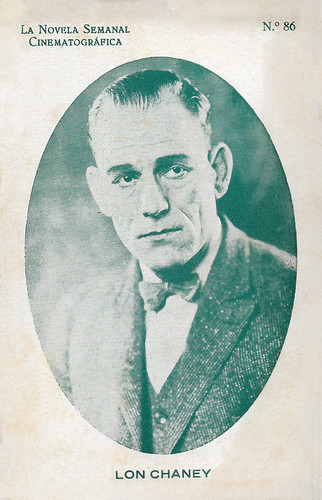
Spanish postcard by La Novela Semanal Cinematografica, no. 86.
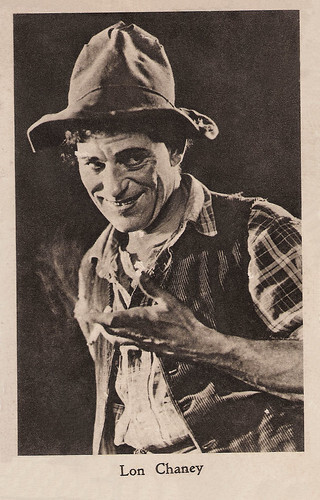
Spanish postcard in the Collectiõn de 14 postales Artistas Cinematograficasby ISMI / Huegograbado, Mumbru, Barcelona, serie A, no. 13. Photo: Universal Film. Lon Chaney in The Trap (Robert Thornby, 1922).
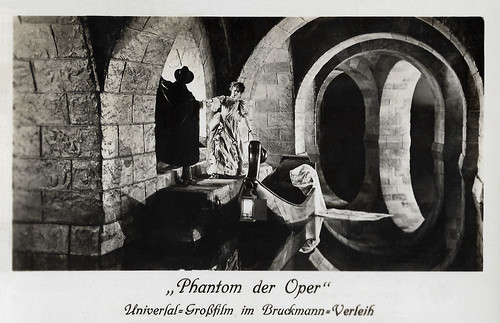
German postcard by Bruckmann-Verleih. Photo: Universal. Lon Chaney and Mary Philbin in The Phantom of the Opera (Rupert Julian, 1925). Caption: "Premiere at the Primus Palast 5 November 1925."
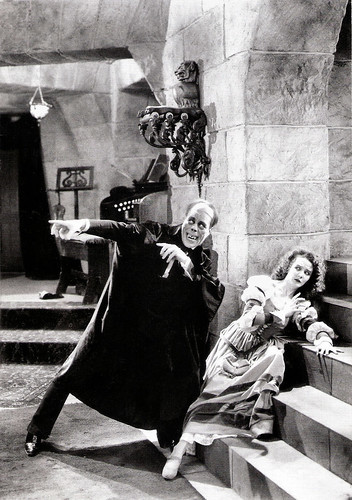
Italian programme card for Il Cinema Ritrovata 2011. Photo: Lon Chaney and Mary Philbin in Phantom of the Opera (Rupert Julian, 1925).
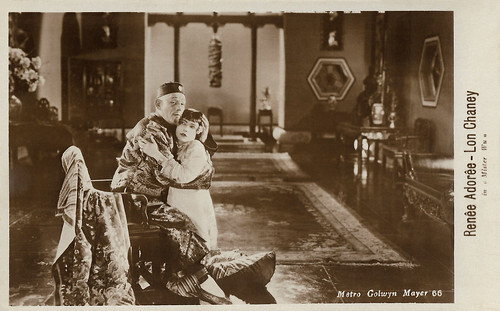
Italian postcard by G.B. Falci, Milano, no. 66. Photo: Metro-Goldwyn-Mayer. Lon Chaney and Renée Adorée in Mr. Wu (1927).
A con man who pretends to be a cripple and is miraculously healed
By 1917 Lon Chaney was a prominent actor of the Universal studio, but his salary did not reflect this status. When Chaney asked for a raise, studio executive William Sistrom replied, "You'll never be worth more than one hundred dollars a week." After leaving the studio, Chaney struggled for the first year as a free-lance character actor.
He got his first big break when playing a substantial role in William S. Hart's Western, Riddle Gawne (William S. Hart, Lambert Hillyer, 1918). He received high praise for his performance in the role. In 1919, Chaney had another breakthrough performance in The Miracle Man (George Loane Tucker, 1919), as The Frog, a con man who pretends to be a cripple and is miraculously healed. The film displayed not only Chaney's acting ability but also his talent as a master of makeup. Critical praise and a gross of over $2 million put Chaney on the map as America's foremost character actor.
He exhibited great adaptability with makeup in more conventional crime and adventure films, such as The Penalty (Wallace Worsley, 1920), in which he played an amputee gangster. As Quasimodo in The Hunchback of Notre Dame (Wallace Worsley, 1923) and Erik, the tortured opera ghost in The Phantom of the Opera (Rupert Julian, 1925), Chaney created two of the most grotesquely deformed characters in film history.
William K. Everson in American Silent Film : "Only 'The Phantom of the Opera,' with its classic unmasking scene, a masterpiece of manipulative editing, really succeeded (and still does!) in actually scaring the audience - and that because the revelation had to be a purely visual one. Moreover, Lon Chaney's make-up was so grotesque as to equal, if not surpass, anything that the audience might have anticipated or imagined."
Chaney also appeared in ten films directed by Tod Browning, often portraying disguised and/or mutilated characters. His portrayals sought to elicit a degree of sympathy and pathos among viewers not overwhelmingly terrified or repulsed by the monstrous disfigurements of these victims of fate.
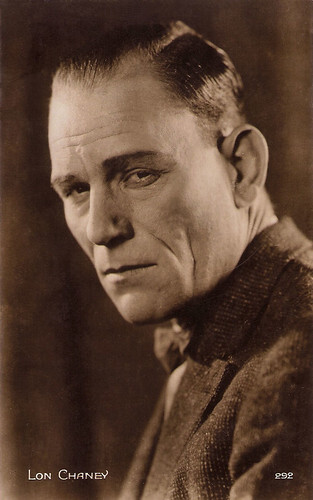
French postcard by Cinémagazine-Édition, Paris, no. 292.
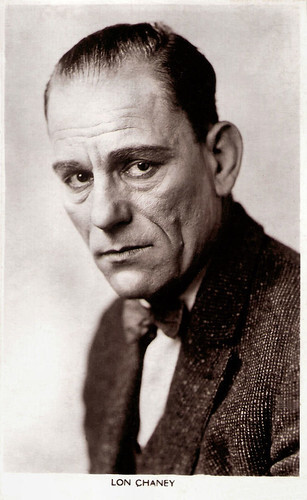
British postcard in the Picturegoer Series, London, no. 43.
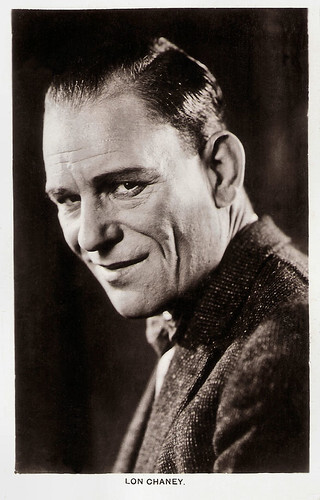
British postcard in the Picturegoer Series, London, no. 43a.
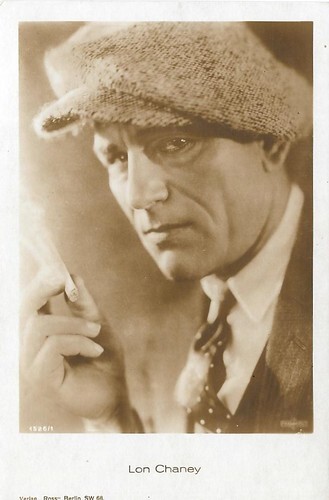
German postcard by Ross Verlag, no. 1526/1, 1927-1928. Photo: Fanumet. Collection: Didier Hanson.
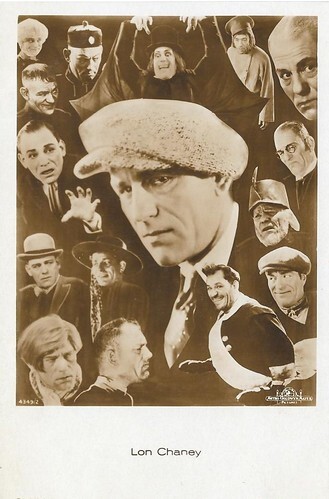
German postcard by Ross Verlag, no. 4349/2, 1929-1930. Image: MGM. Collection: Didier Hanson.
One of the most legendary and sought-after lost films
In 1924, Lon Chaney starred in Metro-Goldwyn’s He Who Gets Slapped, a circus melodrama voted one of the best films of the year. The success of this film led to a series of contracts with MGM Studios for the next five years. In these final five years of his film career, Chaney gave some of his most memorable performances.
His portrayal of a tough-as-nails marine drill instructor opposite William Haines in Tell It to the Marines (George W. Hill, 1926), one of his favourite films, earned him the affection of the Marine Corps, who made him their first honorary member of the motion picture industry. Memorable is also his carnival knife-thrower Alonzo the Armless in The Unknown (Tod Browning, 1927) opposite Joan Crawford .
In 1927, Chaney also co-starred with Conrad Nagel and Marceline Day in the horror film London After Midnight (Tod Browning, 1927), considered one of the most legendary and sought-after lost films. His final film role was a sound remake of his silent classic The Unholy Three (Jack Conway, 1930). He played Echo, a crook ventriloquist and used five different voices (the ventriloquist, the old woman, a parrot, the dummy and the girl) in the film, thus proving he could make the transition from silent films to the talkies. Chaney signed a sworn statement declaring that the five voices in the film were his own.
During the filming of Thunder in the winter of 1929, Chaney developed pneumonia. In late 1929 the heavy smoker was diagnosed with bronchial lung cancer. This was exacerbated when artificial snow, made out of cornflakes, lodged in his throat during filming and quickly created a serious infection. Despite aggressive treatment, his condition gradually worsened, and seven weeks after the release of the remake of The Unholy Three (1930), he died of a throat haemorrhage in Los Angeles, California.
In his last days, his illness had rendered him unable to speak, forcing him to rely on the pantomimic gestures of his youth in order to communicate with his friends and loved ones. Chaney and his second wife Hazel had led a discreet private life distant from the Hollywood social scene. Chaney did minimal promotional work for his films and for Metro-Goldwyn-Mayer, purposefully fostering a mysterious image, and he reportedly intentionally avoided the social scene in Hollywood.
At the end of the 1950s, Lon Chaney was rediscovered. He was portrayed by James Cagney in the biopic Man of a Thousand Faces (Joseph Pevney, 1957). In 1958, Chaney fan Forrest J. Ackerman started and edited the magazine Famous Monsters of Filmland, which published many photographs and articles about Chaney. Ackerman is also present in Kevin Brownlow’s documentary Lon Chaney: A Thousand Faces (2000).
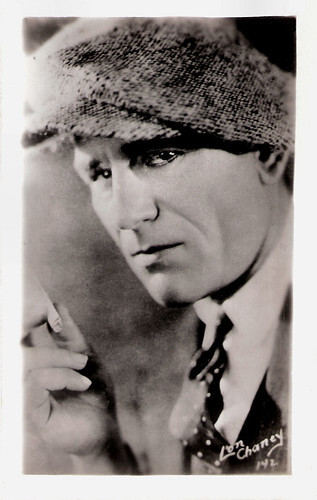
British postcard, no. 142.
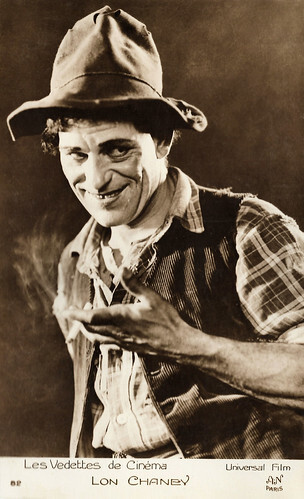
French postcard by A.N., Paris, no. 52. Photo: Universal Film. Lon Chaney in The Trap (Robert Thornby, 1922).
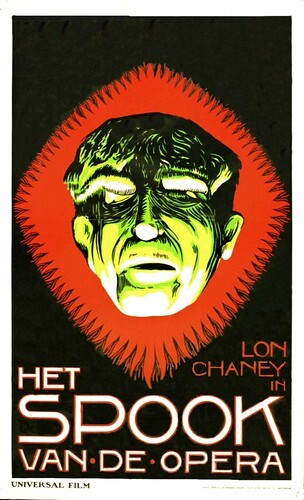
Dutch poster by Frans Bosen for The Phantom of the Opera (Rupert Julian, 1925) with Lon Chaney.
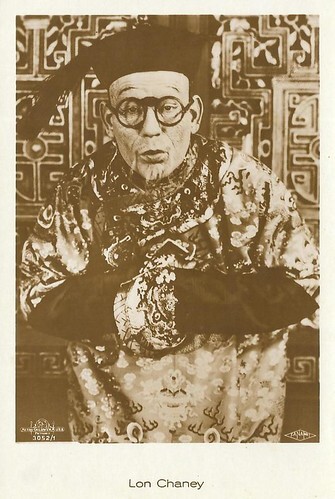
German postcard by Ross Verlag, no. 3052/1, 1928-1929. Photo: MGM / Fanumet. Publicity still for Mr. Wu (William Nigh, 1927). Collection: Didier Hanson.
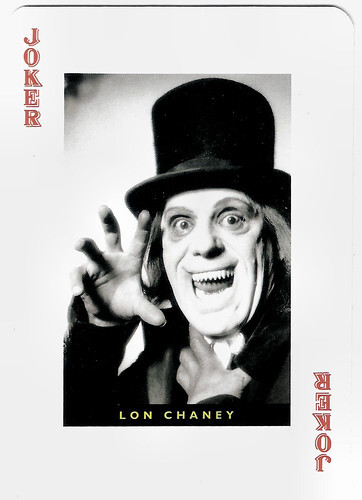
A playing card with Lon Chaney as the Joker. Lon Chaney in London After Midnight (Tod Browning, 1927).
Sources: Hal Erickson (AllMovie), Lon Chaney.com, Silents are Golden, Wikipedia and .

German postcard by Ross Verlag, no. 1894/1, 1927-1928. Photo: MGM / FaNuMet.

German postcard by Ross Verlag, no. 3790/1, 1928-1929. Photo: MGM. Lon Chaney in Mr. Wu (William Nigh, 1927).

German postcard by Ross Verlag, no. 4349/1, 1929-1930. Photo: MGM. Lon Chaney in The Big City (Tod Browning, 1928).

German postcard by Ross Verlag, no. 4641/1, 1929-1930. Photo: Metro-Goldwyn-Mayer. Lon Chaney in Where East Is East (Tod Browning, 1929).
Communicating through pantomime, sign language and facial expression
Leonidas Frank ‘Lon’ Chaney was born in Colorado Springs, Colorado, in 1883. He was the son of deaf-mute parents, Frank and Emma Chaney, and he learned from childhood to communicate through pantomime, sign language and facial expression. The stagestruck Chaney worked in a variety of backstage positions at the opera house in his hometown of Colorado Springs. Only 17, he was eventually allowed to appear on stage.
In 1901, he went on the road as an actor in a play that he co-wrote with his brother, The Little Tycoon. After limited success, the company was sold. He began travelling with popular Vaudeville and theatre acts. On tour in Oklahoma City, he met Francis Cleveland ‘Cleva’ Creighton, (Cleva) who was auditioning for a part in the show as a singer.
In 1905, Chaney, then 22, married 16-year-old Cleva and in 1906, their only child, a son, Creighton Tull Chaney (later known as film actor Lon Chaney, Jr.) was born. The Chaneys continued touring, settling in California in 1910. Their marriage became strained due to working conditions, money and jealousy. In 1913, Cleva went to the Majestic Theater in downtown Los Angeles, where Lon was managing the Kolb and Dill show and attempted suicide by swallowing mercuric chloride. The suicide attempt failed but it ruined her voice.
The ensuing scandal and divorce forced Chaney out of the theatre and into the booming industry of silent films. Between 1912 and 1917, Chaney worked under contract for Universal Studios doing a hundred bit or character parts. His skill with makeup gained him many parts in the highly competitive casting atmosphere. During this time, Chaney befriended the husband-wife director team of Joe De Grasse and Ida May Park, who gave him substantial roles in their pictures, and further encouraged him to play macabre characters.
Chaney married one of his former colleagues in the Kolb and Dill company tour, chorus girl Hazel Hastings. Little is known of Hazel, except that her marriage to Chaney was solid. The couple gained custody of Chaney's 10-year-old son Creighton, who had resided in various homes and boarding schools since Chaney's divorce from Cleva.
In 1917 Universal presented Chaney, Dorothy Phillips, and William Stowell as a team in the drama The Piper's Price (Joe De Grasse, 1917). In succeeding films, the men alternated playing lover, villain, or the other man to the beautiful Phillips. They would occasionally be joined by Claire Du Brey nearly making the trio a quartet of recurring actors from film to film. So successful were the films starring this group that Universal produced fourteen films from 1917 to 1919 with Chaney, Stowell, and Phillips.

Spanish postcard by La Novela Semanal Cinematografica, no. 86.

Spanish postcard in the Collectiõn de 14 postales Artistas Cinematograficasby ISMI / Huegograbado, Mumbru, Barcelona, serie A, no. 13. Photo: Universal Film. Lon Chaney in The Trap (Robert Thornby, 1922).

German postcard by Bruckmann-Verleih. Photo: Universal. Lon Chaney and Mary Philbin in The Phantom of the Opera (Rupert Julian, 1925). Caption: "Premiere at the Primus Palast 5 November 1925."

Italian programme card for Il Cinema Ritrovata 2011. Photo: Lon Chaney and Mary Philbin in Phantom of the Opera (Rupert Julian, 1925).

Italian postcard by G.B. Falci, Milano, no. 66. Photo: Metro-Goldwyn-Mayer. Lon Chaney and Renée Adorée in Mr. Wu (1927).
A con man who pretends to be a cripple and is miraculously healed
By 1917 Lon Chaney was a prominent actor of the Universal studio, but his salary did not reflect this status. When Chaney asked for a raise, studio executive William Sistrom replied, "You'll never be worth more than one hundred dollars a week." After leaving the studio, Chaney struggled for the first year as a free-lance character actor.
He got his first big break when playing a substantial role in William S. Hart's Western, Riddle Gawne (William S. Hart, Lambert Hillyer, 1918). He received high praise for his performance in the role. In 1919, Chaney had another breakthrough performance in The Miracle Man (George Loane Tucker, 1919), as The Frog, a con man who pretends to be a cripple and is miraculously healed. The film displayed not only Chaney's acting ability but also his talent as a master of makeup. Critical praise and a gross of over $2 million put Chaney on the map as America's foremost character actor.
He exhibited great adaptability with makeup in more conventional crime and adventure films, such as The Penalty (Wallace Worsley, 1920), in which he played an amputee gangster. As Quasimodo in The Hunchback of Notre Dame (Wallace Worsley, 1923) and Erik, the tortured opera ghost in The Phantom of the Opera (Rupert Julian, 1925), Chaney created two of the most grotesquely deformed characters in film history.
William K. Everson in American Silent Film : "Only 'The Phantom of the Opera,' with its classic unmasking scene, a masterpiece of manipulative editing, really succeeded (and still does!) in actually scaring the audience - and that because the revelation had to be a purely visual one. Moreover, Lon Chaney's make-up was so grotesque as to equal, if not surpass, anything that the audience might have anticipated or imagined."
Chaney also appeared in ten films directed by Tod Browning, often portraying disguised and/or mutilated characters. His portrayals sought to elicit a degree of sympathy and pathos among viewers not overwhelmingly terrified or repulsed by the monstrous disfigurements of these victims of fate.

French postcard by Cinémagazine-Édition, Paris, no. 292.

British postcard in the Picturegoer Series, London, no. 43.

British postcard in the Picturegoer Series, London, no. 43a.

German postcard by Ross Verlag, no. 1526/1, 1927-1928. Photo: Fanumet. Collection: Didier Hanson.

German postcard by Ross Verlag, no. 4349/2, 1929-1930. Image: MGM. Collection: Didier Hanson.
One of the most legendary and sought-after lost films
In 1924, Lon Chaney starred in Metro-Goldwyn’s He Who Gets Slapped, a circus melodrama voted one of the best films of the year. The success of this film led to a series of contracts with MGM Studios for the next five years. In these final five years of his film career, Chaney gave some of his most memorable performances.
His portrayal of a tough-as-nails marine drill instructor opposite William Haines in Tell It to the Marines (George W. Hill, 1926), one of his favourite films, earned him the affection of the Marine Corps, who made him their first honorary member of the motion picture industry. Memorable is also his carnival knife-thrower Alonzo the Armless in The Unknown (Tod Browning, 1927) opposite Joan Crawford .
In 1927, Chaney also co-starred with Conrad Nagel and Marceline Day in the horror film London After Midnight (Tod Browning, 1927), considered one of the most legendary and sought-after lost films. His final film role was a sound remake of his silent classic The Unholy Three (Jack Conway, 1930). He played Echo, a crook ventriloquist and used five different voices (the ventriloquist, the old woman, a parrot, the dummy and the girl) in the film, thus proving he could make the transition from silent films to the talkies. Chaney signed a sworn statement declaring that the five voices in the film were his own.
During the filming of Thunder in the winter of 1929, Chaney developed pneumonia. In late 1929 the heavy smoker was diagnosed with bronchial lung cancer. This was exacerbated when artificial snow, made out of cornflakes, lodged in his throat during filming and quickly created a serious infection. Despite aggressive treatment, his condition gradually worsened, and seven weeks after the release of the remake of The Unholy Three (1930), he died of a throat haemorrhage in Los Angeles, California.
In his last days, his illness had rendered him unable to speak, forcing him to rely on the pantomimic gestures of his youth in order to communicate with his friends and loved ones. Chaney and his second wife Hazel had led a discreet private life distant from the Hollywood social scene. Chaney did minimal promotional work for his films and for Metro-Goldwyn-Mayer, purposefully fostering a mysterious image, and he reportedly intentionally avoided the social scene in Hollywood.
At the end of the 1950s, Lon Chaney was rediscovered. He was portrayed by James Cagney in the biopic Man of a Thousand Faces (Joseph Pevney, 1957). In 1958, Chaney fan Forrest J. Ackerman started and edited the magazine Famous Monsters of Filmland, which published many photographs and articles about Chaney. Ackerman is also present in Kevin Brownlow’s documentary Lon Chaney: A Thousand Faces (2000).

British postcard, no. 142.

French postcard by A.N., Paris, no. 52. Photo: Universal Film. Lon Chaney in The Trap (Robert Thornby, 1922).

Dutch poster by Frans Bosen for The Phantom of the Opera (Rupert Julian, 1925) with Lon Chaney.

German postcard by Ross Verlag, no. 3052/1, 1928-1929. Photo: MGM / Fanumet. Publicity still for Mr. Wu (William Nigh, 1927). Collection: Didier Hanson.

A playing card with Lon Chaney as the Joker. Lon Chaney in London After Midnight (Tod Browning, 1927).
Sources: Hal Erickson (AllMovie), Lon Chaney.com, Silents are Golden, Wikipedia and .
Published on September 30, 2022 22:00
September 29, 2022
Elvis Presley
When The Beatles came to America in 1965 there was only one person they wanted to meet: Elvis Presley (1935-1977). Elvis had more multi-platinum album sales than any other performer, with twelve albums selling over 2 million copies. The King also appeared in several films, including several formulaic, modest-budget musical comedies.
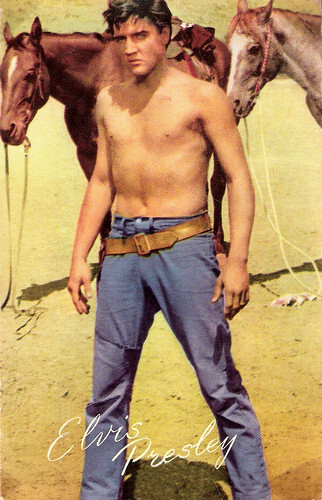
Dutch postcard. Elvis Presley in Flaming Star (Don Siegel, 1960).
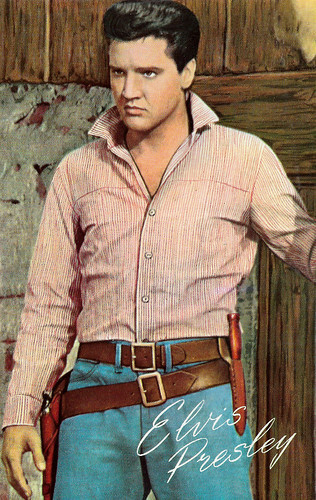
Dutch postcard, Serie 6. Elvis Presley in Flaming Star (Don Siegel, 1960).
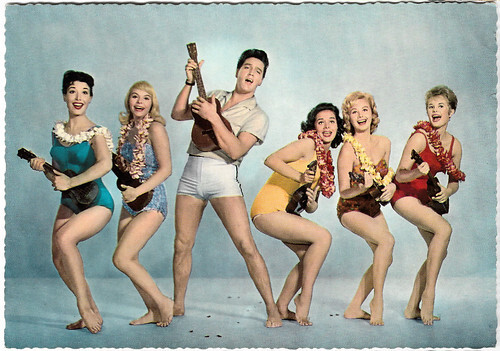
German postcard by Krüger, no. 902/145. Photo: UFA. Elvis Presley in Blue Hawaii (Norman Taurog, 1961) with Pamela Austin, Joan Blackman, Jenny Maxwell, Darlene Tompkins, and Nancy Walters.
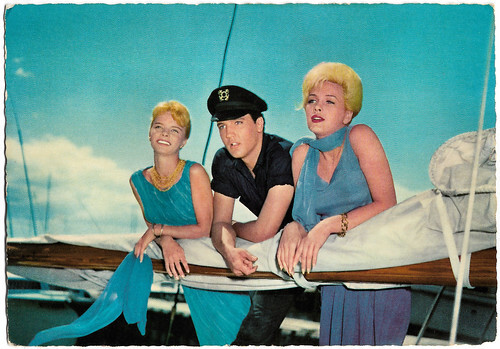
Vintage postcard, no. 3. Laurel Goodwin, Elvis Presley and Stella Stevens in Girls! Girls! Girls! (Norman Taurog, 1962).
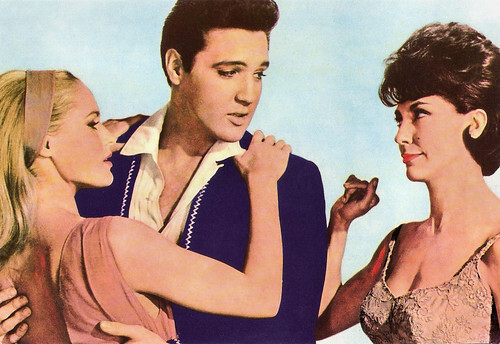
Spanish postcard by Postal Oscarcolor, no. 251. Photo: RCA. Ursula Andress, Elvis Presley and Elsa Cardenas in Fun in Acapulco (Richard Thorpe, 1963).
The first pop idol
Elvis Aaron Presley was born in Tupelo, Mississippi, in 1935. He moved with his family to Memphis, Tennessee when he was 13 years old. His musical career began in 1953 when he recorded a song at the later Sun Studio that was released on Sam Phillips' Sun Records.
Accompanied by guitarist Scotty Moore and bassist Bill Black, Presley became an early populariser of rockabilly, an uptempo, backbeat-driven fusion of country and rhythm and blues. The record company RCA Victor took over his contract in a deal prepared by Colonel Tom Parker, who would serve as the singer's manager for more than two decades.
Presley's first single 'That's All Right' was released in July 1954. This was followed by 'Heartbreak Hotel', an American number one hit, in January 1956. After a series of successful television appearances and records that reached the top of the sales charts, he was regarded as rock 'n' roll's most prominent figure. His energetic interpretations of songs and sexually provocative stage performances, combined with a remarkably appealing fusion of multi-ethnic influences that coincided with the rise of the civil rights movement, made him at once immensely popular and controversial.
America in the immediate post-World War II period saw great economic growth, with young people having more to spend. Individual development gradually became more important and so a youth culture emerged with various subcultures that opposed the older generation. Presley was the embodiment of this and thus became the first pop idol.
Elvis made his debut as an actor in the film Love Me Tender (Robert D. Webb, 1956). Although he was not at the top of the bill, the film's initial title, The Reno Brothers, was changed to capitalise on his last number one hit: 'Love Me Tender' had topped the charts earlier that month. To capitalise even more on Presley's popularity, four musical numbers were added to the original strict actor's role. Although critics cracked the film, it did well with filmgoers. Soon followed more films, including Jailhouse Rock (Richard Thorpe, 1957) and King Creole (Michael Curtiz, 1958) with Carolyn Jones and Walter Matthau, In 1958, he was drafted into the army.
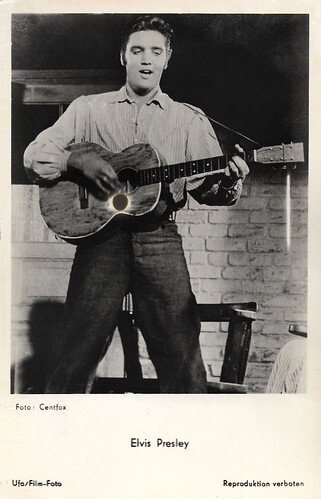
Austrian postcard by HDH Verlag (Hubmann), Wien. no. 6647 2. HDH Verlag was the Austrian licence holder for UFA/Film-Foto, Berlin. Photo: Centfox. Elvis Presley in Love Me Tender (Robert D. Webb, 1956).
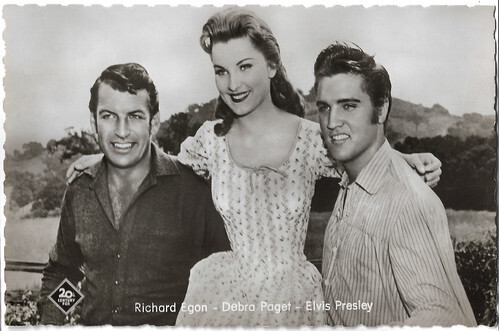
West-German postcard by Kolibri-Verlag G.m.b.H, Minden/Westf. no. 2482. Photo: 20th Century Fox. Richard Egan, Debra Paget and Elvis Presley in Love Me Tender (Robert D. Webb, 1956).
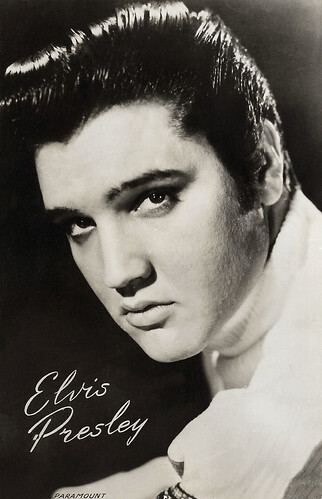
Dutch postcard by Takken, Utrecht, no. AX 3216. Photo: Paramount. Elvis Presley in Loving You (Hal Kanter, 1957).
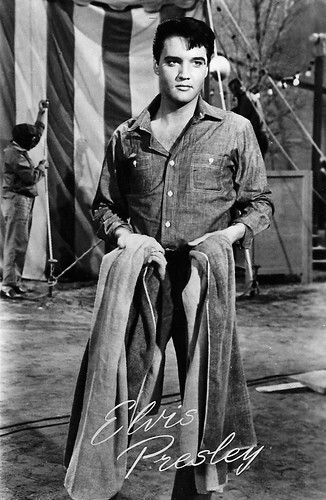
Dutch postcard by 't Sticht, Utrecht, no. AX 5901. Elvis Presley in Loving You (Hal Kanter, 1957).
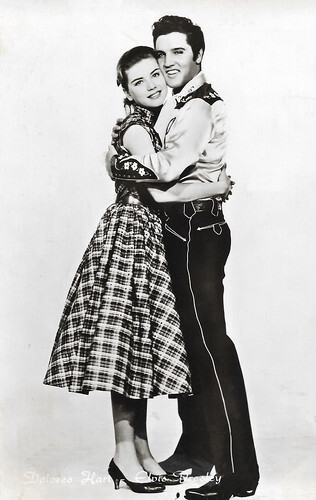
Dutch postcard by Gebr. Spanjersberg N.V., Rotterdam, no. 5350. Dolores Hart and Elvis Presley in Loving You (Hal Kanter, 1957).
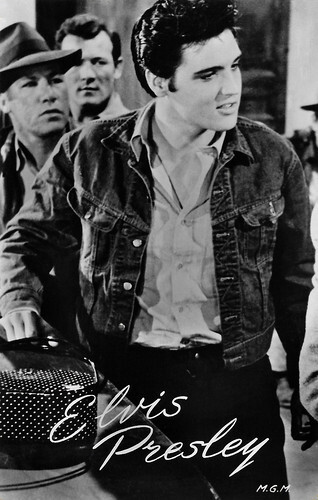
Dutch postcard by Uitgeverij Takken, Utrecht, no. AX 4499. Photo: M.G.M. Elvis Presley in Jailhouse Rock (Richard Thorpe, 1957).
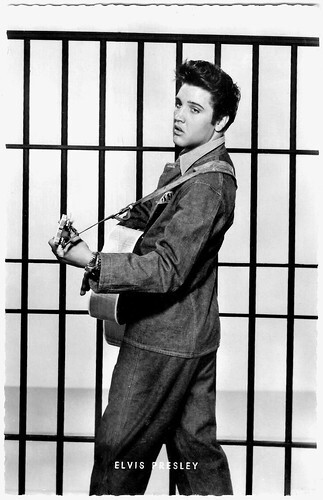
German postcard by Kunst und Bild (KB), Berlin-Charlottenburg, no. 1 296. Photo: MGM. Elvis Presley in Jailhouse Rock (Richard Thorpe, 1957).
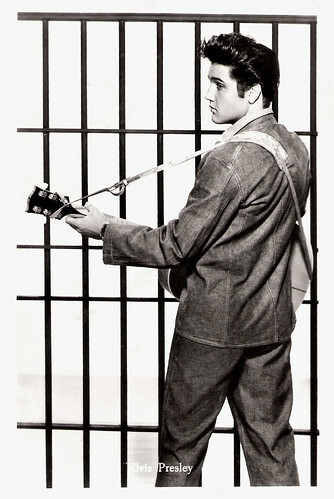
Dutch postcard by Gebr. Spanjersberg, Rotterdam / Antwerpen, no. 877. Photo: Elvis Presley in Jailhouse Rock (Richard Thorpe, 1957).
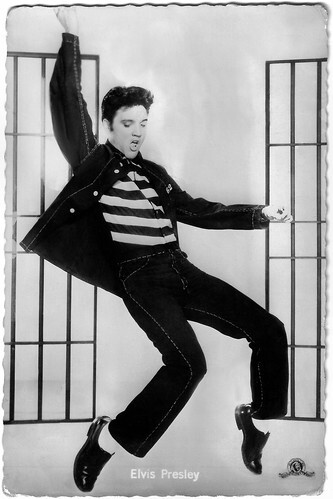
West-German postcard by Kolibri-Verlag, Minden/Westf., no. 2948. Photo: M.G.M. Elvis Presley in Jailhouse Rock (Richard Thorpe, 1957).
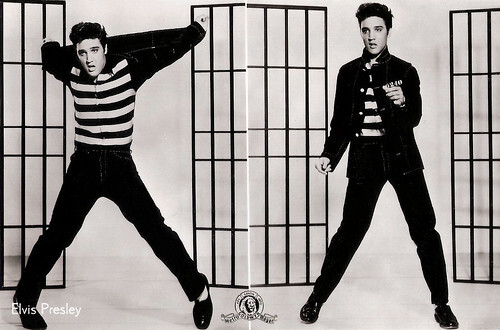
West-German postcard by Franz Josef Rüdel, Filmpostkartenverlag, Hamburg-Bergedorf, no. 2347. Photo: M.G.M. Elvis Presley in Jailhouse Rock (Richard Thorpe, 1957).
Formulaic, modest-budget musical film comedies
On 2 March 1960, Elvis Presley returned to the US and was given an honourable discharge with the rank of sergeant. The train taking him from New Jersey to Tennessee was stormed by a crowd the entire way. In Nashville, he recorded songs for a new album and the single 'Stuck on You', which quickly became a number one hit. Two weeks later, he recorded a pair of ballads that would become among his best-selling singles, 'It's Now or Never' and 'Are You Lonesome Tonight?'
In October, 'G.I. Blues' was a number one album. It was the soundtrack to Presley's first film since his return, G.I. Blues (Norman Taurog, 1960) with Juliet Prowse and Leticia Roman . On 25 March, another benefit concert took place in Hawaii, raising money for a memorial to the attack on Pearl Harbor. It was Presley's last public appearance for the next seven years.
Colonel Parker had manoeuvred Presley into a busy schedule of making formulaic, modest-budget musical film comedies. Initially, Presley insisted on pursuing serious roles, but when two films of a more dramatic nature - the Western Flaming Star (Don Siegel, 1960) with Steve Forrest and Dolores Del Rio , and Wild in the Country (Philip Dunne, 1961) with Tuesday Weld - met with less commercial success, he resigned himself to the formula.
Even among the 27 films, he made in the 1960s, there were still a few exceptions to the formula. In Viva Las Vegas (George Sidney, 1964) he met his perfect match in the stunningly beautiful Ann-Margret who was a more independent-than-usual female co-star. The film was a big hit. His other films were almost universally criticised, but almost all were profitable.
Hal Wallis, the producer of nine of these films, declared: "A Presley film is the only certainty Hollywood knows." After seven years of no live performances, Elvis returned to the stage in 1968 in the television comeback special Elvis, which resulted in a long series of concerts in Las Vegas and a series of highly profitable tours. In 1973, Presley performed in the first satellite concert broadcast worldwide, Aloha from Hawaii.
Long-term drug abuse ruined his health and Elvis Presley died in 1977 at the age of 42. With his wife Priscilla, he had one daughter Lisa Marie (1968). Presley is one of the best-selling solo artists in the history of the music industry with estimated sales of approximately 600 million records worldwide.
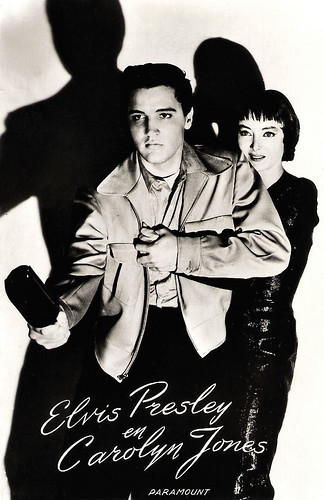
Dutch postcard by Uitg. Takken, Utrecht, no. AX 3978. Photo: Paramount. Elvis Presley and Carolyn Jones in King Creole (Michael Curtiz, 1958).
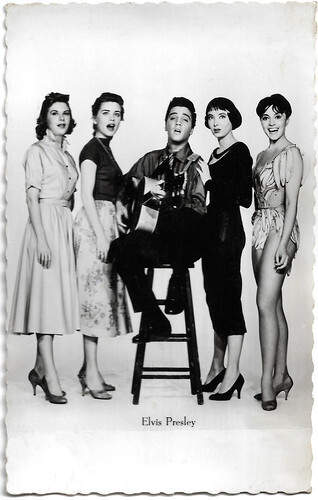
Dutch postcard by Drukkerij Uitg. Int. Filmpers, Amsterdam, no. 5019. Elvis Presley, Dolores Hart, Carolyn Jones, Liliane Montevecchi and Jan Shepard in King Creole (Michael Curtiz, 1958).
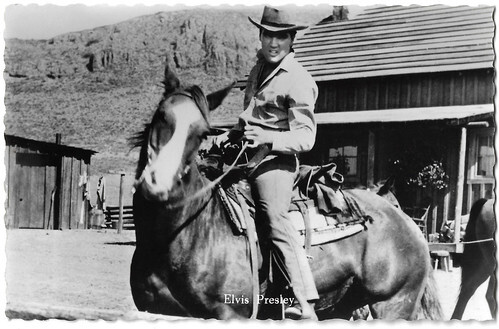
Dutch postcard by N.V. v.h. Weenenk & Snel, Baarn, no. 458. Photo: 20th Century Fox. Elvis Presley in Flaming Star (Don Siegel, 1960).
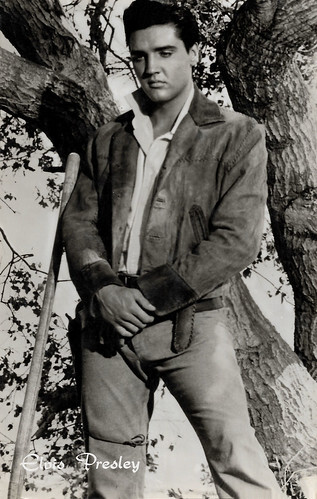
Dutch postcard by Int. Filmpers (I.F.P.), Amsterdam, no WPS 141. Elvis Presley in Flaming Star (Don Siegel, 1960).
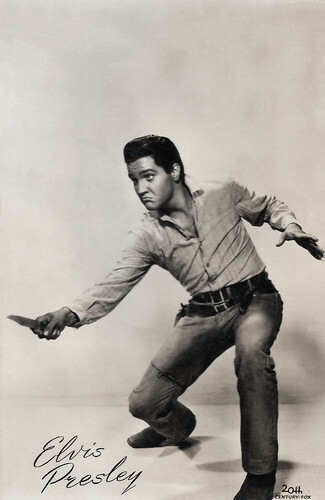
Dutch postcard by Uitgeverij Takken, Utrecht, no. AX 4571. Photo: 20th Century Fox. Elvis Presley in Flaming Star (Don Siegel, 1960).
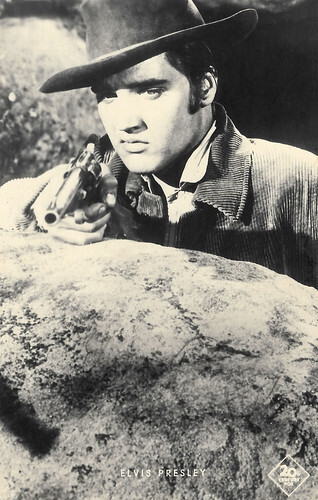
West-German postcard by Netter's Star Verlag, Berlin. Photo: 20th Century Fox. Elvis Presley in Flaming Star (Don Siegel, 1960).
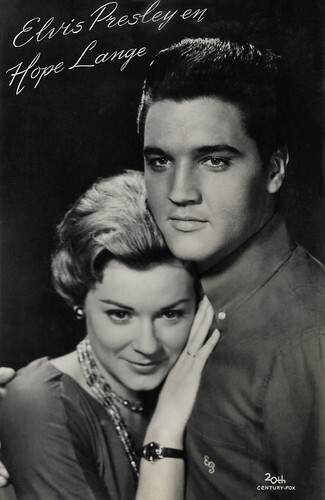
Dutch postcard by Uitgeverij Takken, Utrecht, no. AX 4673. Photo: 20th Century Fox. Elvis Presley and Hope Lange in Wild in the Country (Philip Dunne, 1961).
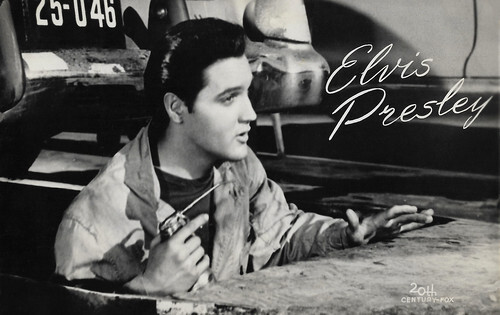
Dutch postcard by Uitg. Takken, Utrecht, no. AX 4694. Photo: 20th Century Fox. Elvis Presley in Wild in the Country (Philip Dunne, 1961).
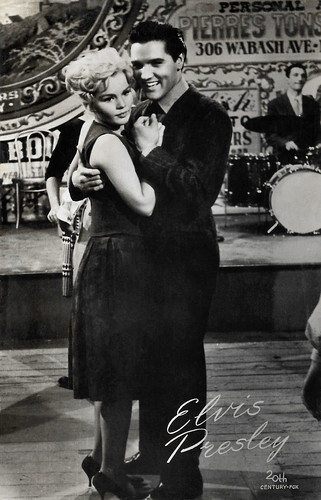
Dutch postcard by Uitg. Takken, Utrecht, no. AX 4695. Photo: 20th Century Fox. Elvis Presley and Tuesday Weld in Wild in the Country (Philip Dunne, 1961).
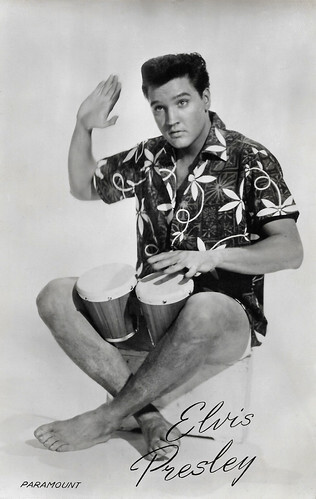
Dutch postcard by Uitg. Takken, Utrecht, no. AX 4870. Photo: Paramount. Elvis Presley in Blue Hawaii (Norman Taurog, 1961).
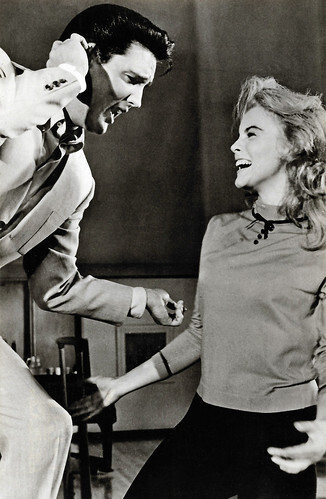
Romanian postcard by Casa Filmului Acin, no. 375. Elvis Presley and Ann-Margret in Viva Las Vegas (George Sidney, 1964).
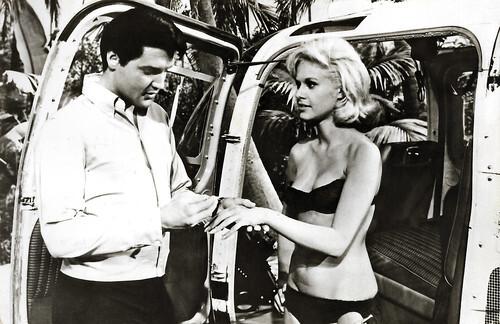
Vintage postcard. Elvis Presley and Suzanna Leigh in Paradise, Hawaiian Style (Michael D. Moore, 1966).
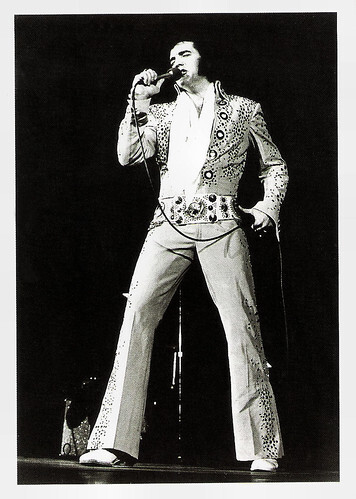
British postcard from 'The Elvis Presley Book of 30 Postcards' by Magna Books. Photo: MGM / British Film Institute. Elvis Presley in Elvis on Tour (Robert Abel, Pierre Adidge, 1972).
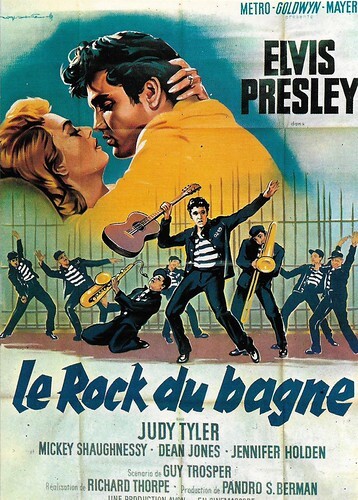
French postcard by Ed. F. Nugeron, no. E14. Reproduction of the French film poster for Jailhouse Rock (Richard Thorpe, 1957), starring Elvis Presley. Art by Roger Soubie.
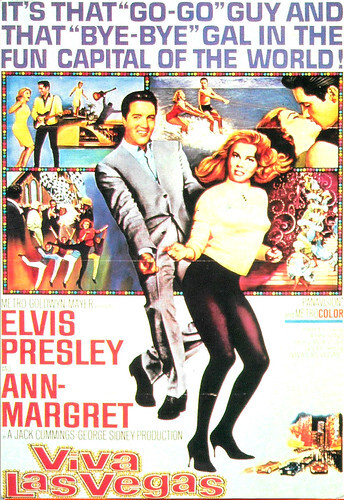
American postcard by Ed. Classico San Francisco, no. 110-070. Reproduction of the American film poster for Viva Las Vegas (George Sidney, 1964), starring Elvis Presley and Ann-Margret .
Sources: Wikipedia (Dutch and German), and .

Dutch postcard. Elvis Presley in Flaming Star (Don Siegel, 1960).

Dutch postcard, Serie 6. Elvis Presley in Flaming Star (Don Siegel, 1960).

German postcard by Krüger, no. 902/145. Photo: UFA. Elvis Presley in Blue Hawaii (Norman Taurog, 1961) with Pamela Austin, Joan Blackman, Jenny Maxwell, Darlene Tompkins, and Nancy Walters.

Vintage postcard, no. 3. Laurel Goodwin, Elvis Presley and Stella Stevens in Girls! Girls! Girls! (Norman Taurog, 1962).

Spanish postcard by Postal Oscarcolor, no. 251. Photo: RCA. Ursula Andress, Elvis Presley and Elsa Cardenas in Fun in Acapulco (Richard Thorpe, 1963).
The first pop idol
Elvis Aaron Presley was born in Tupelo, Mississippi, in 1935. He moved with his family to Memphis, Tennessee when he was 13 years old. His musical career began in 1953 when he recorded a song at the later Sun Studio that was released on Sam Phillips' Sun Records.
Accompanied by guitarist Scotty Moore and bassist Bill Black, Presley became an early populariser of rockabilly, an uptempo, backbeat-driven fusion of country and rhythm and blues. The record company RCA Victor took over his contract in a deal prepared by Colonel Tom Parker, who would serve as the singer's manager for more than two decades.
Presley's first single 'That's All Right' was released in July 1954. This was followed by 'Heartbreak Hotel', an American number one hit, in January 1956. After a series of successful television appearances and records that reached the top of the sales charts, he was regarded as rock 'n' roll's most prominent figure. His energetic interpretations of songs and sexually provocative stage performances, combined with a remarkably appealing fusion of multi-ethnic influences that coincided with the rise of the civil rights movement, made him at once immensely popular and controversial.
America in the immediate post-World War II period saw great economic growth, with young people having more to spend. Individual development gradually became more important and so a youth culture emerged with various subcultures that opposed the older generation. Presley was the embodiment of this and thus became the first pop idol.
Elvis made his debut as an actor in the film Love Me Tender (Robert D. Webb, 1956). Although he was not at the top of the bill, the film's initial title, The Reno Brothers, was changed to capitalise on his last number one hit: 'Love Me Tender' had topped the charts earlier that month. To capitalise even more on Presley's popularity, four musical numbers were added to the original strict actor's role. Although critics cracked the film, it did well with filmgoers. Soon followed more films, including Jailhouse Rock (Richard Thorpe, 1957) and King Creole (Michael Curtiz, 1958) with Carolyn Jones and Walter Matthau, In 1958, he was drafted into the army.

Austrian postcard by HDH Verlag (Hubmann), Wien. no. 6647 2. HDH Verlag was the Austrian licence holder for UFA/Film-Foto, Berlin. Photo: Centfox. Elvis Presley in Love Me Tender (Robert D. Webb, 1956).

West-German postcard by Kolibri-Verlag G.m.b.H, Minden/Westf. no. 2482. Photo: 20th Century Fox. Richard Egan, Debra Paget and Elvis Presley in Love Me Tender (Robert D. Webb, 1956).

Dutch postcard by Takken, Utrecht, no. AX 3216. Photo: Paramount. Elvis Presley in Loving You (Hal Kanter, 1957).

Dutch postcard by 't Sticht, Utrecht, no. AX 5901. Elvis Presley in Loving You (Hal Kanter, 1957).

Dutch postcard by Gebr. Spanjersberg N.V., Rotterdam, no. 5350. Dolores Hart and Elvis Presley in Loving You (Hal Kanter, 1957).

Dutch postcard by Uitgeverij Takken, Utrecht, no. AX 4499. Photo: M.G.M. Elvis Presley in Jailhouse Rock (Richard Thorpe, 1957).

German postcard by Kunst und Bild (KB), Berlin-Charlottenburg, no. 1 296. Photo: MGM. Elvis Presley in Jailhouse Rock (Richard Thorpe, 1957).

Dutch postcard by Gebr. Spanjersberg, Rotterdam / Antwerpen, no. 877. Photo: Elvis Presley in Jailhouse Rock (Richard Thorpe, 1957).

West-German postcard by Kolibri-Verlag, Minden/Westf., no. 2948. Photo: M.G.M. Elvis Presley in Jailhouse Rock (Richard Thorpe, 1957).

West-German postcard by Franz Josef Rüdel, Filmpostkartenverlag, Hamburg-Bergedorf, no. 2347. Photo: M.G.M. Elvis Presley in Jailhouse Rock (Richard Thorpe, 1957).
Formulaic, modest-budget musical film comedies
On 2 March 1960, Elvis Presley returned to the US and was given an honourable discharge with the rank of sergeant. The train taking him from New Jersey to Tennessee was stormed by a crowd the entire way. In Nashville, he recorded songs for a new album and the single 'Stuck on You', which quickly became a number one hit. Two weeks later, he recorded a pair of ballads that would become among his best-selling singles, 'It's Now or Never' and 'Are You Lonesome Tonight?'
In October, 'G.I. Blues' was a number one album. It was the soundtrack to Presley's first film since his return, G.I. Blues (Norman Taurog, 1960) with Juliet Prowse and Leticia Roman . On 25 March, another benefit concert took place in Hawaii, raising money for a memorial to the attack on Pearl Harbor. It was Presley's last public appearance for the next seven years.
Colonel Parker had manoeuvred Presley into a busy schedule of making formulaic, modest-budget musical film comedies. Initially, Presley insisted on pursuing serious roles, but when two films of a more dramatic nature - the Western Flaming Star (Don Siegel, 1960) with Steve Forrest and Dolores Del Rio , and Wild in the Country (Philip Dunne, 1961) with Tuesday Weld - met with less commercial success, he resigned himself to the formula.
Even among the 27 films, he made in the 1960s, there were still a few exceptions to the formula. In Viva Las Vegas (George Sidney, 1964) he met his perfect match in the stunningly beautiful Ann-Margret who was a more independent-than-usual female co-star. The film was a big hit. His other films were almost universally criticised, but almost all were profitable.
Hal Wallis, the producer of nine of these films, declared: "A Presley film is the only certainty Hollywood knows." After seven years of no live performances, Elvis returned to the stage in 1968 in the television comeback special Elvis, which resulted in a long series of concerts in Las Vegas and a series of highly profitable tours. In 1973, Presley performed in the first satellite concert broadcast worldwide, Aloha from Hawaii.
Long-term drug abuse ruined his health and Elvis Presley died in 1977 at the age of 42. With his wife Priscilla, he had one daughter Lisa Marie (1968). Presley is one of the best-selling solo artists in the history of the music industry with estimated sales of approximately 600 million records worldwide.

Dutch postcard by Uitg. Takken, Utrecht, no. AX 3978. Photo: Paramount. Elvis Presley and Carolyn Jones in King Creole (Michael Curtiz, 1958).

Dutch postcard by Drukkerij Uitg. Int. Filmpers, Amsterdam, no. 5019. Elvis Presley, Dolores Hart, Carolyn Jones, Liliane Montevecchi and Jan Shepard in King Creole (Michael Curtiz, 1958).

Dutch postcard by N.V. v.h. Weenenk & Snel, Baarn, no. 458. Photo: 20th Century Fox. Elvis Presley in Flaming Star (Don Siegel, 1960).

Dutch postcard by Int. Filmpers (I.F.P.), Amsterdam, no WPS 141. Elvis Presley in Flaming Star (Don Siegel, 1960).

Dutch postcard by Uitgeverij Takken, Utrecht, no. AX 4571. Photo: 20th Century Fox. Elvis Presley in Flaming Star (Don Siegel, 1960).

West-German postcard by Netter's Star Verlag, Berlin. Photo: 20th Century Fox. Elvis Presley in Flaming Star (Don Siegel, 1960).

Dutch postcard by Uitgeverij Takken, Utrecht, no. AX 4673. Photo: 20th Century Fox. Elvis Presley and Hope Lange in Wild in the Country (Philip Dunne, 1961).

Dutch postcard by Uitg. Takken, Utrecht, no. AX 4694. Photo: 20th Century Fox. Elvis Presley in Wild in the Country (Philip Dunne, 1961).

Dutch postcard by Uitg. Takken, Utrecht, no. AX 4695. Photo: 20th Century Fox. Elvis Presley and Tuesday Weld in Wild in the Country (Philip Dunne, 1961).

Dutch postcard by Uitg. Takken, Utrecht, no. AX 4870. Photo: Paramount. Elvis Presley in Blue Hawaii (Norman Taurog, 1961).

Romanian postcard by Casa Filmului Acin, no. 375. Elvis Presley and Ann-Margret in Viva Las Vegas (George Sidney, 1964).

Vintage postcard. Elvis Presley and Suzanna Leigh in Paradise, Hawaiian Style (Michael D. Moore, 1966).

British postcard from 'The Elvis Presley Book of 30 Postcards' by Magna Books. Photo: MGM / British Film Institute. Elvis Presley in Elvis on Tour (Robert Abel, Pierre Adidge, 1972).

French postcard by Ed. F. Nugeron, no. E14. Reproduction of the French film poster for Jailhouse Rock (Richard Thorpe, 1957), starring Elvis Presley. Art by Roger Soubie.

American postcard by Ed. Classico San Francisco, no. 110-070. Reproduction of the American film poster for Viva Las Vegas (George Sidney, 1964), starring Elvis Presley and Ann-Margret .
Sources: Wikipedia (Dutch and German), and .
Published on September 29, 2022 22:00
September 28, 2022
Hans Junkermann
Hans Junkermann (1872-1943) was a prolific German character comedian, noted for his gauche manner and walrus moustache. In films from 1911, including a brief 1930 sojourn in Hollywood, acting in German-language versions of American films under the direction of Jacques Feyder. Subsequently, he was seen in many German A-grade productions until his death in 1943. He was married to the Austrian actress Julia Serda and he was the brother of Fritz Junkermann, about whom we posted last week.
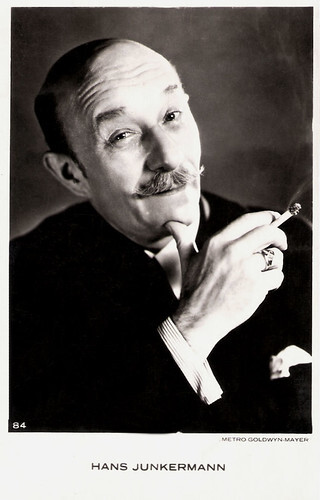
Dutch postcard, no. 84. Photo: Metro-Goldwyn-Mayer.
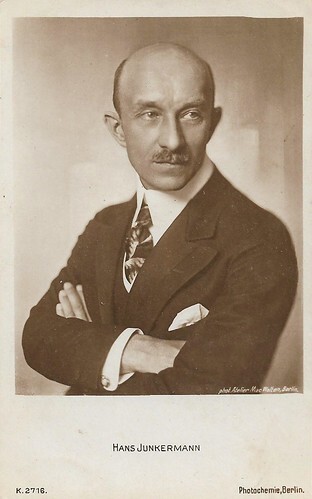
German postcard by Photochemie, Berlin, no. K.2716. Photo: Atelier Mac Walten, Berlin.
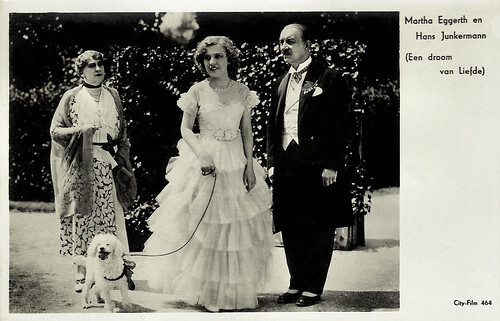
Dutch postcard by City Film, no. 464. Marta Eggerth and Hans Junkermann in Traum von Schönbrunn/Dream of Schönbrunn (Johannes Meyer, 1932). Sent by mail in 1934.
Aristocrats, high-ranked military, circus managers and police commissioners
Hans Ferdinand Junkermann was born in 1872 in Stuttgart. He was the son of the court actor August Junkermann and his wife, the actress Rosa Le Seur. His brother Fritz Junkermann was also an actor. Hans graduated from high school and joined his father's touring theatre company after dropping out of his studies at a military pedagogy school in Berlin.
This was followed by a theatre tour of the USA and his debut in the play 'Onkel Bräsig' by Fritz Reuter in 1893 at the Zentral-Theater Berlin, where his father had taken over the management. Junkermann's other stations as a theatre actor were the Thalia Theatre in Hamburg in 1895, the Weimar Theatre, the Court Theatre in Wiesbaden and from 1896 the Thalia Theatre in Berlin. From 1902 to 1915 he belonged to the ensemble of the Trianon Theatre.
In 1911 Hans Junkermann made his debut as a silent film actor in Vater und Sohn/Father and Son (Walter Schmidthässler, 1910) with Alwin Neuss for Vitascope. Director Max Mack engaged him in 1913 for the film Wo ist Coletti?/Where is Coletti? (Max Mack, 1913). After the film became a success, he got many other offers to play in films, so Hans Junkermann decided against the theatre and cancelled his contract with the Trianon theatre. He limited himself to guest appearances at Berlin stages in the following years.
The lanky Junkermann, whose trademark was his moustache, developed into a busy supporting actor in German films. Thomas Staedeli at IMDb compares him to the American film comedian James Finlayson, an actor in many Laurel & Hardy films. Junkermann played Polonius in Hamlet (Heinz Schall, Svend Gade, 1921), the German film adaptation of the William Shakespeare play 'Hamlet' starring and produced by Danish silent film actress Asta Nielsen . He also played a supporting role in Maciste und die Tochter des Silberkönigs/Maciste e la figlia del re dell'argento/Maciste and the Silver King's Daughter (Luigi Romano Borgnetto, 1922), a German-Italian silent epic film starring Bartolomeo Pagano , and Helena Makowska .
He also appeared in the silent comedy Prinzessin Trulala/Princess Trulala (Erich Schönfelder, Richard Eichberg, 1926) starring Lilian Harvey , Dina Gralla and Harry Halm , and the silent comedy Durchlaucht Radieschen/Highness Radish (Eichberg, 1926-27) with Xenia Desni . In 1928 Junkermann had a rare starring role opposite Adele Sandrock in the comedy Serenissimus, der Vielgeliebte, und die letzte Jungfrau/Serenissimus (Leo Mittler, 1928). All in all, until 1930 Hans Junkermann acted in over 110 German silent films, often in supporting parts such as aristocrats, high-ranked military, circus and vaudeville managers, impresarios and police commissioners.
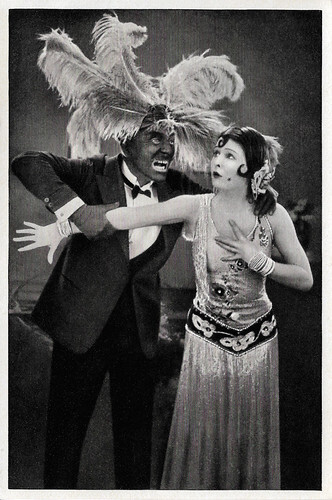
German collectors card by Ross Verlag in the series Vom Werden deutscher Filmkunst - Der Stumme Film, picture no. 123, group 43. Photo: Eichberg-Film. Lilian Harvey and Hans Junkermann in Die tolle Lola/Fabulous Lola (Richard Eichberg, 1927).
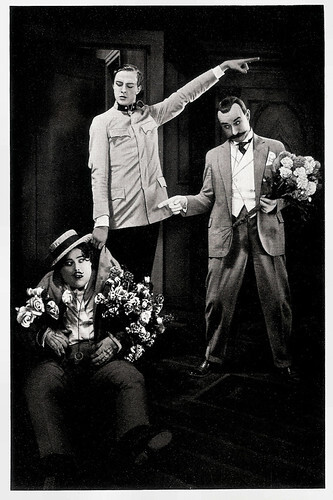
German collectors card by Ross Verlag in the series Vom Werden deutscher Filmkunst - Der Stumme Film, picture no. 199, group 43. Photo: Eichberg-Film. Werner Fuetterer and Hans Junkermann in Durchlaucht Radieschen/Highness Radish (Richard Eichberg, 1927).
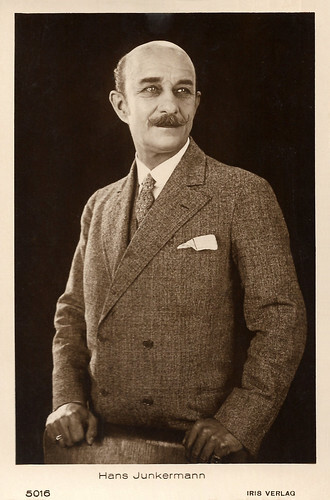
Austrian postcard by Iris Verlag, no. 5016.
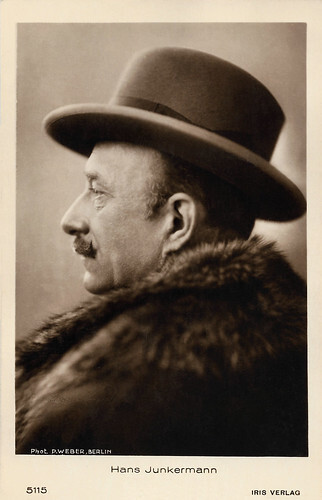
Austrian postcard by Iris-Verlag, no. 5115. Photo: P. Weber, Berlin.
In Hollywood with Greta Garbo
In 1930 Hans Junkermann appeared three times in Hollywood in German versions of American productions. The most famous is Anna Christie (Jacques Feyder, 1930), a German-language film adapted from the 1921 Eugene O'Neill play of the same title and he filmed following the release of the English-language original version of the same adaptation earlier the same year. Both versions feature leading actress Greta Garbo .
In the early years of sound films, Hollywood studios produced foreign-language versions of some of their films using the same sets and sometimes the same costumes, with native speakers of the language usually replacing some or all of the original cast. The German-language version of Anna Christie is one of the few that survives.
Back in Germany, he took over the management of the Schauspielhaus Steglitz from 1931 to 1934, and in 1933 he co-founded the film and stage club Kameradschaft der Deutschen Künstler. He was furthermore employed by Harry Piel for films such as Pipin der Kurze/Pipin, the short one (Carl Heinz Wolff, 1934) with Heinz Rühmann , and Artisten/Artists (Harry Piel, 1935) where he impersonated one of his most imposing roles.
In 1940 he received the appointment as a state actor. Hans Junkermann was on stage at Berlin theatres until the end, for example at the Theater am Schiffbauerdamm. His last appearance was in Akrobat schö-ö-ön/Acrobat Beau-eau-eautiful! (Wolfgang Staudte, 1943) at Charlie Rivel's side.
Fritz Junkermann died in Berlin in 1943 at the age of 71. His grave in the Heerstraße cemetery in Berlin-Westend has not been preserved. Junkermann was married to the actress Julia Serda from 1911 and was the stepfather of actress and photographer Charlott(e) Serda.
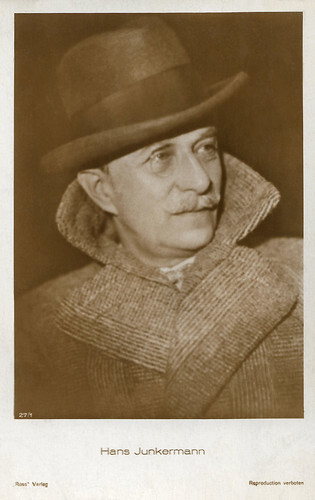
German postcard by Ross Verlag, no. 27/1 (?).
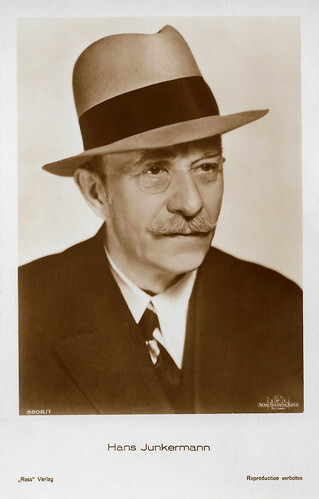
German postcard by Ross Verlag, no. 5508/1, 1930-1931. Photo: Metro-Goldwyn-Mayer.
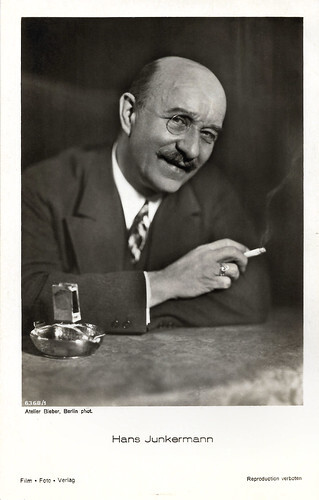
German postcard by Film-Foto-Verlag, no. 6368/1, 1931-1932. Photo: Atelier Bieber, Berlin.
Sources: Thomas Staedeli (Cyranos), Wikipedia (German and English), and .

Dutch postcard, no. 84. Photo: Metro-Goldwyn-Mayer.

German postcard by Photochemie, Berlin, no. K.2716. Photo: Atelier Mac Walten, Berlin.

Dutch postcard by City Film, no. 464. Marta Eggerth and Hans Junkermann in Traum von Schönbrunn/Dream of Schönbrunn (Johannes Meyer, 1932). Sent by mail in 1934.
Aristocrats, high-ranked military, circus managers and police commissioners
Hans Ferdinand Junkermann was born in 1872 in Stuttgart. He was the son of the court actor August Junkermann and his wife, the actress Rosa Le Seur. His brother Fritz Junkermann was also an actor. Hans graduated from high school and joined his father's touring theatre company after dropping out of his studies at a military pedagogy school in Berlin.
This was followed by a theatre tour of the USA and his debut in the play 'Onkel Bräsig' by Fritz Reuter in 1893 at the Zentral-Theater Berlin, where his father had taken over the management. Junkermann's other stations as a theatre actor were the Thalia Theatre in Hamburg in 1895, the Weimar Theatre, the Court Theatre in Wiesbaden and from 1896 the Thalia Theatre in Berlin. From 1902 to 1915 he belonged to the ensemble of the Trianon Theatre.
In 1911 Hans Junkermann made his debut as a silent film actor in Vater und Sohn/Father and Son (Walter Schmidthässler, 1910) with Alwin Neuss for Vitascope. Director Max Mack engaged him in 1913 for the film Wo ist Coletti?/Where is Coletti? (Max Mack, 1913). After the film became a success, he got many other offers to play in films, so Hans Junkermann decided against the theatre and cancelled his contract with the Trianon theatre. He limited himself to guest appearances at Berlin stages in the following years.
The lanky Junkermann, whose trademark was his moustache, developed into a busy supporting actor in German films. Thomas Staedeli at IMDb compares him to the American film comedian James Finlayson, an actor in many Laurel & Hardy films. Junkermann played Polonius in Hamlet (Heinz Schall, Svend Gade, 1921), the German film adaptation of the William Shakespeare play 'Hamlet' starring and produced by Danish silent film actress Asta Nielsen . He also played a supporting role in Maciste und die Tochter des Silberkönigs/Maciste e la figlia del re dell'argento/Maciste and the Silver King's Daughter (Luigi Romano Borgnetto, 1922), a German-Italian silent epic film starring Bartolomeo Pagano , and Helena Makowska .
He also appeared in the silent comedy Prinzessin Trulala/Princess Trulala (Erich Schönfelder, Richard Eichberg, 1926) starring Lilian Harvey , Dina Gralla and Harry Halm , and the silent comedy Durchlaucht Radieschen/Highness Radish (Eichberg, 1926-27) with Xenia Desni . In 1928 Junkermann had a rare starring role opposite Adele Sandrock in the comedy Serenissimus, der Vielgeliebte, und die letzte Jungfrau/Serenissimus (Leo Mittler, 1928). All in all, until 1930 Hans Junkermann acted in over 110 German silent films, often in supporting parts such as aristocrats, high-ranked military, circus and vaudeville managers, impresarios and police commissioners.

German collectors card by Ross Verlag in the series Vom Werden deutscher Filmkunst - Der Stumme Film, picture no. 123, group 43. Photo: Eichberg-Film. Lilian Harvey and Hans Junkermann in Die tolle Lola/Fabulous Lola (Richard Eichberg, 1927).

German collectors card by Ross Verlag in the series Vom Werden deutscher Filmkunst - Der Stumme Film, picture no. 199, group 43. Photo: Eichberg-Film. Werner Fuetterer and Hans Junkermann in Durchlaucht Radieschen/Highness Radish (Richard Eichberg, 1927).

Austrian postcard by Iris Verlag, no. 5016.

Austrian postcard by Iris-Verlag, no. 5115. Photo: P. Weber, Berlin.
In Hollywood with Greta Garbo
In 1930 Hans Junkermann appeared three times in Hollywood in German versions of American productions. The most famous is Anna Christie (Jacques Feyder, 1930), a German-language film adapted from the 1921 Eugene O'Neill play of the same title and he filmed following the release of the English-language original version of the same adaptation earlier the same year. Both versions feature leading actress Greta Garbo .
In the early years of sound films, Hollywood studios produced foreign-language versions of some of their films using the same sets and sometimes the same costumes, with native speakers of the language usually replacing some or all of the original cast. The German-language version of Anna Christie is one of the few that survives.
Back in Germany, he took over the management of the Schauspielhaus Steglitz from 1931 to 1934, and in 1933 he co-founded the film and stage club Kameradschaft der Deutschen Künstler. He was furthermore employed by Harry Piel for films such as Pipin der Kurze/Pipin, the short one (Carl Heinz Wolff, 1934) with Heinz Rühmann , and Artisten/Artists (Harry Piel, 1935) where he impersonated one of his most imposing roles.
In 1940 he received the appointment as a state actor. Hans Junkermann was on stage at Berlin theatres until the end, for example at the Theater am Schiffbauerdamm. His last appearance was in Akrobat schö-ö-ön/Acrobat Beau-eau-eautiful! (Wolfgang Staudte, 1943) at Charlie Rivel's side.
Fritz Junkermann died in Berlin in 1943 at the age of 71. His grave in the Heerstraße cemetery in Berlin-Westend has not been preserved. Junkermann was married to the actress Julia Serda from 1911 and was the stepfather of actress and photographer Charlott(e) Serda.

German postcard by Ross Verlag, no. 27/1 (?).

German postcard by Ross Verlag, no. 5508/1, 1930-1931. Photo: Metro-Goldwyn-Mayer.

German postcard by Film-Foto-Verlag, no. 6368/1, 1931-1932. Photo: Atelier Bieber, Berlin.
Sources: Thomas Staedeli (Cyranos), Wikipedia (German and English), and .
Published on September 28, 2022 22:00
September 27, 2022
La Collectionneuse: actresses posing with sunshades
Summer has ended. Let’s extend it a little bit by putting the spotlight on sunshades. Here is a selection of vintage postcards showing film actresses posing with this accessory, which was much in vogue at a time when sun tanning was considered unbecoming and inappropriate for women.
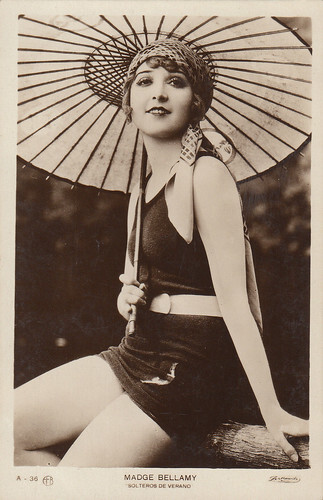
Spanish postcard by Editorial Fotografica, Barcelona, no. A-36. Madge Bellamy in Summer Bachelors (Allan Dwan, 1926).
Madge Bellamy (1899-1990), was a “Darling of the Twenties”. That’s the title she chose for her autobiography, published in 1989. She appeared in about fifty silent films and a dozen sound films. Under contract to Thomas H. Ince, she had her breakthrough role in Lorna Doone (1922). Later, she was a star at Fox studios from 1925 to 1929.
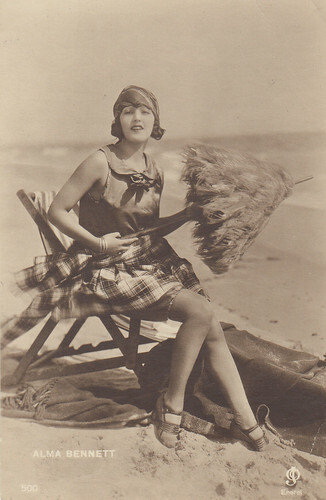
Danish postcard by J. Chr. Olsens Kunstforlag. Eneret, no. 500.
Alluring brunette Alma Bennett (1904-1958)‘s best-remembered role is probably the vamp Bebe Blair in Frank Capra’s Long Pants (1927), starring Harry Langdon. She also played in Westerns, such as Three Jumps Ahead (1923) with Tom Mix, and appeared in several Mack Sennett comedy shorts alongside Ben Turpin, Billy Bevan or Eddie Quillan.
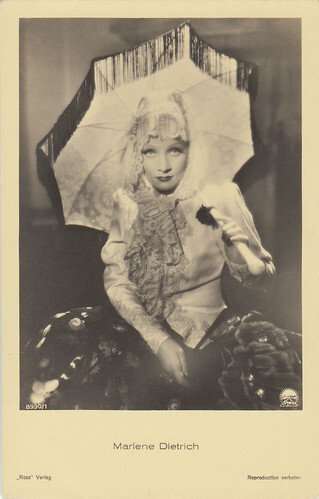
German postcard by Ross Verlag, no. 8990/1, 1933-1934. Photo: Paramount.
Marlene Dietrich (1901-1992) is regarded as the first German actress to become successful in Hollywood. Throughout her long career, she constantly re-invented herself, starting as a cabaret singer, chorus girl and film actress in 1920s Berlin, she became a Hollywood movie star in the 1930s, a World War II frontline entertainer, and finally an international stage show performer from the 1950s to the 1970s, eventually becoming one of the entertainment icons of the 20th century.
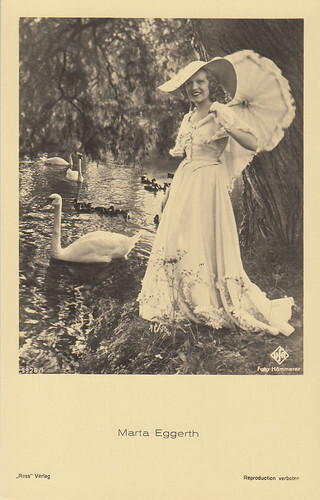
German postcard by Ross Verlag, no. 9928/1, 1935-1936. Photo: Hämmerer / Ufa. Marta Eggerth in Das Hofkonzert/The Court Concert (Detlev Sierck a.k.a. Douglas Sirk, 1936).
Hungarian-born singer and actress Márta Eggerth (1912-2013) maintained a global career for over 70 years. She was the popular and talented star of 30 German and Austrian operetta films of the 1930s. Many of the 20th century's most famous operetta composers, including Franz Lehár, Fritz Kreisler, Robert Stolz, Oscar Straus, and Paul Abraham, composed works especially for her. After the rise of the Nazis, she continued her career with her partner Jan Kiepura in the US.
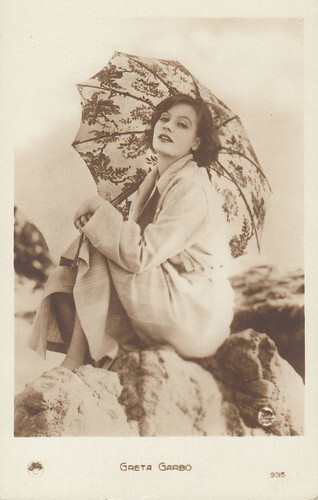
French postcard by Europe, no. 935. Photo: Metro-Goldwyn-Mayer.
Swedish Greta Garbo (1905-1990) was one of the greatest and most glamorous film stars ever produced by the Hollywood studio system. She was part of the Golden Age of the silent cinema of the 1920s and was one of the few actors who made a glorious transition to the talkies. She started her career in European cinema and would always stay more popular in Europe than in the USA.
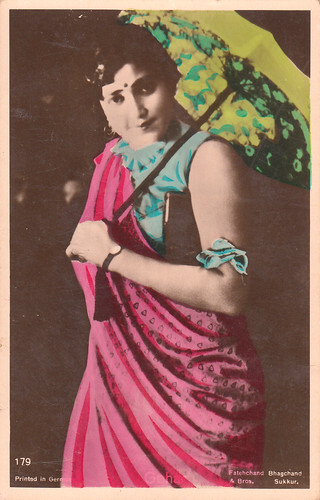
Postcard printed in Germany for Fatehchand Bhagchand & Bros. Sukkur, no. 179.
Gohar (1910-1985) was a major Indian star from 1925 to 1939. Her films include Typist Girl (1926), Gun Sundari (1927), Devi Devayani (1931), Sati Savitri (1932), Miss 1933 (1933), etc. In 1929, she founded the Ranjit Film Company, in association with director Chandulal Shah. In 1931, it became Ranjit Movietone and soon the company placed itself among the most important Indian film studios of the time. Gohar’s last film, Achhut (1939) dealt with the subject of the Untouchable caste.
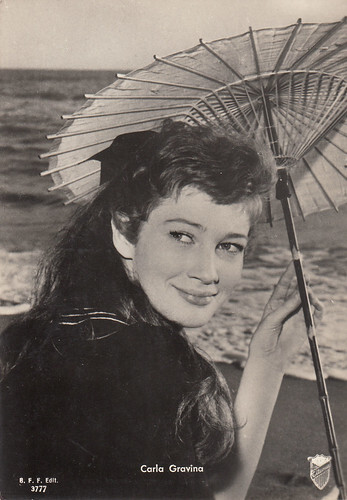
Italian postcard by B.F.F. Edit. (Casa Editr. Ballerini & Fratini, Firenze), no. 3777. Photo: Titanus.
Carla Gravina (1941) was a popular Italian actress. Her films include Primo amore (1959), Esterina (1959), Jovanka e le altre (1961), La monaca di Monza (1969), Alfredo Alfredo (1972), L’Antecristo (1974) or Il lungo silenzio (1993). In the 1970s, she played opposite the two leading male French sex symbols of the time: Jean-Paul Belmondo in L’héritier (1973) and Alain Delon in Comme un boomerang (1976). She won a Best Supporting Actress Award at the Cannes Film Festival for La Terrazza (1980). She also had a successful career on stage and on television.
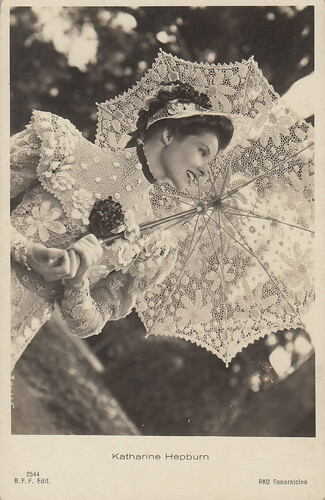
Italian postcard by Ballerini & Fratini, Firenze, no. 2544. Photo: RKO / Generalcine.
Katharine Hepburn (1907-2003) was an indomitable American stage and film actress, known as a spirited performer with a touch of eccentricity. She introduced into her roles a strength of character previously considered to be undesirable in Hollywood leading ladies. As an actress, she was noted for her brisk upper-class New England accent and tomboyish beauty. During her long career, she won four Best Actress Oscars, for Morning Glory (1933), Guess Who’s Coming to Dinner (1967), The Lion in Winter (1968), and On Golden Pond (1981).
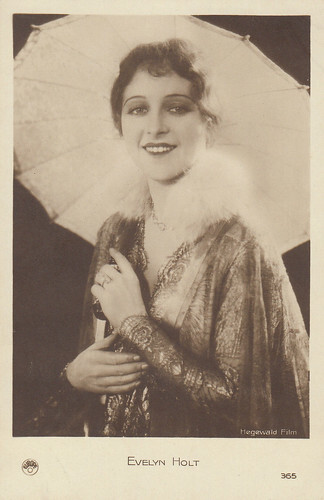 Card Evelyn Holt
Card Evelyn Holt
French postcard by Europe, no. 365. Photo: Hegewald Film. Evelyn Holt in Freiwild/Free game (Holger-Madsen, 1928).
Evelyn Holt (1908-2001) was a highly popular German film actress in the late silent and the early sound era.
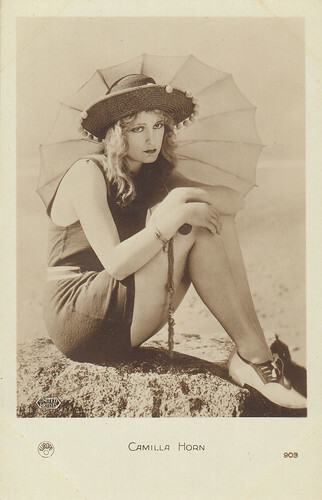
French postcard by Europe, no. 903. Photo: United Artists.
Ethereally blonde Camilla Horn (1903-1996) was a German dancer and film star. Her breakthrough role was Gretchen in the silent film classic Faust (Friedrich Wilhelm Murnau, 1926). She also starred in some Hollywood films of the late 1920s and in a few British and Italian productions.
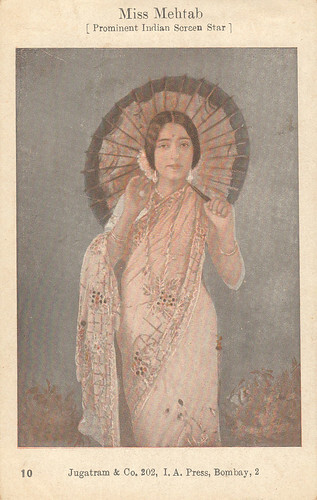
Indian postcard by Jugatram & Co., Bombay, no. 10. Caption: Prominent Indian Screen Star.
Mehtab (1913-1997) was an Indian film star who mainly worked in the 1930s and the first part of the 1940s. Her films include Veer Kunal (1932), Jeewan Swapna (1937) or Leather Face (1939). Chitralehka (1941) caused a sensation because of her aesthetically done bathing scene, which was considered daring at the time. Her last husband was famous filmmaker Sohrab Modi.
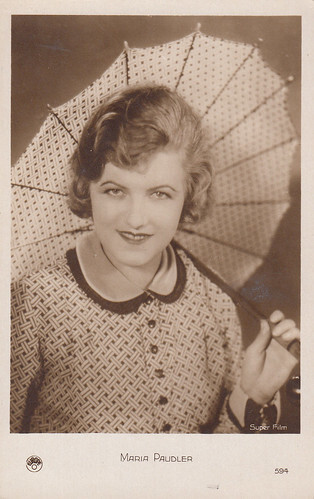
French postcard by Europe, no. 594. Photo: Super Film.
German actress Maria Paudler (1903-1990) was a popular star of the late silent German cinema. She also played the leading role in the first German TV film.
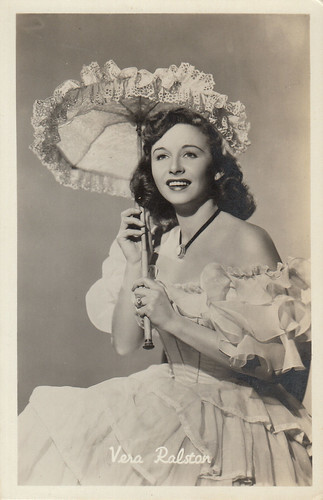
Belgian postcard by Nieuwe Merksemsche Chocolaterie S.P.R.L. Merksem (Anvers).
An accomplished figure skater, Czechoslovakian-born Vera Ralston (1919 ? 1920 ? 1921 ? 1923 ? -2003) emigrated to the U.S.A. in 1939. She made her film debut in two ice-skating movies for Republic studios, Ice Capades (1941) and Ice Capades Revue (1942), before signing a long-term contract with them in 1943. Herbert Yates, the company’s boss, fell in love with her and they married in 1952. From 1944 to 1958, she starred in twenty-four movies, including two with John Wayne, Dakota (1945) and The Fighting Kentuckian (1949).
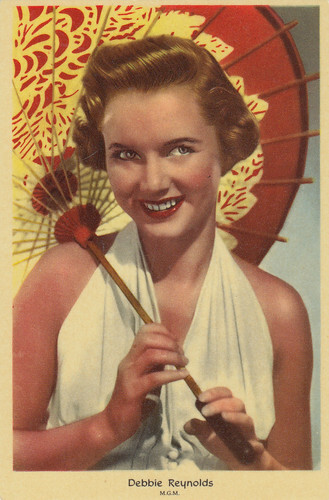
Vintage postcard. Photo: M.G.M.
Debbie Reynolds (1932-2016) was elected Miss Burbank in 1948 and made her screen debut the same year. In 1950, she gained notice by playing Helen Kane in Three Little Words and by singing 'Aba Daba Honeymoon', which was a hit on the Billboard charts, in Two Weeks with Love (1950). She had her breakthrough role in Singin’ in the Rain (1952), opposite Gene Kelly and Donald O’Connor. She then starred in twenty-six movies from 1953 to 1968. Afterwards, she was much more active on television than in films.
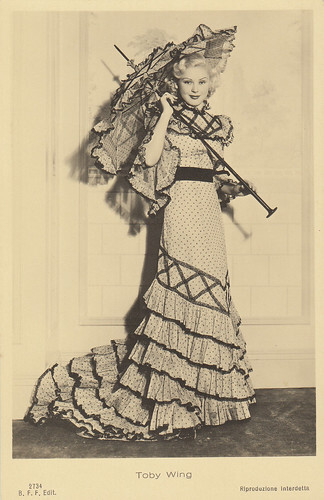
Italian postcard by Ballerini & Fratini, Firenze, no. 2734.
Toby Wing (1915-2001) was one of the cutest 1930s Hollywood blondes. From 1931 on, she had numerous uncredited bit parts and can be seen for example in 42nd Street (1933), in the 'Young and Healthy' number opposite Dick Powell. However, she became a celebrity by endlessly and cheerfully posing for movie magazines. In the second half of the decade, she had leading roles in several B movies such as Thoroughbred (1936), With Love and Kisses (1936) or Sing While You’re Able (1937). She retired from films following her marriage in 1938.
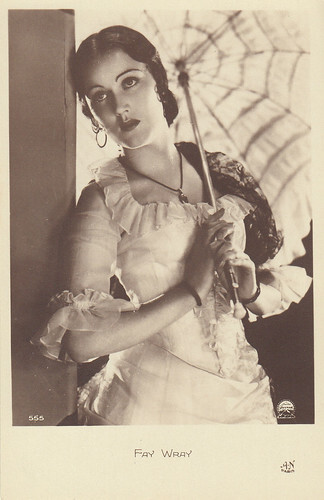
French postcard by A.N. Paris, no. 555. Photo: Paramount.
Canadian-born American actress Fay Wray (1907-2004) attained international recognition as the first 'scream queen' in a series of horror films during the early 1930s. Through an acting career that spanned nearly six decades, Wray is best known as Ann Darrow, the girl held in the hand of King Kong (1933). Two days after her death, the lights of the Empire State Building, the location of King Kong's climax scene, were dimmed for 15 minutes in memory of the "beauty who charmed the beast".
Text and postcards: Marlene Pilaete.

Spanish postcard by Editorial Fotografica, Barcelona, no. A-36. Madge Bellamy in Summer Bachelors (Allan Dwan, 1926).
Madge Bellamy (1899-1990), was a “Darling of the Twenties”. That’s the title she chose for her autobiography, published in 1989. She appeared in about fifty silent films and a dozen sound films. Under contract to Thomas H. Ince, she had her breakthrough role in Lorna Doone (1922). Later, she was a star at Fox studios from 1925 to 1929.

Danish postcard by J. Chr. Olsens Kunstforlag. Eneret, no. 500.
Alluring brunette Alma Bennett (1904-1958)‘s best-remembered role is probably the vamp Bebe Blair in Frank Capra’s Long Pants (1927), starring Harry Langdon. She also played in Westerns, such as Three Jumps Ahead (1923) with Tom Mix, and appeared in several Mack Sennett comedy shorts alongside Ben Turpin, Billy Bevan or Eddie Quillan.

German postcard by Ross Verlag, no. 8990/1, 1933-1934. Photo: Paramount.
Marlene Dietrich (1901-1992) is regarded as the first German actress to become successful in Hollywood. Throughout her long career, she constantly re-invented herself, starting as a cabaret singer, chorus girl and film actress in 1920s Berlin, she became a Hollywood movie star in the 1930s, a World War II frontline entertainer, and finally an international stage show performer from the 1950s to the 1970s, eventually becoming one of the entertainment icons of the 20th century.

German postcard by Ross Verlag, no. 9928/1, 1935-1936. Photo: Hämmerer / Ufa. Marta Eggerth in Das Hofkonzert/The Court Concert (Detlev Sierck a.k.a. Douglas Sirk, 1936).
Hungarian-born singer and actress Márta Eggerth (1912-2013) maintained a global career for over 70 years. She was the popular and talented star of 30 German and Austrian operetta films of the 1930s. Many of the 20th century's most famous operetta composers, including Franz Lehár, Fritz Kreisler, Robert Stolz, Oscar Straus, and Paul Abraham, composed works especially for her. After the rise of the Nazis, she continued her career with her partner Jan Kiepura in the US.

French postcard by Europe, no. 935. Photo: Metro-Goldwyn-Mayer.
Swedish Greta Garbo (1905-1990) was one of the greatest and most glamorous film stars ever produced by the Hollywood studio system. She was part of the Golden Age of the silent cinema of the 1920s and was one of the few actors who made a glorious transition to the talkies. She started her career in European cinema and would always stay more popular in Europe than in the USA.

Postcard printed in Germany for Fatehchand Bhagchand & Bros. Sukkur, no. 179.
Gohar (1910-1985) was a major Indian star from 1925 to 1939. Her films include Typist Girl (1926), Gun Sundari (1927), Devi Devayani (1931), Sati Savitri (1932), Miss 1933 (1933), etc. In 1929, she founded the Ranjit Film Company, in association with director Chandulal Shah. In 1931, it became Ranjit Movietone and soon the company placed itself among the most important Indian film studios of the time. Gohar’s last film, Achhut (1939) dealt with the subject of the Untouchable caste.

Italian postcard by B.F.F. Edit. (Casa Editr. Ballerini & Fratini, Firenze), no. 3777. Photo: Titanus.
Carla Gravina (1941) was a popular Italian actress. Her films include Primo amore (1959), Esterina (1959), Jovanka e le altre (1961), La monaca di Monza (1969), Alfredo Alfredo (1972), L’Antecristo (1974) or Il lungo silenzio (1993). In the 1970s, she played opposite the two leading male French sex symbols of the time: Jean-Paul Belmondo in L’héritier (1973) and Alain Delon in Comme un boomerang (1976). She won a Best Supporting Actress Award at the Cannes Film Festival for La Terrazza (1980). She also had a successful career on stage and on television.

Italian postcard by Ballerini & Fratini, Firenze, no. 2544. Photo: RKO / Generalcine.
Katharine Hepburn (1907-2003) was an indomitable American stage and film actress, known as a spirited performer with a touch of eccentricity. She introduced into her roles a strength of character previously considered to be undesirable in Hollywood leading ladies. As an actress, she was noted for her brisk upper-class New England accent and tomboyish beauty. During her long career, she won four Best Actress Oscars, for Morning Glory (1933), Guess Who’s Coming to Dinner (1967), The Lion in Winter (1968), and On Golden Pond (1981).
 Card Evelyn Holt
Card Evelyn Holt French postcard by Europe, no. 365. Photo: Hegewald Film. Evelyn Holt in Freiwild/Free game (Holger-Madsen, 1928).
Evelyn Holt (1908-2001) was a highly popular German film actress in the late silent and the early sound era.

French postcard by Europe, no. 903. Photo: United Artists.
Ethereally blonde Camilla Horn (1903-1996) was a German dancer and film star. Her breakthrough role was Gretchen in the silent film classic Faust (Friedrich Wilhelm Murnau, 1926). She also starred in some Hollywood films of the late 1920s and in a few British and Italian productions.

Indian postcard by Jugatram & Co., Bombay, no. 10. Caption: Prominent Indian Screen Star.
Mehtab (1913-1997) was an Indian film star who mainly worked in the 1930s and the first part of the 1940s. Her films include Veer Kunal (1932), Jeewan Swapna (1937) or Leather Face (1939). Chitralehka (1941) caused a sensation because of her aesthetically done bathing scene, which was considered daring at the time. Her last husband was famous filmmaker Sohrab Modi.

French postcard by Europe, no. 594. Photo: Super Film.
German actress Maria Paudler (1903-1990) was a popular star of the late silent German cinema. She also played the leading role in the first German TV film.

Belgian postcard by Nieuwe Merksemsche Chocolaterie S.P.R.L. Merksem (Anvers).
An accomplished figure skater, Czechoslovakian-born Vera Ralston (1919 ? 1920 ? 1921 ? 1923 ? -2003) emigrated to the U.S.A. in 1939. She made her film debut in two ice-skating movies for Republic studios, Ice Capades (1941) and Ice Capades Revue (1942), before signing a long-term contract with them in 1943. Herbert Yates, the company’s boss, fell in love with her and they married in 1952. From 1944 to 1958, she starred in twenty-four movies, including two with John Wayne, Dakota (1945) and The Fighting Kentuckian (1949).

Vintage postcard. Photo: M.G.M.
Debbie Reynolds (1932-2016) was elected Miss Burbank in 1948 and made her screen debut the same year. In 1950, she gained notice by playing Helen Kane in Three Little Words and by singing 'Aba Daba Honeymoon', which was a hit on the Billboard charts, in Two Weeks with Love (1950). She had her breakthrough role in Singin’ in the Rain (1952), opposite Gene Kelly and Donald O’Connor. She then starred in twenty-six movies from 1953 to 1968. Afterwards, she was much more active on television than in films.

Italian postcard by Ballerini & Fratini, Firenze, no. 2734.
Toby Wing (1915-2001) was one of the cutest 1930s Hollywood blondes. From 1931 on, she had numerous uncredited bit parts and can be seen for example in 42nd Street (1933), in the 'Young and Healthy' number opposite Dick Powell. However, she became a celebrity by endlessly and cheerfully posing for movie magazines. In the second half of the decade, she had leading roles in several B movies such as Thoroughbred (1936), With Love and Kisses (1936) or Sing While You’re Able (1937). She retired from films following her marriage in 1938.

French postcard by A.N. Paris, no. 555. Photo: Paramount.
Canadian-born American actress Fay Wray (1907-2004) attained international recognition as the first 'scream queen' in a series of horror films during the early 1930s. Through an acting career that spanned nearly six decades, Wray is best known as Ann Darrow, the girl held in the hand of King Kong (1933). Two days after her death, the lights of the Empire State Building, the location of King Kong's climax scene, were dimmed for 15 minutes in memory of the "beauty who charmed the beast".
Text and postcards: Marlene Pilaete.
Published on September 27, 2022 22:00
September 26, 2022
La nouvelle mission de Judex (1917)
René Cresté was the hero Jacques de Tremeuse, better known as Judex, in de popular French crime-adventure serial Judex (1916-1917), directed by Louis Feuillade for Gaumont. Judex is an amazingly cool character and became the first superhero in the cinema. Of course, a sequel was needed and Cresté returned in La nouvelle mission de Judex/The New Mission of Judex (Louis Feuillade, 1917-1918), a serial in twelve episodes. Because of the paper shortage in France during the World War, there are hardly any postcards of Feuillade's earlier serials, Les Vampires and Judex, but we found two card series of La nouvelle mission de Judex: a French postcard series with portraits of the main characters by Coquemer Gravures in Paris and a Spanish collectors card series with film scenes by Chocolate Pi in Barcelona.
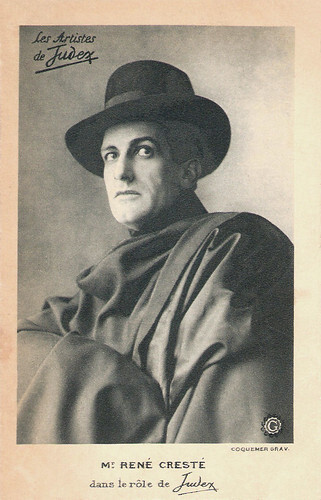
French postcard by Coquemer Gravures, Paris. Photo: Gaumont. René Cresté in La nouvelle mission de Judex (1917-1918).
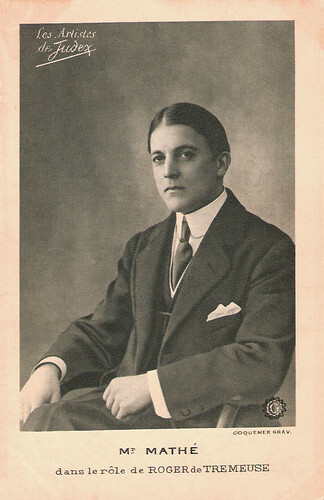
French postcard by Coquemer Gravures, Paris. Photo: Gaumont. Édouard Mathé in La nouvelle mission de Judex (Louis Feuillade, 1917-1918).
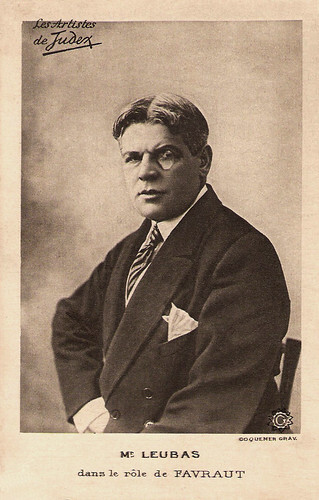
French postcard by Coquemer Gravures, Paris. Photo: Gaumont. Louis Leubas in the role of Favraud in La nouvelle mission de Judex (Louis Feuillade, 1917-1918).
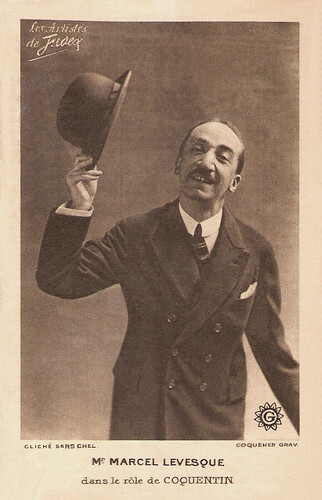
French postcard by Coquemer Gravures, Paris. Photo: Gerschel / Gaumont. Marcel Lévesque in the role of Coquentin La nouvelle mission de Judex (Louis Feuillade, 1917-1918).
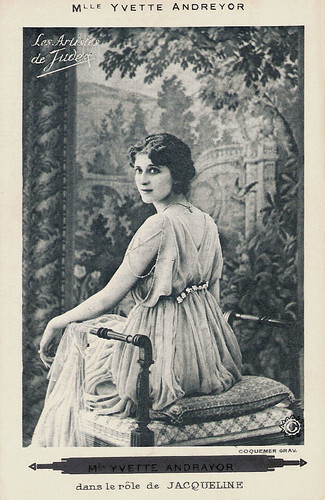
French postcard in the 'Les Artistes de Judex' series by Coquemer Grav. Photo: Gaumont. Yvette Andréyor as Jacqueline in La nouvelle mission de Judex (Louis Feuillade, 1917-1918).
The strict boundaries between good women and bad women are blurred
In the sequel La nouvelle mission de Judex/The New Mission of Judex (Louis Feuillade, 1917-1918) most characters from Judex (Louis Feuillade, 1916-1917) return: Judex ( René Cresté ), Jacqueline ( Yvette Andreyor ), her father Favraux ( Louis Leubas ), clumsy Cocantin ( Marcel Lévesque ), little Jean ( Olinda Mano ) and Roger ( Edouard Mathé ).
Jacques de Tremeuse better known as Judex has married Jacqueline, so he has become a father to her son Jean. Jacques' brother Roger loves the neighbour girl Primerose ( Georgette de Néry ), whose father is the inventor Milton (Emile Keppens). Their happiness is threatened by the dangerous gang 'La rafle aux secrets' (The Raiders of the Secrets), avid in stealing and reselling important technological inventions.
The evil Dr. Howey ( Andrew Brunelle ) and his accomplice, the dangerous Baronne d'Apremont ( Juana Borguèse ), both have the capacity to hypnotise the innocent Jacqueline and Primerose and make them do things against their will. Jacqueline threatens to poison her already ill son, while Primerose steals her father's invention and kidnaps little Jean.
The Baronne and her female aid Gaby (Cyprian Gilles) hold Jean, but they are captured and imprisoned by Judex and Cocantin, Gaby repents but the unrepentant Baronne escapes. Dr. Howey and the Baronne die when their boat explodes, accidentally caused by Cocantin.
In the end, Primerose is cured and marries Roger. Remarkable is that the theft of the invention seems an excuse to display the hysterical crises and hypnotised states of the women, while the Baronne and Gaby seem to be very close to one another and the previous strict boundaries between good women and bad women in Judex are blurred.
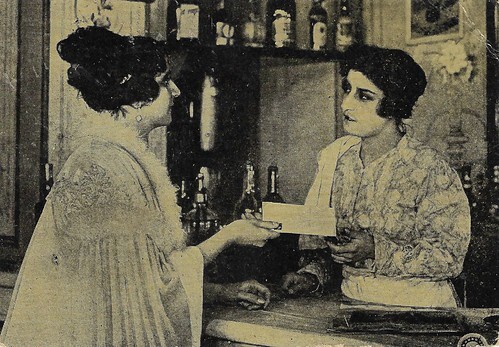
Spanish collectors card by Chocolate Pi, Barcelona, no. 26 of 54. Photo: Gaumont. Left, Juana Borguèse as the Baronne d'Apremont in La nouvelle mission de Judex (Louis Feuillade, 1917-1918).
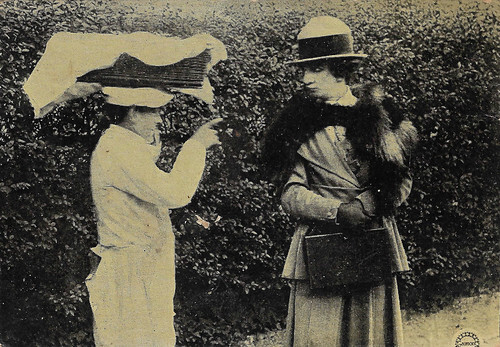
Spanish collectors card by Chocolate Pi, Barcelona, no. 26 of 54. Photo: Gaumont. Marcel Lévesque as Cocantin, dressed as a woman but recognised by the baker's boy, in La nouvelle mission de Judex (Louis Feuillade, 1917-1918).
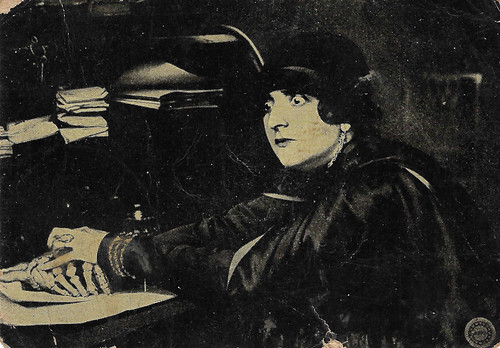
Spanish collectors card by Chocolate Pi, Barcelona, no. 33 of 54. Photo: Gaumont. Juana Borguèse as the Baronne d'Apremont in La nouvelle mission de Judex (Louis Feuillade, 1917-1918).
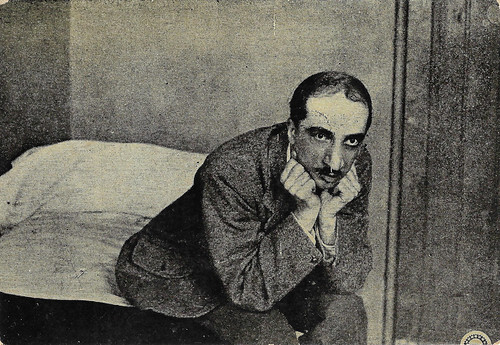
Spanish collectors card by Chocolate Pi, Barcelona, no. 43 of 54. Photo: Gaumont. Marcel Lévesque as Cocantin in La Nouvelle mission de Judex (Louis Feuillade, 1917-1918).
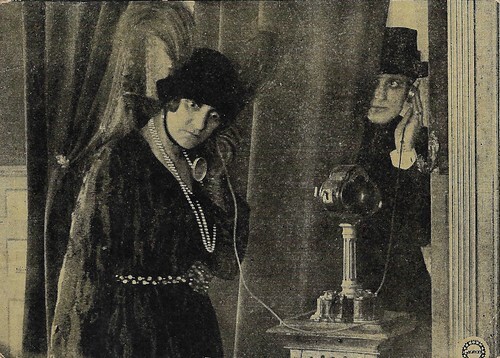
Spanish collectors card by Chocolate Pi, Barcelona, no. 44 of 54. Photo: Gaumont. Judex ( René Cresté ) overhears a phone call by the evil Baronne d'Apremont ( Juana Borguèse ) in La nouvelle mission de Judex (Louis Feuillade, 1917-1918).
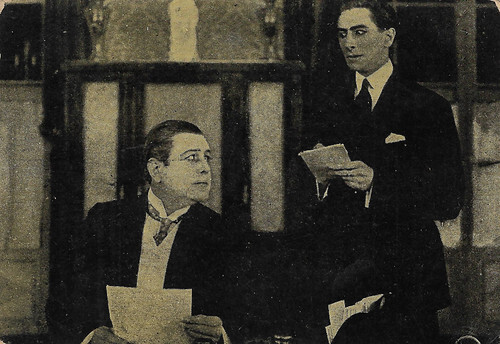
Spanish collectors card by Chocolate Pi, Barcelona, no. 47 of 54. Photo: Gaumont. Scene La nouvelle mission de Judex (Louis Feuillade, 1917-1918). The man on the right could be Andrew Brunelle as the hypnotising Dr. Howey.
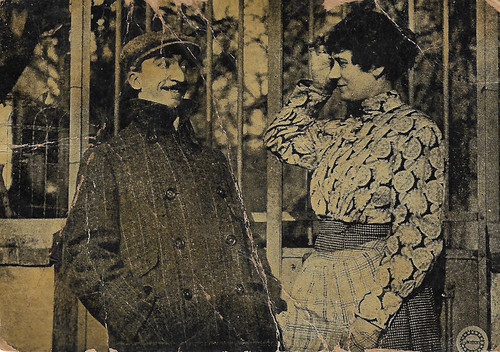
Spanish collectors card by Chocolate Pi, Barcelona, no. 49 of 54. Photo: Gaumont. Marcel Lévesque as Cocantin in La nouvelle mission de Judex (Louis Feuillade, 1917-1918).
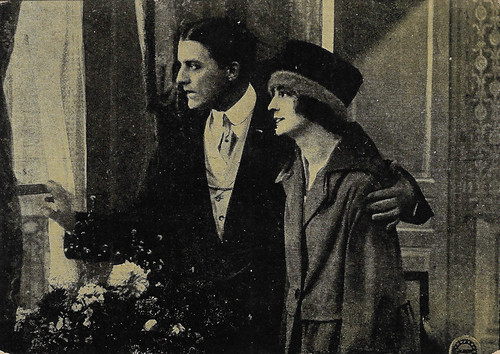
Spanish collectors card by Chocolate Pi, Barcelona, no. 53 of 54. Photo: Gaumont. Edouard Mathé as Roger de Tremeuse and probably Georgette de Néry as Primerose in La nouvelle mission de Judex (Louis Feuillade, 1917-1918).
Less anti-establishment and closer to bourgeois morals
In Louis Feuillade's crime serial film Les Vampires (1915-1916) about the gang of Vampires including the fatal beauty Irma Vep (Musidora), the police were ridiculed. The real police prefect of Paris forbade the screenings of the serial for a while.
After the upheaval of Les Vampires, later on, cherished by the Surrealists, Feuillade's next serial, Judex (Louis Feuillade, 1916-1917), was less anti-establishment and closer to bourgeois morals. The positive hero, played by René Cresté, is a black caped avenger who kidnaps the evil banker Favraux ( Louis Leubas ), who has caused his father's death. Musidora is the banker's evil mistress and governess of his grandson, and Marcel Lévesque plays the clumsy amateur detective Cocantin.
In 1916, Feuillade and writer Arthur Bernède had begun to develop 'Jacques de Tremeuse' (aka Judex) as a mysterious avenger who sports a signature long dark cloak, a wide-brimmed black hat, and a fatalistic air. Judex (which translates as 'Justice') appears and disappears like a ghost, and seems to have hypnotic powers. He is a master of disguise and an excellent fighter. He commands the loyalty of an organisation composed of circus folks and redeemed Apaches. He flies a plane and has a secret lair, where he interrogates his prisoners through a ‘television’ screen - everything Judex writes on the screen on his desk appears on a similar screen on the wall of his victim's cell.
René Cresté as Judex was already very popular with female audiences as this positive hero who comes to the rescue of the oppressed, but the sequel landed René Cresté definitively in ‘le Panthéon du cinéma’, as Philippe Pelletier writes so beautifully at CinéArtistes. He wore in his role as Judex a hat and cape, like Aristide Bruant, a French singer of his time. This costume is very similar to the hero costume of the later comic book hero The Shadow. Edouard Mathé played Cresté’s brother, Roger de Tremeuse. Henceforth Mathé often played a relative or buddy of in subsequent Feuillade serials such as in Judex: La nouvelle mission de Judex/The New Mission of Judex (Louis Feuillade, 1917-1918).
Musidora didn't act in the sequel as her character had died at the end of Judex. Georgette de Néry aka de Nérys didn't play in the original Judex film but played Primerose in the sequel. It was also probably her only film.
After two more crime serials for Feuillade, Tih Minh (1918) and Vendémiaire (1918), René Cresté was fed up with the genre and concerned about his image. He decided to take his career in hand and started his own film company, Films-René-Cresté, with disastrous effects. He turned to manage the Cocorico cinema in the Parisian district of Belleville and re-enacted his famous character, Judex, in a show at the Gaîté-Rochechouart. He died of tuberculosis in 1922. His brother in the Judex serials, Edouard Mathé quit filmmaking with Feuillade in 1922 after Parisette. After a handful of films in 1923-1924, including the two Ausonia films Mes p’tits (1923) and La course à l’amour (1924), he quitted acting in film altogether.
The Cinémathèque française owns a 35 mm version of La nouvelle mission de Judex (Louis Feuillade, 1917-1918) that was screened as part of the major Louis Feuillade retrospective in 2006. The series has not yet been released on DVD.
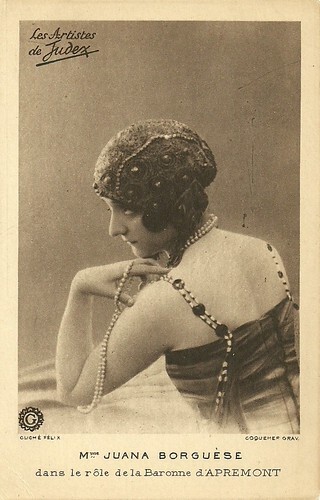
French postcard by Coquemer Gravures, Paris. Photo: Félix / Gaumont. Juana Borguèse as the evil Baronne d'Apremont in La nouvelle mission de Judex (Louis Feuillade, 1917-1918).
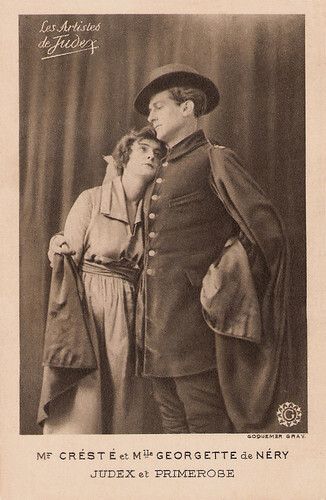
French postcard by Coquemer Gravures. Photo: Production Gaumont. René Cresté as Judex and Georgette de Néry as Primerose in La nouvelle mission de Judex (Louis Feuillade, 1917-1918).
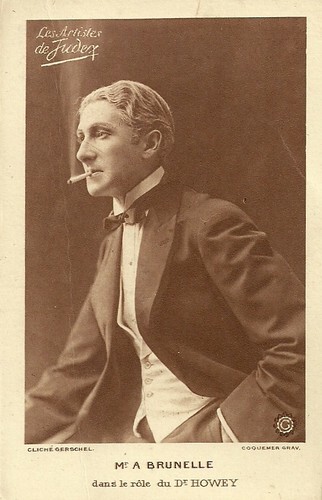
French postcard by Coquemer Gravures, Paris. Photo: Gerschel / Gaumont. Andrew Brunelle as the evil Dr. Howey in La nouvelle mission de Judex (Louis Feuillade, 1917-1918).
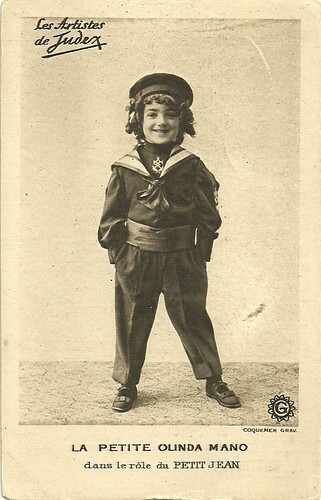
French postcard by Coquemer Gravures, Paris. Photo: Gaumont. Olinda Mano as the boy Jean in La nouvelle mission de Judex (Louis Feuillade, 1917-1918).
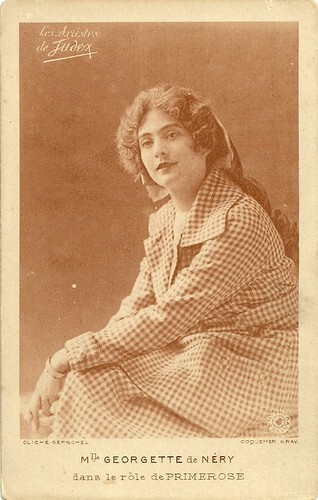
French postcard by Coquemer Gravures, Paris. Photo: Gerschel / Gaumont. Photo: Gaumont. Georgette de Néry as Primerose in La nouvelle mission de Judex (Louis Feuillade, 1917-1918).
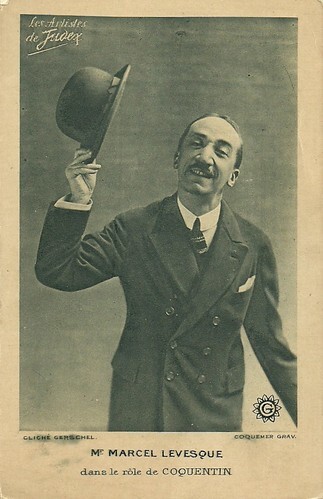
French postcard by Coquemer Gravures, Paris. Photo: Gerschel / Gaumont. Marcel Lévesque in the role of Coquentin La nouvelle mission de Judex (Louis Feuillade, 1917-1918).
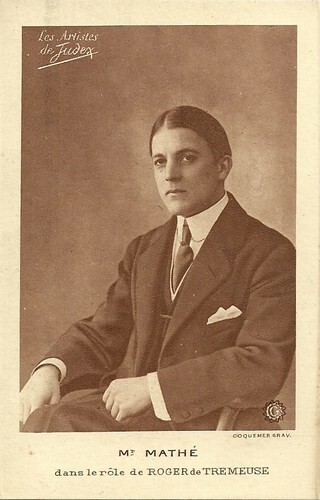
French postcard by Coquemer Gravures, Paris. Photo: Gaumont. Édouard Mathé in La nouvelle mission de Judex (Louis Feuillade, 1917-1918).
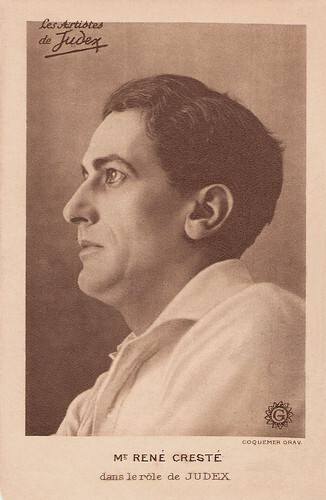
French postcard by Coquemer Gravures, Paris. Photo: Gaumont. René Cresté in La nouvelle mission de Judex (Louis Feuillade, 1917-1918).
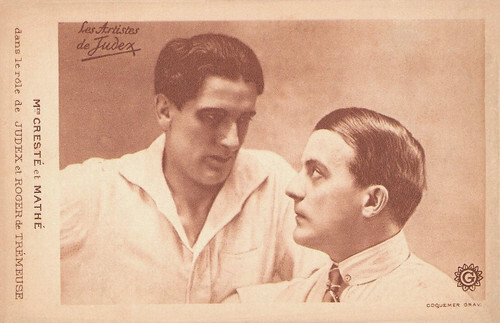
French postcard by Coquemer Gravures, Paris. Photo: Gaumont. René Cresté and Edouard Mathé in La nouvelle mission de Judex (Louis Feuillade, 1917-1918).
Source: Vicki Callahan (Zones of Anxiety: Movement, Musidora and the Crime Serials of Louis Feuillade), Philippe Pelletier (CinéArtistes - French), Jeffrey M. Anderson (Combustible Celluloid), Wikipedia (German) and IMDb.

French postcard by Coquemer Gravures, Paris. Photo: Gaumont. René Cresté in La nouvelle mission de Judex (1917-1918).

French postcard by Coquemer Gravures, Paris. Photo: Gaumont. Édouard Mathé in La nouvelle mission de Judex (Louis Feuillade, 1917-1918).

French postcard by Coquemer Gravures, Paris. Photo: Gaumont. Louis Leubas in the role of Favraud in La nouvelle mission de Judex (Louis Feuillade, 1917-1918).

French postcard by Coquemer Gravures, Paris. Photo: Gerschel / Gaumont. Marcel Lévesque in the role of Coquentin La nouvelle mission de Judex (Louis Feuillade, 1917-1918).

French postcard in the 'Les Artistes de Judex' series by Coquemer Grav. Photo: Gaumont. Yvette Andréyor as Jacqueline in La nouvelle mission de Judex (Louis Feuillade, 1917-1918).
The strict boundaries between good women and bad women are blurred
In the sequel La nouvelle mission de Judex/The New Mission of Judex (Louis Feuillade, 1917-1918) most characters from Judex (Louis Feuillade, 1916-1917) return: Judex ( René Cresté ), Jacqueline ( Yvette Andreyor ), her father Favraux ( Louis Leubas ), clumsy Cocantin ( Marcel Lévesque ), little Jean ( Olinda Mano ) and Roger ( Edouard Mathé ).
Jacques de Tremeuse better known as Judex has married Jacqueline, so he has become a father to her son Jean. Jacques' brother Roger loves the neighbour girl Primerose ( Georgette de Néry ), whose father is the inventor Milton (Emile Keppens). Their happiness is threatened by the dangerous gang 'La rafle aux secrets' (The Raiders of the Secrets), avid in stealing and reselling important technological inventions.
The evil Dr. Howey ( Andrew Brunelle ) and his accomplice, the dangerous Baronne d'Apremont ( Juana Borguèse ), both have the capacity to hypnotise the innocent Jacqueline and Primerose and make them do things against their will. Jacqueline threatens to poison her already ill son, while Primerose steals her father's invention and kidnaps little Jean.
The Baronne and her female aid Gaby (Cyprian Gilles) hold Jean, but they are captured and imprisoned by Judex and Cocantin, Gaby repents but the unrepentant Baronne escapes. Dr. Howey and the Baronne die when their boat explodes, accidentally caused by Cocantin.
In the end, Primerose is cured and marries Roger. Remarkable is that the theft of the invention seems an excuse to display the hysterical crises and hypnotised states of the women, while the Baronne and Gaby seem to be very close to one another and the previous strict boundaries between good women and bad women in Judex are blurred.

Spanish collectors card by Chocolate Pi, Barcelona, no. 26 of 54. Photo: Gaumont. Left, Juana Borguèse as the Baronne d'Apremont in La nouvelle mission de Judex (Louis Feuillade, 1917-1918).

Spanish collectors card by Chocolate Pi, Barcelona, no. 26 of 54. Photo: Gaumont. Marcel Lévesque as Cocantin, dressed as a woman but recognised by the baker's boy, in La nouvelle mission de Judex (Louis Feuillade, 1917-1918).

Spanish collectors card by Chocolate Pi, Barcelona, no. 33 of 54. Photo: Gaumont. Juana Borguèse as the Baronne d'Apremont in La nouvelle mission de Judex (Louis Feuillade, 1917-1918).

Spanish collectors card by Chocolate Pi, Barcelona, no. 43 of 54. Photo: Gaumont. Marcel Lévesque as Cocantin in La Nouvelle mission de Judex (Louis Feuillade, 1917-1918).

Spanish collectors card by Chocolate Pi, Barcelona, no. 44 of 54. Photo: Gaumont. Judex ( René Cresté ) overhears a phone call by the evil Baronne d'Apremont ( Juana Borguèse ) in La nouvelle mission de Judex (Louis Feuillade, 1917-1918).

Spanish collectors card by Chocolate Pi, Barcelona, no. 47 of 54. Photo: Gaumont. Scene La nouvelle mission de Judex (Louis Feuillade, 1917-1918). The man on the right could be Andrew Brunelle as the hypnotising Dr. Howey.

Spanish collectors card by Chocolate Pi, Barcelona, no. 49 of 54. Photo: Gaumont. Marcel Lévesque as Cocantin in La nouvelle mission de Judex (Louis Feuillade, 1917-1918).

Spanish collectors card by Chocolate Pi, Barcelona, no. 53 of 54. Photo: Gaumont. Edouard Mathé as Roger de Tremeuse and probably Georgette de Néry as Primerose in La nouvelle mission de Judex (Louis Feuillade, 1917-1918).
Less anti-establishment and closer to bourgeois morals
In Louis Feuillade's crime serial film Les Vampires (1915-1916) about the gang of Vampires including the fatal beauty Irma Vep (Musidora), the police were ridiculed. The real police prefect of Paris forbade the screenings of the serial for a while.
After the upheaval of Les Vampires, later on, cherished by the Surrealists, Feuillade's next serial, Judex (Louis Feuillade, 1916-1917), was less anti-establishment and closer to bourgeois morals. The positive hero, played by René Cresté, is a black caped avenger who kidnaps the evil banker Favraux ( Louis Leubas ), who has caused his father's death. Musidora is the banker's evil mistress and governess of his grandson, and Marcel Lévesque plays the clumsy amateur detective Cocantin.
In 1916, Feuillade and writer Arthur Bernède had begun to develop 'Jacques de Tremeuse' (aka Judex) as a mysterious avenger who sports a signature long dark cloak, a wide-brimmed black hat, and a fatalistic air. Judex (which translates as 'Justice') appears and disappears like a ghost, and seems to have hypnotic powers. He is a master of disguise and an excellent fighter. He commands the loyalty of an organisation composed of circus folks and redeemed Apaches. He flies a plane and has a secret lair, where he interrogates his prisoners through a ‘television’ screen - everything Judex writes on the screen on his desk appears on a similar screen on the wall of his victim's cell.
René Cresté as Judex was already very popular with female audiences as this positive hero who comes to the rescue of the oppressed, but the sequel landed René Cresté definitively in ‘le Panthéon du cinéma’, as Philippe Pelletier writes so beautifully at CinéArtistes. He wore in his role as Judex a hat and cape, like Aristide Bruant, a French singer of his time. This costume is very similar to the hero costume of the later comic book hero The Shadow. Edouard Mathé played Cresté’s brother, Roger de Tremeuse. Henceforth Mathé often played a relative or buddy of in subsequent Feuillade serials such as in Judex: La nouvelle mission de Judex/The New Mission of Judex (Louis Feuillade, 1917-1918).
Musidora didn't act in the sequel as her character had died at the end of Judex. Georgette de Néry aka de Nérys didn't play in the original Judex film but played Primerose in the sequel. It was also probably her only film.
After two more crime serials for Feuillade, Tih Minh (1918) and Vendémiaire (1918), René Cresté was fed up with the genre and concerned about his image. He decided to take his career in hand and started his own film company, Films-René-Cresté, with disastrous effects. He turned to manage the Cocorico cinema in the Parisian district of Belleville and re-enacted his famous character, Judex, in a show at the Gaîté-Rochechouart. He died of tuberculosis in 1922. His brother in the Judex serials, Edouard Mathé quit filmmaking with Feuillade in 1922 after Parisette. After a handful of films in 1923-1924, including the two Ausonia films Mes p’tits (1923) and La course à l’amour (1924), he quitted acting in film altogether.
The Cinémathèque française owns a 35 mm version of La nouvelle mission de Judex (Louis Feuillade, 1917-1918) that was screened as part of the major Louis Feuillade retrospective in 2006. The series has not yet been released on DVD.

French postcard by Coquemer Gravures, Paris. Photo: Félix / Gaumont. Juana Borguèse as the evil Baronne d'Apremont in La nouvelle mission de Judex (Louis Feuillade, 1917-1918).

French postcard by Coquemer Gravures. Photo: Production Gaumont. René Cresté as Judex and Georgette de Néry as Primerose in La nouvelle mission de Judex (Louis Feuillade, 1917-1918).

French postcard by Coquemer Gravures, Paris. Photo: Gerschel / Gaumont. Andrew Brunelle as the evil Dr. Howey in La nouvelle mission de Judex (Louis Feuillade, 1917-1918).

French postcard by Coquemer Gravures, Paris. Photo: Gaumont. Olinda Mano as the boy Jean in La nouvelle mission de Judex (Louis Feuillade, 1917-1918).

French postcard by Coquemer Gravures, Paris. Photo: Gerschel / Gaumont. Photo: Gaumont. Georgette de Néry as Primerose in La nouvelle mission de Judex (Louis Feuillade, 1917-1918).

French postcard by Coquemer Gravures, Paris. Photo: Gerschel / Gaumont. Marcel Lévesque in the role of Coquentin La nouvelle mission de Judex (Louis Feuillade, 1917-1918).

French postcard by Coquemer Gravures, Paris. Photo: Gaumont. Édouard Mathé in La nouvelle mission de Judex (Louis Feuillade, 1917-1918).

French postcard by Coquemer Gravures, Paris. Photo: Gaumont. René Cresté in La nouvelle mission de Judex (Louis Feuillade, 1917-1918).

French postcard by Coquemer Gravures, Paris. Photo: Gaumont. René Cresté and Edouard Mathé in La nouvelle mission de Judex (Louis Feuillade, 1917-1918).
Source: Vicki Callahan (Zones of Anxiety: Movement, Musidora and the Crime Serials of Louis Feuillade), Philippe Pelletier (CinéArtistes - French), Jeffrey M. Anderson (Combustible Celluloid), Wikipedia (German) and IMDb.
Published on September 26, 2022 22:00
September 24, 2022
Audie Murphy
Audie Murphy (1925-1971) was the most decorated US soldier of World War II. Subsequently, he was a film actor and songwriter. In the 1950s and 1960s, he enjoyed success as a performer in Westerns and adventure films. Murphy received every military award his country had to offer, some of them more than once - a total of 33 awards and medals; among others, he was a recipient of the Medal of Honor. He received five of his decorations from France and one from Belgium. During his three years of service, he served in the 3rd US Infantry Division, where he rose from Private to First Lieutenant.

German postcard by Krüger, no. 902/17.
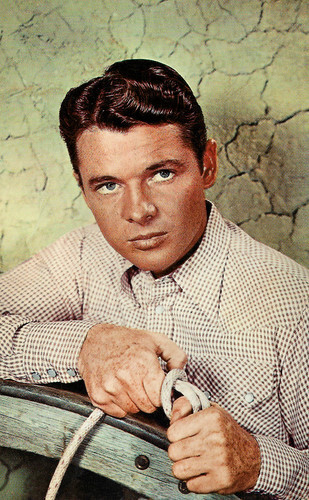
American postcard by Universal-International Studios, Universal City, Calif. Photo: Universal. Sent by mail in 1960.
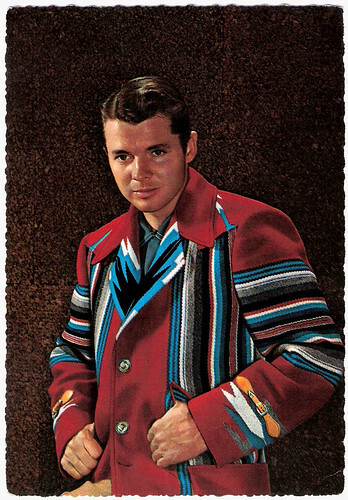
German postcard by Krüger, no. 902/18.
The most decorated American soldier of World War II
Audie Leon Murphy was born in Kingston, Texas in 1925. His parents were Josie Bell (Killian) and Emmett Berry Murphy, poor sharecroppers of Irish descent. There was great poverty in his family which counted eleven children, two of whom died. As soon as these children were old enough, they were employed to help earn a living.
His father disappeared one day and was never heard from again. Over the years, the mother became increasingly weak and died when Murphy was 16 years old. The three youngest children were sent to an orphanage and Murphy went to work, first at a petrol pump and then at a radio repair shop. When the Japanese attacked Pearl Harbor, he decided to enlist in the army.
On his seventeenth birthday, he applied to a Marine recruiting station but was rejected because he was not of sufficient weight. Finally, after another unsuccessful application to the paratroopers, he was accepted into the infantry. With the help of his sister, he had used a forged birth certificate, with 1924 as his date of birth, to make himself look old enough.
At Fort Meade, where his training was to be completed, he kept insisting on being sent overseas and in early 1943 Murphy landed with the rest of the troops in North Africa. He would become the most decorated American soldier of World War II and participated in combat operations for 27 months. Early in June 1945, a month after the German capitulation, Murphy returned to the United States, where he received a hero's welcome in his native Texas. He was honourably discharged from the army with the rank of a first lieutenant on 21 September 1945. Murphy became world famous when he appeared on the cover of Life (16 July 1945) as the "most decorated soldier".
After the outbreak of the Korean War in June 1950, he reenlisted in the 36th Infantry Division of the Texas National Guard. However, this division did not participate in combat. When Murphy left the Guard in 1966 it was with the rank of major. After Murphy returned from Europe, he bought a house in Farmersville for his eldest sister Corrine, her husband Poland Burns and their three children. His intention was that his youngest sister and two brothers, Nadine, Billie and Joe, who had been in an orphanage since their mother's death, would also move in with them but six children under one roof proved a bit much so Murphy took them in.
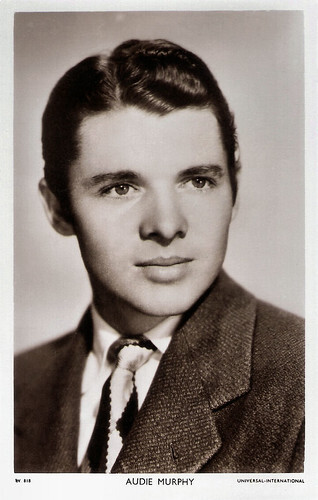
British postcard in the Picturegoer Series, London, no. W 818. Photo: Universal International.
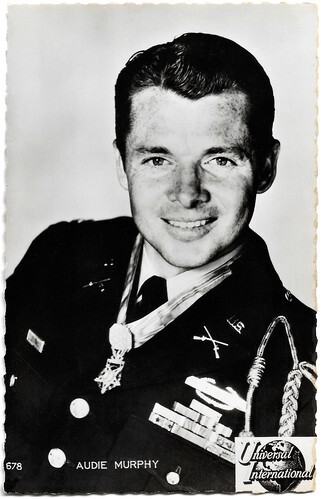
Photo: Universal International. Caption: Audie Murphy, the most decorated American soldier of the Second World War, stars in To Hell and Back.
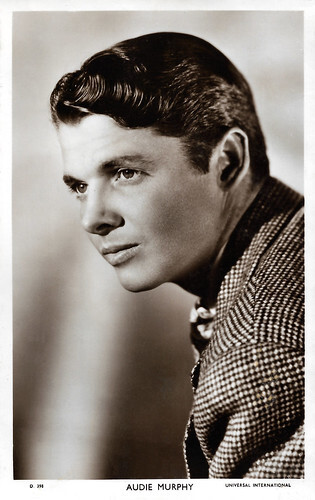
British postcard, in the Picturegoer Series, London, no. D 398. Photo: Universal International.
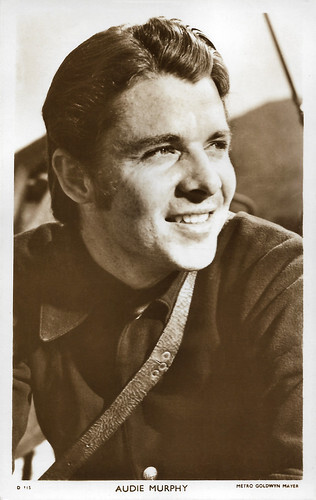
British postcard, in the Picturegoer Series, London, no. D 115. Photo: Metro Goldwyn Mayer. Audie Murphy in The Red Badge of Courage (John Huston, 1951).
To hell and back
After actor James Cagney had seen Audie Murphy's picture on the cover of Life magazine, he invited him to Hollywood in September 1945. The first years there were difficult for Murphy. Cagney Productions paid for acting and dancing lessons but was reluctantly forced to admit that Murphy - at least at that point in his career - didn't have what it took to become a movie star.
For the next several years he struggled to make it as an actor. Due to a lack of work, he became disillusioned, often ran out of money and slept on the floor of an old gym 'Terry Hunt's Athletic Club', owned by his friend Terry Hunt. He eventually got bit roles in the films Beyond Glory (John Farrow, 1948) starring Alan Ladd , and in Texas, Brooklyn and Heaven (William Castle, 1948) with Guy Madison and Diana Lynn.
In this third film, Bad Boy (Kurt Neumann, 1949), Murphy got a leading role. Murphy also appeared in the film adaptation of Stephen Crane's book The Red Badge of Courage (John Huston, 1951), for which he received rave reviews. Murphy wrote his autobiography 'To hell and back' in 1949 and it became a national bestseller. The book was written by his friend David "Spec" McClure, a professional writer.
He had great difficulty playing himself in the film version, To Hell and Back (Jesse Hibbs, 1955). He initially saw it as a kind of sell-out of his actions during the war and thought Tony Curtis should be given the lead role in the film. In the film, the reality was followed and Murphy's comrades died just as was mentioned in the book. At the end of the film, Murphy was the only member of his original regiment left.
During the ceremony in which Murphy was awarded the Medal of Honor, his friends were represented as ghosts. This was Murphy's idea to honour his friends. The film was a huge hit and brought in almost 10 million US dollars during its first years, setting a box-office record for Universal that wasn't broken for 20 years until it was finally surpassed by Jaws (Steven Spielberg, 1975).
One of his better pictures was Night Passage (James Neilson, 1957), a Western in which he played the kid brother of James Stewart . In 1959 he starred in the Western No Name on the Bullet (Jack Arnold, 1959), which was well received, despite Murphy playing a professional killer. He worked for Huston again on The Unforgiven (John Huston, 1960) opposite Burt Lancaster and Audrey Hepburn .
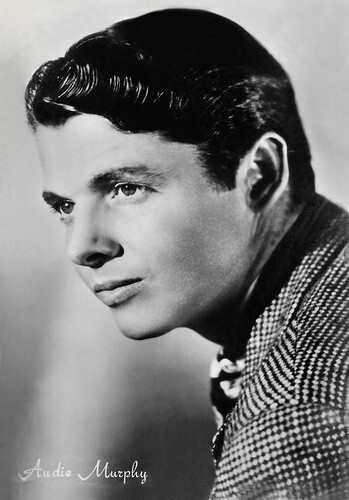
Italian postcard by Rotalfoto, Milano, no. 590.
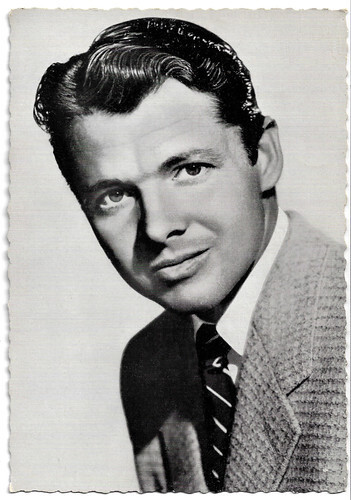
West-German postcard by Filmbilder-Vertrieb Ernst Freihoff, Essen, no. 284. Photo: Columbia Film.
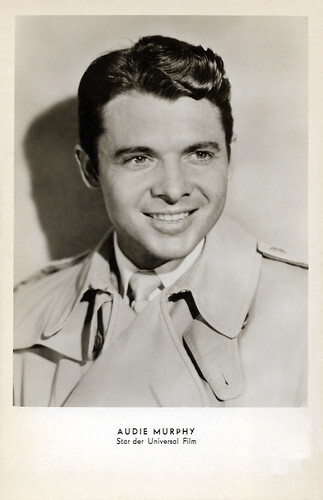
West-German postcard by Kunst und Bild, Berlin, no. A 1311. Photo: Universal.
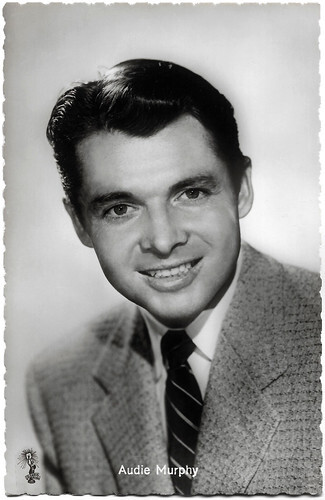
West-German postcard by Kolibri-Verlag G.m.b.H., Minden/Westf., no. 2487 Photo: Columbia. Publicity still for The Guns of Fort Petticoat (George Marshall, 1957).
Bouts of depression and nightmares
Audie Murphy was plagued by insomnia, bouts of depression and nightmares, probably a result of the many battles he had to fight during his life. His first wife, Wanda Hendrix , often spoke of Murphy's struggles. During the 1960s Murphy was addicted to the sleeping pill Placidyl for a time. When he realised he had become addicted he locked himself in a hotel room and taught himself not to use it.
He also broke the taboo of talking about war-related mental conditions. To draw attention to the problems of returning veterans from Korea and Vietnam, he spoke candidly about his own. He called on the US government to pay more attention to this issue and to study more closely the impact of war on mental health.
Meanwhile, the studio system that Murphy grew into as an actor crumbled. Universal's new owners, MCA, dumped its "International" tag in 1962 and turned the studio's focus toward the more lucrative television industry. For theatrical productions, it dropped its roster of contract players and hired actors on a per-picture basis only. That cheap Westerns on the big screen were becoming a thing of the past bode no good for Murphy, either.
The Texican (Lesley Selander, 1966) with Broderick Crawford , his lone attempt at a new, European form of inexpensive horse opera, to become known as "the Spaghetti Western", was unsuccessful. His star was falling fast. He made a total of 44 films, but Murphy was also a rancher and businessman. He bred and raised thoroughbred horses and owned several ranches in Texas, Arizona and California.
Murphy was also successful as a country singer and composer. He worked with Guy Mitchell, Jimmy Bryant, Scott Turner, Coy Ziegler and Ray and Terri Eddlemon, among others. Murphy's songs were recorded and sung by Dean Martin , Porter Waggoner, and Harry Nilsson, among others. His two biggest hits were 'Shutters and Boards' and 'When the Wind Blows in Chicago'.
In 1949, Murphy married film actress Wanda Hendrix and divorced her in 1952. He then married flight attendant Pamela Archer, with whom he had 2 children, Terrance Michael and James Shannon - named after two of his closest friends. Audie Murphy died in 1971 in a plane crash in the mountains of Virginia. Murphy was buried with military honours in Arlington National Cemetery. The official government representative was the decorated World War II veteran and future President G.H.W. Bush.
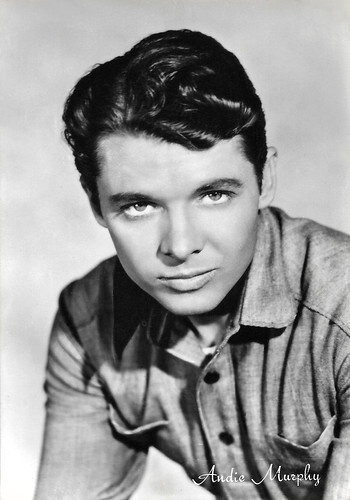
Italian postcard by Rotalphoto, Milano, no. 109.
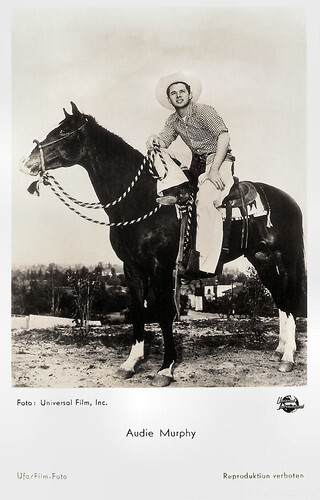
West-German postcard by Ufa/Film-Foto, Berlin-Tempelhof, no. FK 3386. Photo: Universal Film, Inc.
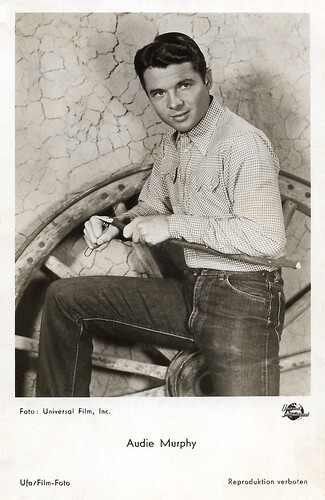
West-German postcard by Ufa/Film-Foto, Berlin-Tempelhof, no. FK 3387. Photo: Universal Film, Inc. Audie Murphy in Walk the Proud Land (Jesse Hibbs, 1956).
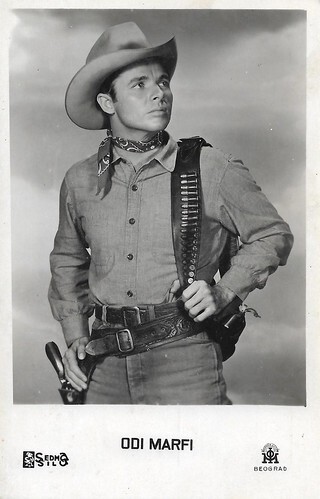
Yugoslavian postcard by Sedma Sila. Photo: Morava Film, Beograd (Belgrade).
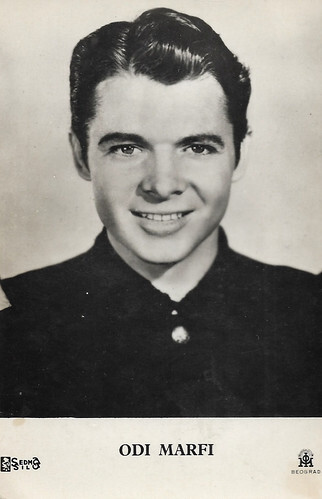
Yugoslavian postcard by Sedma Sila. Photo: Morava Film, Beograd (Belgrade).
Sources: Wikipedia (Dutch) and .

German postcard by Krüger, no. 902/17.

American postcard by Universal-International Studios, Universal City, Calif. Photo: Universal. Sent by mail in 1960.

German postcard by Krüger, no. 902/18.
The most decorated American soldier of World War II
Audie Leon Murphy was born in Kingston, Texas in 1925. His parents were Josie Bell (Killian) and Emmett Berry Murphy, poor sharecroppers of Irish descent. There was great poverty in his family which counted eleven children, two of whom died. As soon as these children were old enough, they were employed to help earn a living.
His father disappeared one day and was never heard from again. Over the years, the mother became increasingly weak and died when Murphy was 16 years old. The three youngest children were sent to an orphanage and Murphy went to work, first at a petrol pump and then at a radio repair shop. When the Japanese attacked Pearl Harbor, he decided to enlist in the army.
On his seventeenth birthday, he applied to a Marine recruiting station but was rejected because he was not of sufficient weight. Finally, after another unsuccessful application to the paratroopers, he was accepted into the infantry. With the help of his sister, he had used a forged birth certificate, with 1924 as his date of birth, to make himself look old enough.
At Fort Meade, where his training was to be completed, he kept insisting on being sent overseas and in early 1943 Murphy landed with the rest of the troops in North Africa. He would become the most decorated American soldier of World War II and participated in combat operations for 27 months. Early in June 1945, a month after the German capitulation, Murphy returned to the United States, where he received a hero's welcome in his native Texas. He was honourably discharged from the army with the rank of a first lieutenant on 21 September 1945. Murphy became world famous when he appeared on the cover of Life (16 July 1945) as the "most decorated soldier".
After the outbreak of the Korean War in June 1950, he reenlisted in the 36th Infantry Division of the Texas National Guard. However, this division did not participate in combat. When Murphy left the Guard in 1966 it was with the rank of major. After Murphy returned from Europe, he bought a house in Farmersville for his eldest sister Corrine, her husband Poland Burns and their three children. His intention was that his youngest sister and two brothers, Nadine, Billie and Joe, who had been in an orphanage since their mother's death, would also move in with them but six children under one roof proved a bit much so Murphy took them in.

British postcard in the Picturegoer Series, London, no. W 818. Photo: Universal International.

Photo: Universal International. Caption: Audie Murphy, the most decorated American soldier of the Second World War, stars in To Hell and Back.

British postcard, in the Picturegoer Series, London, no. D 398. Photo: Universal International.

British postcard, in the Picturegoer Series, London, no. D 115. Photo: Metro Goldwyn Mayer. Audie Murphy in The Red Badge of Courage (John Huston, 1951).
To hell and back
After actor James Cagney had seen Audie Murphy's picture on the cover of Life magazine, he invited him to Hollywood in September 1945. The first years there were difficult for Murphy. Cagney Productions paid for acting and dancing lessons but was reluctantly forced to admit that Murphy - at least at that point in his career - didn't have what it took to become a movie star.
For the next several years he struggled to make it as an actor. Due to a lack of work, he became disillusioned, often ran out of money and slept on the floor of an old gym 'Terry Hunt's Athletic Club', owned by his friend Terry Hunt. He eventually got bit roles in the films Beyond Glory (John Farrow, 1948) starring Alan Ladd , and in Texas, Brooklyn and Heaven (William Castle, 1948) with Guy Madison and Diana Lynn.
In this third film, Bad Boy (Kurt Neumann, 1949), Murphy got a leading role. Murphy also appeared in the film adaptation of Stephen Crane's book The Red Badge of Courage (John Huston, 1951), for which he received rave reviews. Murphy wrote his autobiography 'To hell and back' in 1949 and it became a national bestseller. The book was written by his friend David "Spec" McClure, a professional writer.
He had great difficulty playing himself in the film version, To Hell and Back (Jesse Hibbs, 1955). He initially saw it as a kind of sell-out of his actions during the war and thought Tony Curtis should be given the lead role in the film. In the film, the reality was followed and Murphy's comrades died just as was mentioned in the book. At the end of the film, Murphy was the only member of his original regiment left.
During the ceremony in which Murphy was awarded the Medal of Honor, his friends were represented as ghosts. This was Murphy's idea to honour his friends. The film was a huge hit and brought in almost 10 million US dollars during its first years, setting a box-office record for Universal that wasn't broken for 20 years until it was finally surpassed by Jaws (Steven Spielberg, 1975).
One of his better pictures was Night Passage (James Neilson, 1957), a Western in which he played the kid brother of James Stewart . In 1959 he starred in the Western No Name on the Bullet (Jack Arnold, 1959), which was well received, despite Murphy playing a professional killer. He worked for Huston again on The Unforgiven (John Huston, 1960) opposite Burt Lancaster and Audrey Hepburn .

Italian postcard by Rotalfoto, Milano, no. 590.

West-German postcard by Filmbilder-Vertrieb Ernst Freihoff, Essen, no. 284. Photo: Columbia Film.

West-German postcard by Kunst und Bild, Berlin, no. A 1311. Photo: Universal.

West-German postcard by Kolibri-Verlag G.m.b.H., Minden/Westf., no. 2487 Photo: Columbia. Publicity still for The Guns of Fort Petticoat (George Marshall, 1957).
Bouts of depression and nightmares
Audie Murphy was plagued by insomnia, bouts of depression and nightmares, probably a result of the many battles he had to fight during his life. His first wife, Wanda Hendrix , often spoke of Murphy's struggles. During the 1960s Murphy was addicted to the sleeping pill Placidyl for a time. When he realised he had become addicted he locked himself in a hotel room and taught himself not to use it.
He also broke the taboo of talking about war-related mental conditions. To draw attention to the problems of returning veterans from Korea and Vietnam, he spoke candidly about his own. He called on the US government to pay more attention to this issue and to study more closely the impact of war on mental health.
Meanwhile, the studio system that Murphy grew into as an actor crumbled. Universal's new owners, MCA, dumped its "International" tag in 1962 and turned the studio's focus toward the more lucrative television industry. For theatrical productions, it dropped its roster of contract players and hired actors on a per-picture basis only. That cheap Westerns on the big screen were becoming a thing of the past bode no good for Murphy, either.
The Texican (Lesley Selander, 1966) with Broderick Crawford , his lone attempt at a new, European form of inexpensive horse opera, to become known as "the Spaghetti Western", was unsuccessful. His star was falling fast. He made a total of 44 films, but Murphy was also a rancher and businessman. He bred and raised thoroughbred horses and owned several ranches in Texas, Arizona and California.
Murphy was also successful as a country singer and composer. He worked with Guy Mitchell, Jimmy Bryant, Scott Turner, Coy Ziegler and Ray and Terri Eddlemon, among others. Murphy's songs were recorded and sung by Dean Martin , Porter Waggoner, and Harry Nilsson, among others. His two biggest hits were 'Shutters and Boards' and 'When the Wind Blows in Chicago'.
In 1949, Murphy married film actress Wanda Hendrix and divorced her in 1952. He then married flight attendant Pamela Archer, with whom he had 2 children, Terrance Michael and James Shannon - named after two of his closest friends. Audie Murphy died in 1971 in a plane crash in the mountains of Virginia. Murphy was buried with military honours in Arlington National Cemetery. The official government representative was the decorated World War II veteran and future President G.H.W. Bush.

Italian postcard by Rotalphoto, Milano, no. 109.

West-German postcard by Ufa/Film-Foto, Berlin-Tempelhof, no. FK 3386. Photo: Universal Film, Inc.

West-German postcard by Ufa/Film-Foto, Berlin-Tempelhof, no. FK 3387. Photo: Universal Film, Inc. Audie Murphy in Walk the Proud Land (Jesse Hibbs, 1956).

Yugoslavian postcard by Sedma Sila. Photo: Morava Film, Beograd (Belgrade).

Yugoslavian postcard by Sedma Sila. Photo: Morava Film, Beograd (Belgrade).
Sources: Wikipedia (Dutch) and .
Published on September 24, 2022 22:00
September 23, 2022
It's a gift
We found many of the cards on this blog on fairs, small shops and flea markets, or in webshops like Delcampe, eBay or the Dutch equivalent, Marktplaats. Regularly, we also receive postcards from friendly people. Sometimes it's a gift from a friend, neighbour or colleague and other times people who know us from Flickr or EFSP sent us cards from a relative who passed away or their own cards cause they know we are happy with them. Recently, my old friend Willem gave me this amazing album with more than 1000 vintage collector cards. This post is a salute to all these people. Thank you, dear friends!
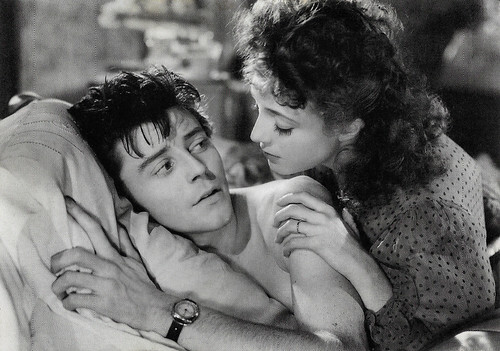
French postcard by Editions La Malibran, Paris, no. CF 23, 1990. Gérard Philipe and Micheline Presle in Le Diable au corps/Devil in the Flesh (Claude Autant-Lara, 1947). This postcard was sent years ago to me by my partner at EFSP and in life, Ivo Blom.
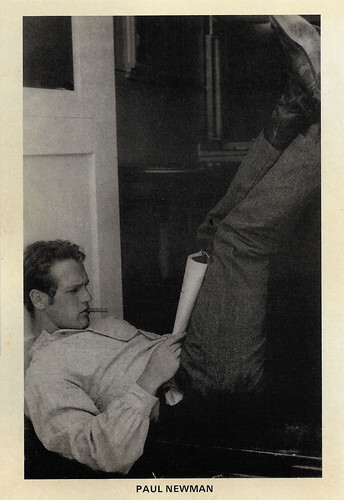
Spanish postcard by Productos Compactos, S.A., no. B-3768, 1991. Paul Newman . This card was a gift to me by my other EFSP pal, Marlene Pilaete. She gave it o me when we met for drinks at the VerzamelaarsJaarbeurs 2022 in Utrecht.
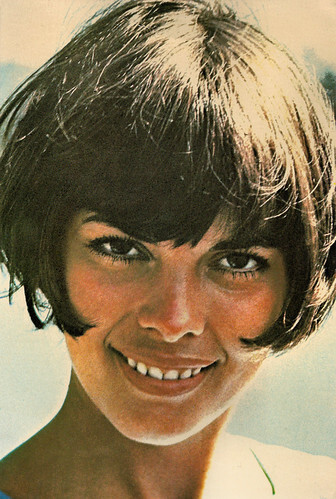
Dutch postcard by N.V. Grammofoonplatenmaatschappij CNR, Leiden. Photo: Barclay / Ariola. This postcard of Mireille Mathieu was donated to us by the Conradi family. My collague Susanne Conradi told me that her mother used to be a big fan of Mireille.
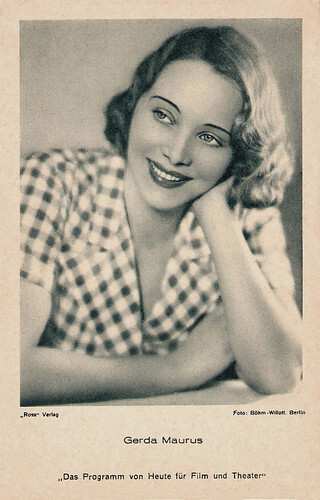
German postcard by Das Programm von Heute für Film und Theater / Ross Verlag, Berlin. Photo: Böhm-Willott, Berlin. Gerda Maurus . A collection of old German postcards was given to us by our Flickr connection Miss Mertens.
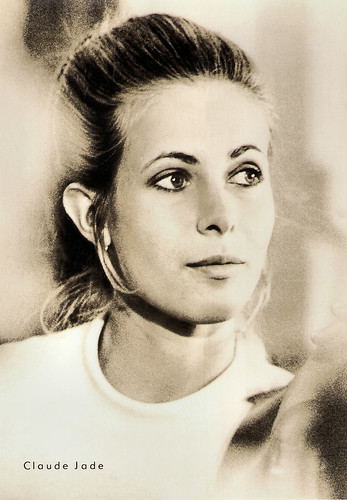
East-German postcard by VEB Progress Filmvertrieb, Berlin, no. 174/71, 1971. Photo: Linke. Claude Jade in Domicile conjugal/Bed & Board (François Truffaut, 1970). For years, Didier Hanson supplied us with many scans of his impressive collection of film star postcards. When he decided to focus on the silent era and especially on the Russian cinema and theatre, he sent us his more modern cards. It was a great gift.
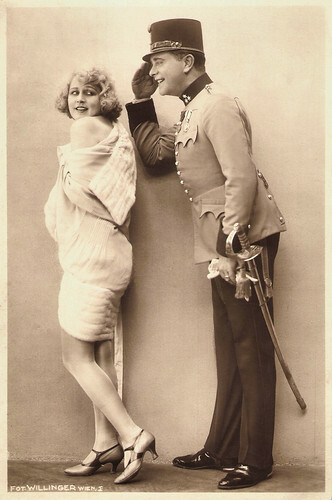
Austrian photo by Willinger, Wien. Xenia Desni and Livio Pavanelli in the German silent film Die letzte Einquartierung aka Küssen ist keine Sünd'/Kissing is no sin (Rudolf Walther-Fein, Rudolf Dworsky, 1926). When we returned from our holidays in Italy in 2014, there was this little parcel from East-Hartford, USA, waiting for us at our neighbour's house. It contained rare postcards, photos and a clipping on the Ukrainian-born silent film star Xenia Desni and her daughter Tamara Desni , who had an impressive film and stage career herself in Great Britain. The postcards were sent to us by a relative of the Desni's, their niece Tatiana. In the past, Tatiana had already sent us some scans of the postcards of Tamara Desni and now she gave us the 39 Ross Verlag postcards, which she had collected as a little girl.
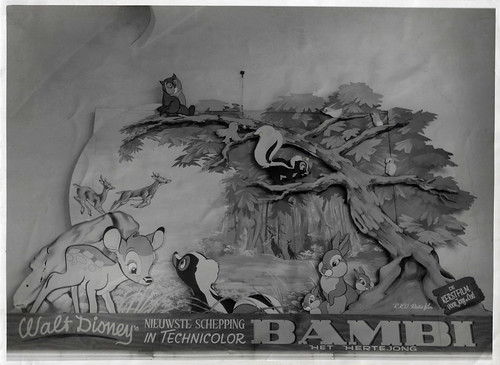
Dutch photo. Dutch publicity for Bambi (David Hand, 1942). The film was shown in Amsterdam in 1948 in three cinemas, Rialto, Nöggerath and Cineac Damrak. A gift by Roloff de Jeu.
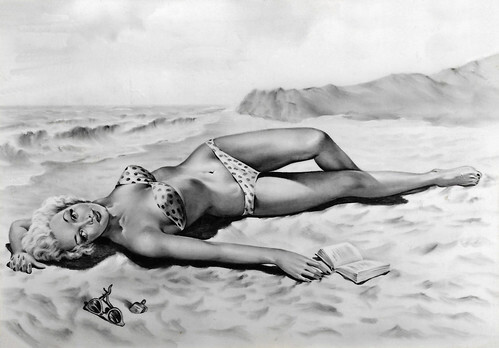
Italian pin-up postcard by Bromostampa, Milano. Sent by mail in 1978 to the late entertainer Klaas ten Holt. It was given to us from his estate by his and our friend Mariët Sieffers.
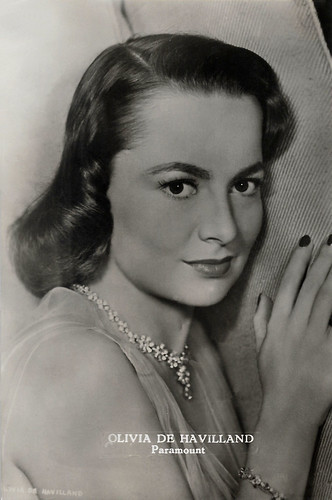
Vintage collectors card. Photo: Paramount. Olivia de Havilland . This card is a gift from my colleague Loek Coenraad from his mother's legacy.
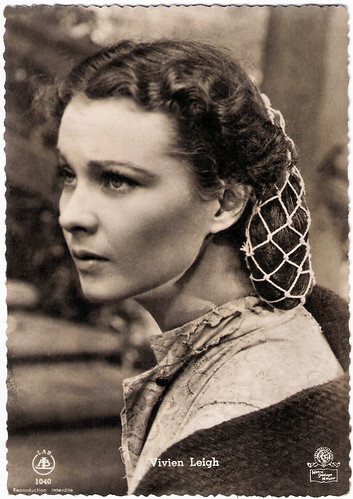
Belgian postcard by Les Editions d'Art L.A.B., Bruxelles (Brussels), no. 1040. Photo: MGM (Metro-Goldwyn-Mayer). Vivien Leigh in Gone With The Wind (1939). This postcard was given to us by Gill4kleuren.
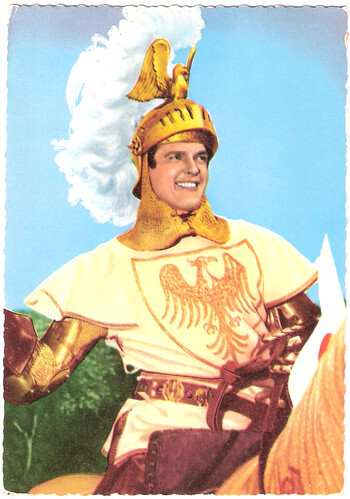
Belgian postcard by S. Best (SB), Antwerpen. Photo: Roger Moore in Ivanhoe. This postcard is a gift from Mary of the A plethora of Postcards blog.
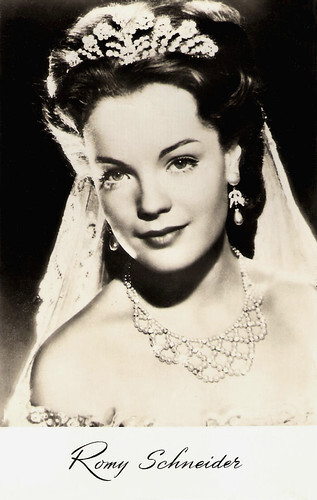
Dutch postcard by Uitg. Takken, Utrecht, no. 3125. Photo: Romy Schneider in Sissi - Die junge Kaiserin/Sissi: The Young Empress (Ernst Marischka, 1956). A gift by our neighbour Cina Roubos, who collected Schneider postcards when she was a young girl and gave her collection to us.
Back to Akkrum
Below are vintage postcards that my Granddad, Hendrik Yntema, once gave me. As a boy, he lived in Akkrum. Akkrum is a village in the province of Frisia in the Netherlands. Hendrik left Akkrum with his family when he was still a young man. They started a new life in Den Haag (The Hague) and he would never return to Akkrum.
All he had of the village were his memories and these postcards. My granddad is dead for many years now and I've always kept his postcards in my collection. In fact, his cards started my collection. In 2010, I visited Akkrum for the first time and compared the postcards with the situation then.
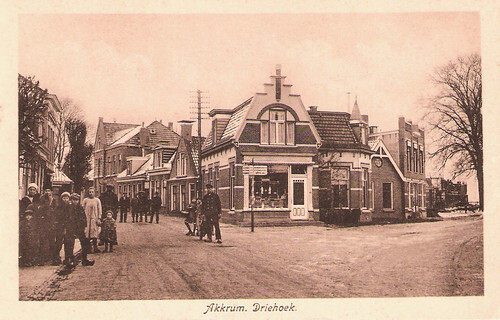
Dutch postcard of De Driehoek (The Triangle), Akkrum, The Netherlands, ca. 1910.
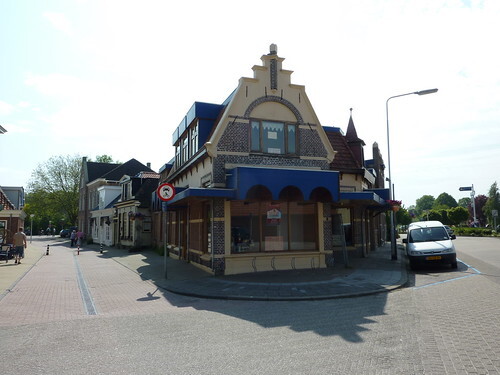
De Driehoek, Akkrum, The Netherlands, 2010. At the left is the Kanadeeske Sjtritte (the Canadian Street) and at the right is the Kleef. The curious building in-between was already there 100 years ago. It's a shop that ws for sale. The owner saw us taking this picture and thought we were interested.
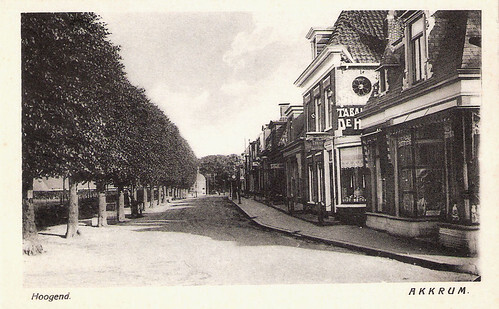
Dutch postcard of Hoogend (now: Heechein), Akkrum, The Netherlands. Hoogend was the High Street of Akkrum. Just outside of the view were the two churches (right the Mennonist Church; left the Dutch Protestant Church). We see shops and trees, and a small building with a cupola at the end of the street.

Streetview Heechein, Akkrum, The Netherlands. The shop buildings at the right are still there. We were in Akkrum on a hot Sunday. That's probably why the High Street was so quiet.
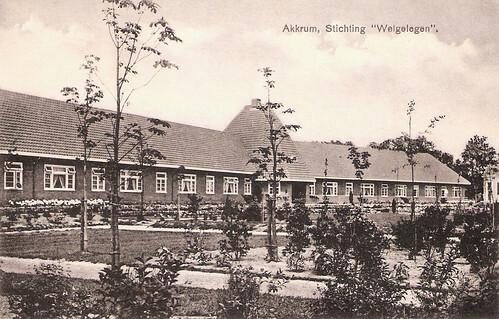
Vintage postcard of Welgelegen, Hoogend, Akkrum, The Netherlands. At the far right you can see the cupola buiding at the Hoogend. It was an 18th Century teahouse, part of a private garden called Welgelegen (well located). In 1924 the owner, ms. Suster van der Vegt, left all her riches to the foundation Welgelegen. The foundation modernized the garden and build this beautiful house for single ladies from the Frisian bourgeoisie. The house opened in 1929 and this postcard dates probably from that year.
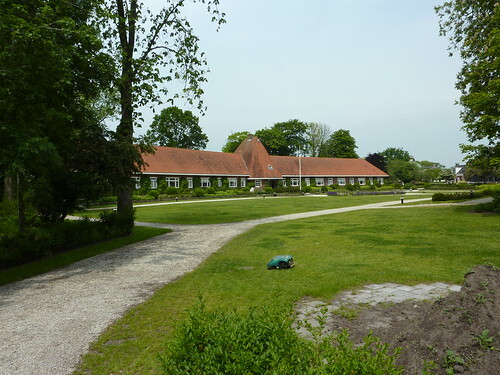
Stichting Welgelegen, Adam Hurdriderstrjitte 13, 8491 DR Akkrum, The Netherlands. We were fascinated by the green, automatic lawn mowers. A futuristic detail in this historical village.
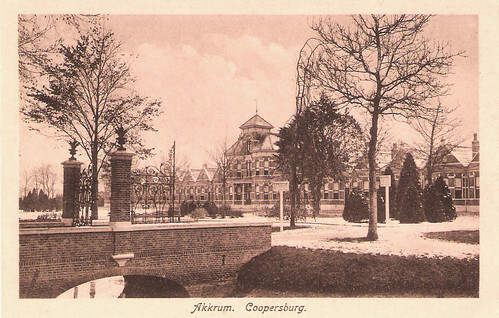
Vintage postcard of Coopersburg, Hoogend, Akkrum, The Netherlands. Coopersburg contained 22 small houses for married couples of at least 60 years old. They had their own living quarters and also a small kitchen to prepare their meals. The residents even received a weekly sum of money, unheard of in those days. Coopersburg has a beautiful garden with a pool with carps and a sundial, a mausoleum for Kuypers and his wife, and a governor's room.

Coopersburg, Ljouwerterdyk, Akkrum, The Netherlands. In 1980 Coopersburg was no longer suitable as an old people's home. Today Coopersburg houses young and old, singles and small households.
You can see more postcards and pictures in my Back to Akkrum album at Flickr.

French postcard by Editions La Malibran, Paris, no. CF 23, 1990. Gérard Philipe and Micheline Presle in Le Diable au corps/Devil in the Flesh (Claude Autant-Lara, 1947). This postcard was sent years ago to me by my partner at EFSP and in life, Ivo Blom.

Spanish postcard by Productos Compactos, S.A., no. B-3768, 1991. Paul Newman . This card was a gift to me by my other EFSP pal, Marlene Pilaete. She gave it o me when we met for drinks at the VerzamelaarsJaarbeurs 2022 in Utrecht.

Dutch postcard by N.V. Grammofoonplatenmaatschappij CNR, Leiden. Photo: Barclay / Ariola. This postcard of Mireille Mathieu was donated to us by the Conradi family. My collague Susanne Conradi told me that her mother used to be a big fan of Mireille.

German postcard by Das Programm von Heute für Film und Theater / Ross Verlag, Berlin. Photo: Böhm-Willott, Berlin. Gerda Maurus . A collection of old German postcards was given to us by our Flickr connection Miss Mertens.

East-German postcard by VEB Progress Filmvertrieb, Berlin, no. 174/71, 1971. Photo: Linke. Claude Jade in Domicile conjugal/Bed & Board (François Truffaut, 1970). For years, Didier Hanson supplied us with many scans of his impressive collection of film star postcards. When he decided to focus on the silent era and especially on the Russian cinema and theatre, he sent us his more modern cards. It was a great gift.

Austrian photo by Willinger, Wien. Xenia Desni and Livio Pavanelli in the German silent film Die letzte Einquartierung aka Küssen ist keine Sünd'/Kissing is no sin (Rudolf Walther-Fein, Rudolf Dworsky, 1926). When we returned from our holidays in Italy in 2014, there was this little parcel from East-Hartford, USA, waiting for us at our neighbour's house. It contained rare postcards, photos and a clipping on the Ukrainian-born silent film star Xenia Desni and her daughter Tamara Desni , who had an impressive film and stage career herself in Great Britain. The postcards were sent to us by a relative of the Desni's, their niece Tatiana. In the past, Tatiana had already sent us some scans of the postcards of Tamara Desni and now she gave us the 39 Ross Verlag postcards, which she had collected as a little girl.

Dutch photo. Dutch publicity for Bambi (David Hand, 1942). The film was shown in Amsterdam in 1948 in three cinemas, Rialto, Nöggerath and Cineac Damrak. A gift by Roloff de Jeu.

Italian pin-up postcard by Bromostampa, Milano. Sent by mail in 1978 to the late entertainer Klaas ten Holt. It was given to us from his estate by his and our friend Mariët Sieffers.

Vintage collectors card. Photo: Paramount. Olivia de Havilland . This card is a gift from my colleague Loek Coenraad from his mother's legacy.

Belgian postcard by Les Editions d'Art L.A.B., Bruxelles (Brussels), no. 1040. Photo: MGM (Metro-Goldwyn-Mayer). Vivien Leigh in Gone With The Wind (1939). This postcard was given to us by Gill4kleuren.

Belgian postcard by S. Best (SB), Antwerpen. Photo: Roger Moore in Ivanhoe. This postcard is a gift from Mary of the A plethora of Postcards blog.

Dutch postcard by Uitg. Takken, Utrecht, no. 3125. Photo: Romy Schneider in Sissi - Die junge Kaiserin/Sissi: The Young Empress (Ernst Marischka, 1956). A gift by our neighbour Cina Roubos, who collected Schneider postcards when she was a young girl and gave her collection to us.
Back to Akkrum
Below are vintage postcards that my Granddad, Hendrik Yntema, once gave me. As a boy, he lived in Akkrum. Akkrum is a village in the province of Frisia in the Netherlands. Hendrik left Akkrum with his family when he was still a young man. They started a new life in Den Haag (The Hague) and he would never return to Akkrum.
All he had of the village were his memories and these postcards. My granddad is dead for many years now and I've always kept his postcards in my collection. In fact, his cards started my collection. In 2010, I visited Akkrum for the first time and compared the postcards with the situation then.

Dutch postcard of De Driehoek (The Triangle), Akkrum, The Netherlands, ca. 1910.

De Driehoek, Akkrum, The Netherlands, 2010. At the left is the Kanadeeske Sjtritte (the Canadian Street) and at the right is the Kleef. The curious building in-between was already there 100 years ago. It's a shop that ws for sale. The owner saw us taking this picture and thought we were interested.

Dutch postcard of Hoogend (now: Heechein), Akkrum, The Netherlands. Hoogend was the High Street of Akkrum. Just outside of the view were the two churches (right the Mennonist Church; left the Dutch Protestant Church). We see shops and trees, and a small building with a cupola at the end of the street.

Streetview Heechein, Akkrum, The Netherlands. The shop buildings at the right are still there. We were in Akkrum on a hot Sunday. That's probably why the High Street was so quiet.

Vintage postcard of Welgelegen, Hoogend, Akkrum, The Netherlands. At the far right you can see the cupola buiding at the Hoogend. It was an 18th Century teahouse, part of a private garden called Welgelegen (well located). In 1924 the owner, ms. Suster van der Vegt, left all her riches to the foundation Welgelegen. The foundation modernized the garden and build this beautiful house for single ladies from the Frisian bourgeoisie. The house opened in 1929 and this postcard dates probably from that year.

Stichting Welgelegen, Adam Hurdriderstrjitte 13, 8491 DR Akkrum, The Netherlands. We were fascinated by the green, automatic lawn mowers. A futuristic detail in this historical village.

Vintage postcard of Coopersburg, Hoogend, Akkrum, The Netherlands. Coopersburg contained 22 small houses for married couples of at least 60 years old. They had their own living quarters and also a small kitchen to prepare their meals. The residents even received a weekly sum of money, unheard of in those days. Coopersburg has a beautiful garden with a pool with carps and a sundial, a mausoleum for Kuypers and his wife, and a governor's room.

Coopersburg, Ljouwerterdyk, Akkrum, The Netherlands. In 1980 Coopersburg was no longer suitable as an old people's home. Today Coopersburg houses young and old, singles and small households.
You can see more postcards and pictures in my Back to Akkrum album at Flickr.
Published on September 23, 2022 22:00
September 22, 2022
Carmen Miranda
Flamboyant Brazilian dancer, singer and actress Carmen Miranda (1909-1955) taught the world how to samba dance. Popular from the 1930s to the 1950s in Brazil and Hollywood, Miranda's most famous songs include 'Tico Tico', 'South American Way', 'Chica Chica Boom Chic', 'Rebola a Bola' and 'I Yi Yi Yi Yi'. She was famous for her exotic outfits featuring a hat decorated with fruit and her tall platform sandals. The peak of her career was during the war years when she starred in eight of her fourteen films. As Miranda became famous around the world her trademark fruit basket went with her, morphing into a range of exuberant and colourful headdresses.

Canadian postcard by the American Postcard Co., no. 1123. Photo: The Gerald Mastroli Collection. Carmen Miranda in Copacabana (Alfred E. Green, 1947).

Italian postcard by Rotalfoto, Milano / Ediz. Garami, no. 129. Photo: Bruno of Hollywood. Carmen Miranda in Down Argentine Way (Irving Cummings, 1940).

Dutch card. Photo: 20th Century Fox. Carmen Miranda and Bando da Lua in Doll Face (Lewis Seiler, 1945).
A fruit-filled turban
Carmen Miranda was born Maria do Carmo Miranda da Cunha in Várzea da Ovelha e Aliviada, a village in the northern Portuguese municipality of Marco de Canaveses in 1909. One of six children, Miranda was named after Georges Bizet's opera 'Carmen', reflecting her father's love of the art.
She moved to Brazil when she was less than two years old to join her father who had set up a barber's shop. Her early artistic roots set her on a path to being a world-renowned musician and dancer. She began performing at an early age and at 20 years old she released her first album.
Miranda's early work was inspired by 'baianas', the Afro-Brazilian fruit vendors she regularly saw during her childhood in Rio de Janeiro. It was working at a hat store that she first discovered her musical talent, which was strongly influenced by the samba music that played throughout the city's favelas. Channelling these influences, Miranda one day decided to don a headdress in the form of a fruit-filled turban inspired by the traditional headdress seen on black women fruit sellers.
Miranda’s big break happened following her performance at the National Institute of Music. She landed an audition at a recording studio where she was immediately signed to put out a single. Miranda’s first album was released in 1929 and was immensely popular among Brazilians. Her performing style helped samba gain respect and a place in the Brazilian (and later, the world) spotlight.
Carmen Miranda made her film debut in the Brazilian documentary A Voz do Carnaval/The Voice of Carnival (Adhemar Gonzaga, Humberto Mauro, 1933). The film includes comic sketches and musical numbers with some of the most popular Brazilian stars and Carmen sang 'Good-bye' and 'Moleque Indigesto' at the studio of Rádio Mayrink Veiga. Two years later she appeared in her first feature film, Alô, Alô, Brasil/Hello, Hello Brazil (João de Barro, Wallace Downey, Alberto Ribeiro, 1935).
However, it was Estudantes/Students (Wallace Downey, 1935) that seemed to solidify Carmen in the minds of the Brazilian film audiences. Now they realised she could act as well as sing. Although there were three years between Alô Alô Carnaval (Adhemar Gonzaga, 1936) and Banana-da-Terra/Banana (Ruy Costa, 1939), Carmen continued to churn out musical hits in Brazil. The latter film would be the last in her home country.
By the time Carmen Miranda moved to the United States in 1939, she was a national star in Brazil. American producer Lee Shubert saw her act in Brazil and offered her a spot on his new Broadway revue 'The Streets of Paris' (1939). Knowing the need for a real Brazilian band to keep the appropriate music true, she insisted that her backup band be included in the deal. With the help of the Brazilian government which saw a good national image opportunity in Carmen, her demand was met.

American postcard by Classico, San Francisco, no. 136-109. Photo: 20th Century Fox / The Ludlow Collection. Carmen Miranda in The Gang's All Here (Busby Berkeley, 1943).
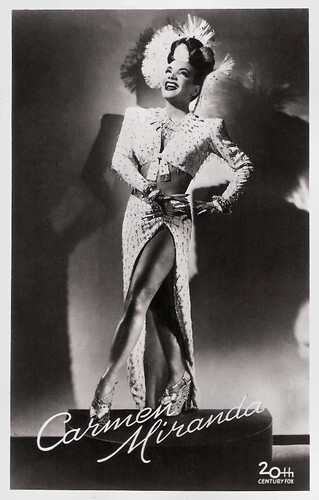
Dutch card by Takken 't Sticht, no. 3534. Photo: 20th Century Fox. Sent by mail in 1950. Carmen Miranda in If I'm Lucky (Lewis Seiler, 1946).
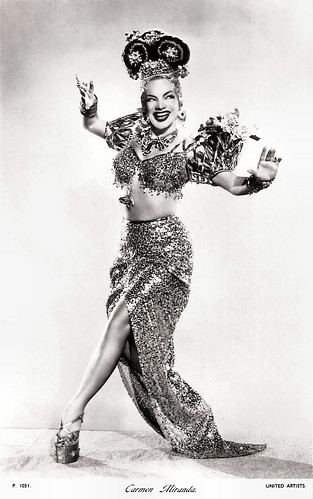
British postcard in 'The People' series by Show Parade Picture Service, London, no. P. 1051. Photo: Virgil Apger / United Artists. Carmen Miranda in Copacabana (Alfred E. Green, 1947).
A visual candy box of Technicolor treats
In late 1939 Carmen Miranda arrived, with much fanfare in the press, in New York City. She was now ready to capture Americans' hearts with her talent. She appeared in some musical revues on Broadway and, just as everyone thought, was a huge hit.
In 1940 Carmen was signed to appear in the Twentieth Century-Fox production Down Argentine Way (Irving Cummings, 1940), with Betty Grable and Don Ameche. The only complaint that critics had was the fact that Carmen was not on the screen enough. Hal Erickson at AllMovie : "She was signed to a long-term 20th Century-Fox contract in 1940, which proved a wise move when World War II dried up the European movie market, leaving South America as practically the only foreign outlet for Hollywood films."
In 1941 she was, again, teamed with Ameche in addition to Alice Faye in A Night in Rio (Irving Cummings, 1941). The film was extremely popular with the theatre patrons. Her unique songs went a long way in making her popular. Hollywood's famous Grauman's Chinese Theatre invited her to leave her hand prints in the cement in 1941, the first Latin American to do so. It was after Week-End in Havana (Walter Lang, 1941) that American cartoon artists began to cash in on Carmen's ever-growing popularity.
In the 1930s and 1940s cartoons were sometimes shown as a prelude to whatever feature film was showing. Sure enough, the cartoon version of Carmen came wriggling across the screen, complete with her trademark fruit hat and wide, toothy grin. In 1942 Carmen starred in Springtime in the Rockies (Irving Cummings, 1942) with Betty Grable and Cesar Romero, both of whom she had worked with before.
It was shortly after this that America began adopting her style of dress as the latest fad. The most outrageous of her musicals was The Gang's All Here (Busby Berkeley, 1943), which Catherine A. Surowiec in the catalogue of Il Cinema Ritrovato 2006 describes as "a visual candy box of Technicolor treats": "Camera-boom-riding choreographic genius Busby Berkeley was given full rein to weave his magic in full 3-strip technicolor for the first time and he pulled out all the stops. The film contains two of his most spectacular, surreal production numbers: the fabulous camp-classic 'The Lady in the Tutti Frutti Hat' (Carmen Miranda and chorus girls literally go bananas!) which for obvious reasons set censors in a spin, and the film's epic kaleidoscopic finale, a triumph of special photographic effects".
Bruce Eder adds at All Movie : "the film keeps us moving, laughing, and humming, and also tapping our feet to the beat of Benny Goodman's orchestra. Berkeley's use of special effects in the service of dance is extraordinary -- gravity seems to disappear at various points, strange, unearthly rings surround performers in mid-air, and nightclubs interiors suddenly lose their walls and ceilings and even their stages, which suddenly become bigger than any building that they could seemingly ever contain them."
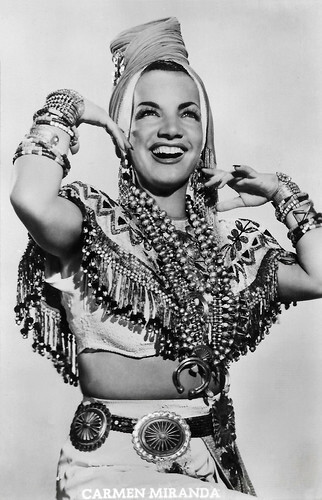
Dutch postcard by Van Leer's Fotodrukindustrie N.V., Amsterdam, no. 1250. Photo: R.K.O.. Carmen Miranda in Springtime in the Rockies (Irving Cummings, 1942).
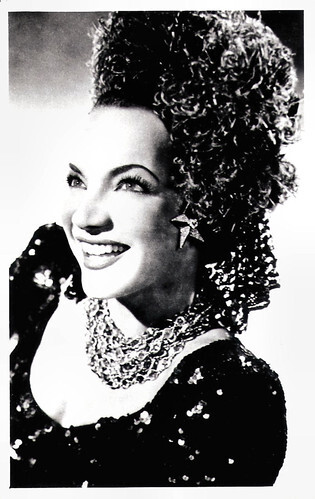
Vintage card. Carmen Miranda in Doll Face (Lewis Seiler, 1945).
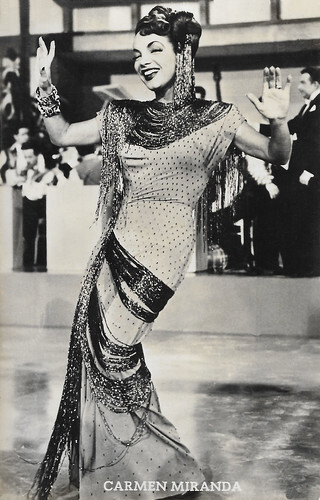
Dutch postcard. Photo: 20th Century Fox. Carmen Miranda in A Date with Judy (Richard Thorpe, 1948).
An abusive and opportunistic brute who made Carmen's life hell
1944 saw Carmen Miranda in three films: Something for the Boys (Lewis Seiler, 1944), Four Jills in a Jeep (William A. Seiter, 1944) and Greenwich Village (Walter Lang, 1944). Denny Jackson at IMDb : "The first two did well at the box office, but the last one left a lot to be desired. It was her last busy year in film.
Carmen made one film each in 1945, '46, '47 and '48. After that, she didn't make a film for two years, until Nancy Goes to Rio (Robert Z. Leonard, 1950), a production for MGM. Once again she didn't make a film for several years, returning with Scared Stiff (George Marshall, 1953)." The studios labelled her the "Brazilian Bombshell", but the films tended to blur her Brazilian identity in favour of a generalised Latin American image.
She did stay busy, singing on the nightclub circuit and appearing on the relatively new medium of television. In 1947, Carmen married film producer David Sebastian. Kenneth Chisholm at IMDb : "He proved to be an abusive and opportunistic brute who made Carmen's life hell. Yet Carmen was a good Catholic and never considered divorce. Instead, she kept up a gruelling schedule of shows, taking uppers and downers to remain functional, even when they began to damage her health. Eventually, she collapsed and her doctor ordered her to go back to Brazil. She recovered and returned to America to resume the grind."
Off-screen, Miranda was a talented sketch artist and costume designer; she was also very active in charitable work, seeing to it that a generous percentage of her earnings were sent to the destitute in South America.
On 4 August 1955, Carmen Miranda suffered a heart attack, although she didn't realize it at the time, during an episode of The Jimmy Durante Show (1954-1956). She went home after attending a party. Early the next morning, on 5 August 1955, Carmen suffered a fatal heart attack. She was just 46 years old. Her body was flown to her adopted country of Brazil, where her death was declared a period of national mourning. The actress' memory is kept alive by the Carmen Miranda Museum in Rio De Janeiro.
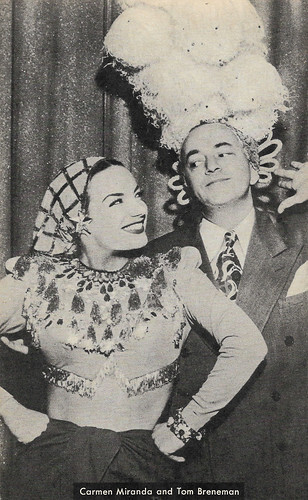
American postcard. Carmen Miranda at the morning radio show 'Breakfast in Hollywood' (1945), created and hosted by Tom Breneman.
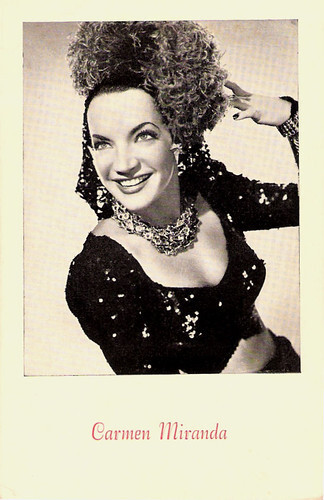
Dutch postcard. Carmen Miranda in Doll Face (Lewis Seiler, 1945).
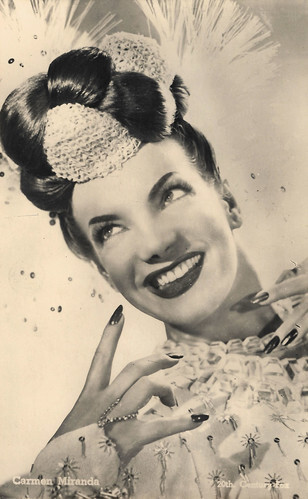
Dutch postcard by MPEA. Photo: 20th Century Fox.
Sources: (IMDb), Catherine A. Surowiec (Cinema Ritrovato 2006), Hal Erickson (AllMovie), Bruce Eder (AllMovie), (IMDb), Telegraph, Wikipedia (Dutch) and .

Canadian postcard by the American Postcard Co., no. 1123. Photo: The Gerald Mastroli Collection. Carmen Miranda in Copacabana (Alfred E. Green, 1947).

Italian postcard by Rotalfoto, Milano / Ediz. Garami, no. 129. Photo: Bruno of Hollywood. Carmen Miranda in Down Argentine Way (Irving Cummings, 1940).

Dutch card. Photo: 20th Century Fox. Carmen Miranda and Bando da Lua in Doll Face (Lewis Seiler, 1945).
A fruit-filled turban
Carmen Miranda was born Maria do Carmo Miranda da Cunha in Várzea da Ovelha e Aliviada, a village in the northern Portuguese municipality of Marco de Canaveses in 1909. One of six children, Miranda was named after Georges Bizet's opera 'Carmen', reflecting her father's love of the art.
She moved to Brazil when she was less than two years old to join her father who had set up a barber's shop. Her early artistic roots set her on a path to being a world-renowned musician and dancer. She began performing at an early age and at 20 years old she released her first album.
Miranda's early work was inspired by 'baianas', the Afro-Brazilian fruit vendors she regularly saw during her childhood in Rio de Janeiro. It was working at a hat store that she first discovered her musical talent, which was strongly influenced by the samba music that played throughout the city's favelas. Channelling these influences, Miranda one day decided to don a headdress in the form of a fruit-filled turban inspired by the traditional headdress seen on black women fruit sellers.
Miranda’s big break happened following her performance at the National Institute of Music. She landed an audition at a recording studio where she was immediately signed to put out a single. Miranda’s first album was released in 1929 and was immensely popular among Brazilians. Her performing style helped samba gain respect and a place in the Brazilian (and later, the world) spotlight.
Carmen Miranda made her film debut in the Brazilian documentary A Voz do Carnaval/The Voice of Carnival (Adhemar Gonzaga, Humberto Mauro, 1933). The film includes comic sketches and musical numbers with some of the most popular Brazilian stars and Carmen sang 'Good-bye' and 'Moleque Indigesto' at the studio of Rádio Mayrink Veiga. Two years later she appeared in her first feature film, Alô, Alô, Brasil/Hello, Hello Brazil (João de Barro, Wallace Downey, Alberto Ribeiro, 1935).
However, it was Estudantes/Students (Wallace Downey, 1935) that seemed to solidify Carmen in the minds of the Brazilian film audiences. Now they realised she could act as well as sing. Although there were three years between Alô Alô Carnaval (Adhemar Gonzaga, 1936) and Banana-da-Terra/Banana (Ruy Costa, 1939), Carmen continued to churn out musical hits in Brazil. The latter film would be the last in her home country.
By the time Carmen Miranda moved to the United States in 1939, she was a national star in Brazil. American producer Lee Shubert saw her act in Brazil and offered her a spot on his new Broadway revue 'The Streets of Paris' (1939). Knowing the need for a real Brazilian band to keep the appropriate music true, she insisted that her backup band be included in the deal. With the help of the Brazilian government which saw a good national image opportunity in Carmen, her demand was met.

American postcard by Classico, San Francisco, no. 136-109. Photo: 20th Century Fox / The Ludlow Collection. Carmen Miranda in The Gang's All Here (Busby Berkeley, 1943).

Dutch card by Takken 't Sticht, no. 3534. Photo: 20th Century Fox. Sent by mail in 1950. Carmen Miranda in If I'm Lucky (Lewis Seiler, 1946).

British postcard in 'The People' series by Show Parade Picture Service, London, no. P. 1051. Photo: Virgil Apger / United Artists. Carmen Miranda in Copacabana (Alfred E. Green, 1947).
A visual candy box of Technicolor treats
In late 1939 Carmen Miranda arrived, with much fanfare in the press, in New York City. She was now ready to capture Americans' hearts with her talent. She appeared in some musical revues on Broadway and, just as everyone thought, was a huge hit.
In 1940 Carmen was signed to appear in the Twentieth Century-Fox production Down Argentine Way (Irving Cummings, 1940), with Betty Grable and Don Ameche. The only complaint that critics had was the fact that Carmen was not on the screen enough. Hal Erickson at AllMovie : "She was signed to a long-term 20th Century-Fox contract in 1940, which proved a wise move when World War II dried up the European movie market, leaving South America as practically the only foreign outlet for Hollywood films."
In 1941 she was, again, teamed with Ameche in addition to Alice Faye in A Night in Rio (Irving Cummings, 1941). The film was extremely popular with the theatre patrons. Her unique songs went a long way in making her popular. Hollywood's famous Grauman's Chinese Theatre invited her to leave her hand prints in the cement in 1941, the first Latin American to do so. It was after Week-End in Havana (Walter Lang, 1941) that American cartoon artists began to cash in on Carmen's ever-growing popularity.
In the 1930s and 1940s cartoons were sometimes shown as a prelude to whatever feature film was showing. Sure enough, the cartoon version of Carmen came wriggling across the screen, complete with her trademark fruit hat and wide, toothy grin. In 1942 Carmen starred in Springtime in the Rockies (Irving Cummings, 1942) with Betty Grable and Cesar Romero, both of whom she had worked with before.
It was shortly after this that America began adopting her style of dress as the latest fad. The most outrageous of her musicals was The Gang's All Here (Busby Berkeley, 1943), which Catherine A. Surowiec in the catalogue of Il Cinema Ritrovato 2006 describes as "a visual candy box of Technicolor treats": "Camera-boom-riding choreographic genius Busby Berkeley was given full rein to weave his magic in full 3-strip technicolor for the first time and he pulled out all the stops. The film contains two of his most spectacular, surreal production numbers: the fabulous camp-classic 'The Lady in the Tutti Frutti Hat' (Carmen Miranda and chorus girls literally go bananas!) which for obvious reasons set censors in a spin, and the film's epic kaleidoscopic finale, a triumph of special photographic effects".
Bruce Eder adds at All Movie : "the film keeps us moving, laughing, and humming, and also tapping our feet to the beat of Benny Goodman's orchestra. Berkeley's use of special effects in the service of dance is extraordinary -- gravity seems to disappear at various points, strange, unearthly rings surround performers in mid-air, and nightclubs interiors suddenly lose their walls and ceilings and even their stages, which suddenly become bigger than any building that they could seemingly ever contain them."

Dutch postcard by Van Leer's Fotodrukindustrie N.V., Amsterdam, no. 1250. Photo: R.K.O.. Carmen Miranda in Springtime in the Rockies (Irving Cummings, 1942).

Vintage card. Carmen Miranda in Doll Face (Lewis Seiler, 1945).

Dutch postcard. Photo: 20th Century Fox. Carmen Miranda in A Date with Judy (Richard Thorpe, 1948).
An abusive and opportunistic brute who made Carmen's life hell
1944 saw Carmen Miranda in three films: Something for the Boys (Lewis Seiler, 1944), Four Jills in a Jeep (William A. Seiter, 1944) and Greenwich Village (Walter Lang, 1944). Denny Jackson at IMDb : "The first two did well at the box office, but the last one left a lot to be desired. It was her last busy year in film.
Carmen made one film each in 1945, '46, '47 and '48. After that, she didn't make a film for two years, until Nancy Goes to Rio (Robert Z. Leonard, 1950), a production for MGM. Once again she didn't make a film for several years, returning with Scared Stiff (George Marshall, 1953)." The studios labelled her the "Brazilian Bombshell", but the films tended to blur her Brazilian identity in favour of a generalised Latin American image.
She did stay busy, singing on the nightclub circuit and appearing on the relatively new medium of television. In 1947, Carmen married film producer David Sebastian. Kenneth Chisholm at IMDb : "He proved to be an abusive and opportunistic brute who made Carmen's life hell. Yet Carmen was a good Catholic and never considered divorce. Instead, she kept up a gruelling schedule of shows, taking uppers and downers to remain functional, even when they began to damage her health. Eventually, she collapsed and her doctor ordered her to go back to Brazil. She recovered and returned to America to resume the grind."
Off-screen, Miranda was a talented sketch artist and costume designer; she was also very active in charitable work, seeing to it that a generous percentage of her earnings were sent to the destitute in South America.
On 4 August 1955, Carmen Miranda suffered a heart attack, although she didn't realize it at the time, during an episode of The Jimmy Durante Show (1954-1956). She went home after attending a party. Early the next morning, on 5 August 1955, Carmen suffered a fatal heart attack. She was just 46 years old. Her body was flown to her adopted country of Brazil, where her death was declared a period of national mourning. The actress' memory is kept alive by the Carmen Miranda Museum in Rio De Janeiro.

American postcard. Carmen Miranda at the morning radio show 'Breakfast in Hollywood' (1945), created and hosted by Tom Breneman.

Dutch postcard. Carmen Miranda in Doll Face (Lewis Seiler, 1945).

Dutch postcard by MPEA. Photo: 20th Century Fox.
Sources: (IMDb), Catherine A. Surowiec (Cinema Ritrovato 2006), Hal Erickson (AllMovie), Bruce Eder (AllMovie), (IMDb), Telegraph, Wikipedia (Dutch) and .
Published on September 22, 2022 22:00
Paul van Yperen's Blog
- Paul van Yperen's profile
- 13 followers
Paul van Yperen isn't a Goodreads Author
(yet),
but they
do have a blog,
so here are some recent posts imported from
their feed.



